BUTTERFLY CONSERVATION IRELAND ANNUAL REPORT 2023
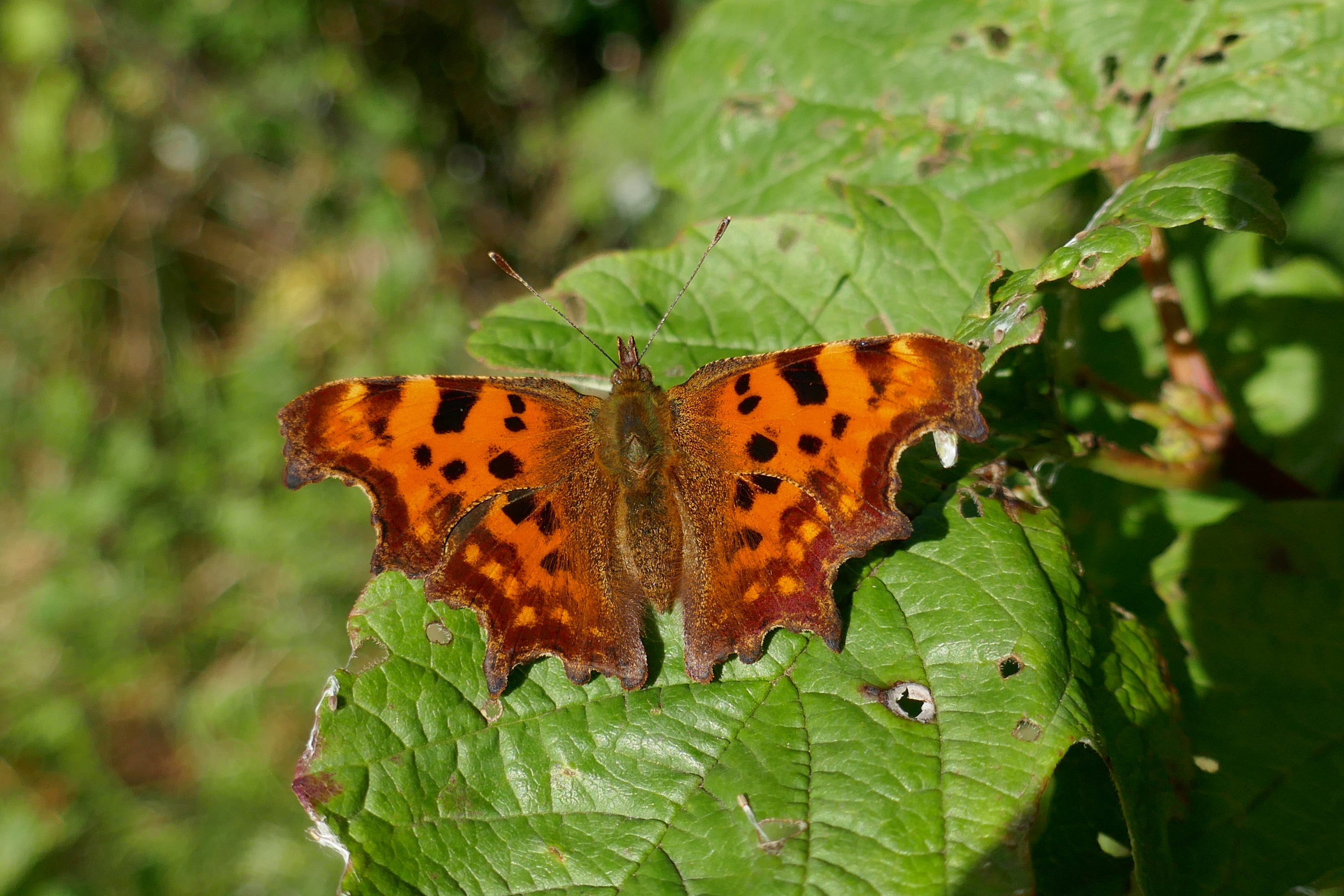 The Comma enjoyed abundance in 2023. Photo © J. Harding
The Comma enjoyed abundance in 2023. Photo © J. Harding
CONTENTS
• Introduction
• Overseas Butterfly Odyssey
• Butterfly Season Report 2023
• Events Report
• Crabtree Nature Reserve Report
• Conservation News
• Garden Survey Report
• Meet the Burnets
• Species Focus: Speckled Wood
• Why are Ireland’s Butterflies Declining?
INTRODUCTION
Dear Butterfly Conservation Ireland Member,
Welcome to Butterfly Conservation Ireland’s Annual Report 2023. The year had beautiful sunny weather in May and June but July and August had many wet days. September had the only heatwave of 2023 while October was mild but wet. Given the generally unfavourable weather in spring and in most of the summer one might expect our butterfly populations to have shown declines, but this a was surprisingly good year, which you can read about in the Butterfly Season Report. Our reserves performed well thanks to your support and hard work put in by our volunteers and friends. Our small staff is fortunate to have excellent support from our active membership whenever help is needed in these endeavours. Butterfly Conservation Ireland’s membership grew again in 2023, reflecting perhaps the growing concern for the environment and owing to the increased interest in nature that arose when the coronavirus pandemic restricted movement and people took more time to observe nature.
Your continued practical and financial support is greatly appreciated as we strive to ensure that our butterflies and moths continue to have an important voice for their conservation. We pursue the conservation agenda at every opportunity with many submissions to government bodies concerning our habitats. Our recording scheme continues to provide important quantitative and qualitative data; let’s see if we can maintain this in 2024. A huge amount of work was done on the Atlas of Ireland’s Butterflies 2010-2021, and we hope to see this in print in 2024. Our financial accounts were approved thanks are due to our joint treasurers Michael Jacob and Joseph Harding. Thanks are due to Richella Duggan, Jim Fitzharris and Pat Bell for their help in editing this report and to all our members and supporters. We hope that you enjoy reading our Annual Report and we look forward to hearing from you in 2024.
Yours in nature,
Jesmond Harding (Secretary)
Butterfly Conservation Ireland,
Butterfly House,
Pagestown,
Maynooth,
County Kildare.
OVERSEAS BUTTERFLY ODYSSEY
By Jim Fitzharris
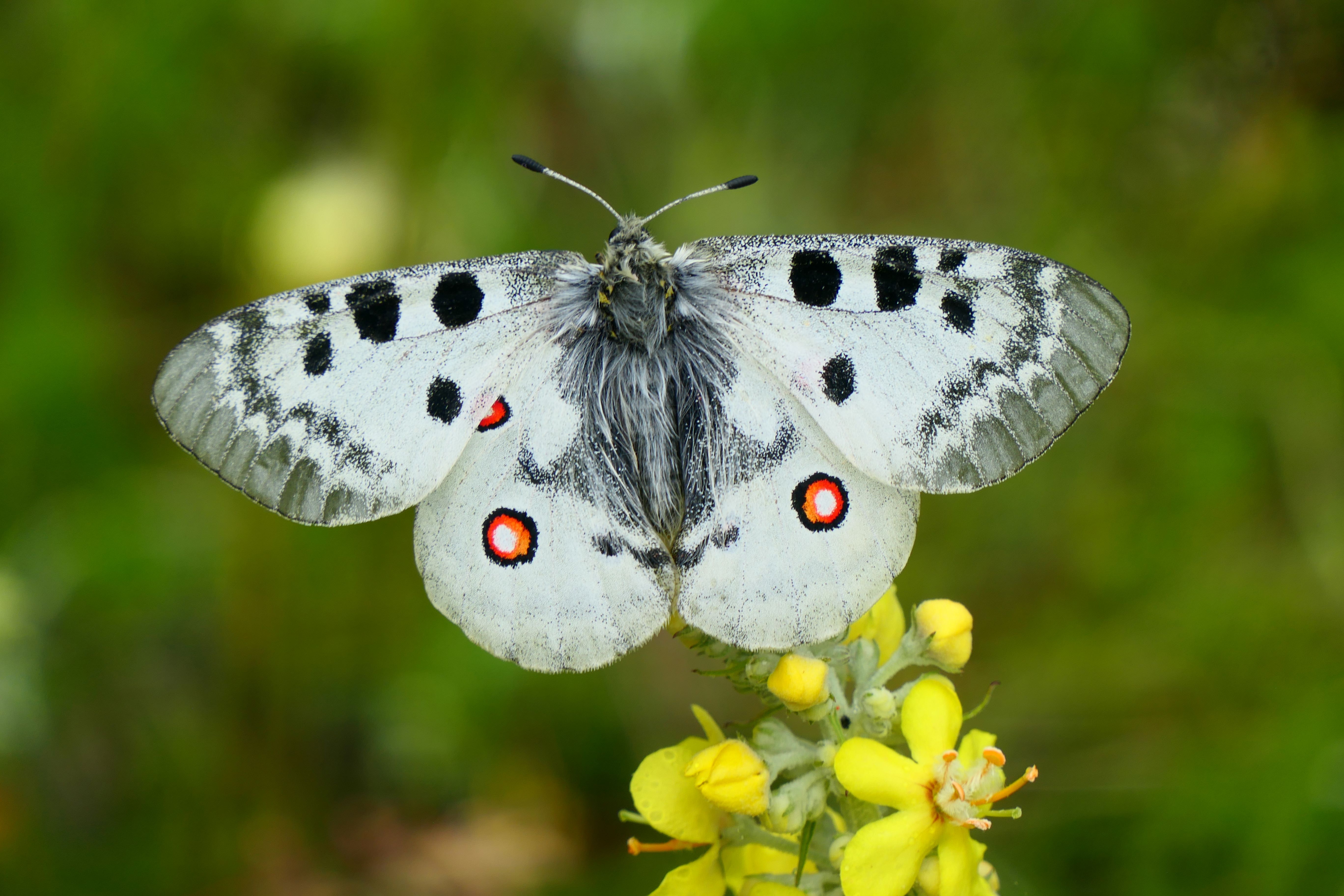 Apollo butterfly, Italy.
Apollo butterfly, Italy.
Irish butterfly observers will be well aware that while we have a lovely selection of butterflies in this country, given our temperate, maritime climate, the level of diversity is quite low. There are 35 regular resident and migrant species in Ireland: this compares to some 60 in Britain, while Europe as a whole has around 450 species, with the larger southern European countries each boasting lists of over 200 species.
I am sure that like most Irish people, butterfly enthusiasts regularly go abroad on holidays and/or business. No doubt, many would notice and look at any butterflies that they encounter. I must confess that, although I have been on many foreign holidays, until recently I have been remiss in not paying attention to butterflies but concentrating instead on birds and wildflowers. Following my resurgent interest in Irish butterflies, I finally decided it was high time to rectify this omission a couple of years ago.
When I first got hold of my first European butterfly guide, I was curious to see what gave rise to the much greater diversity on the continent. While some of it was accounted for by relatively exotic and unusual species, most of it could be accounted for by the much greater numbers in familiar groups and families. For example, in Ireland, we have three Blues; this compares with nine in Britain and over 80 in Europe! A similar pattern prevails with groups such as Skippers, Coppers, Hairstreaks, Fritillaries and Ringlets, to name a few.
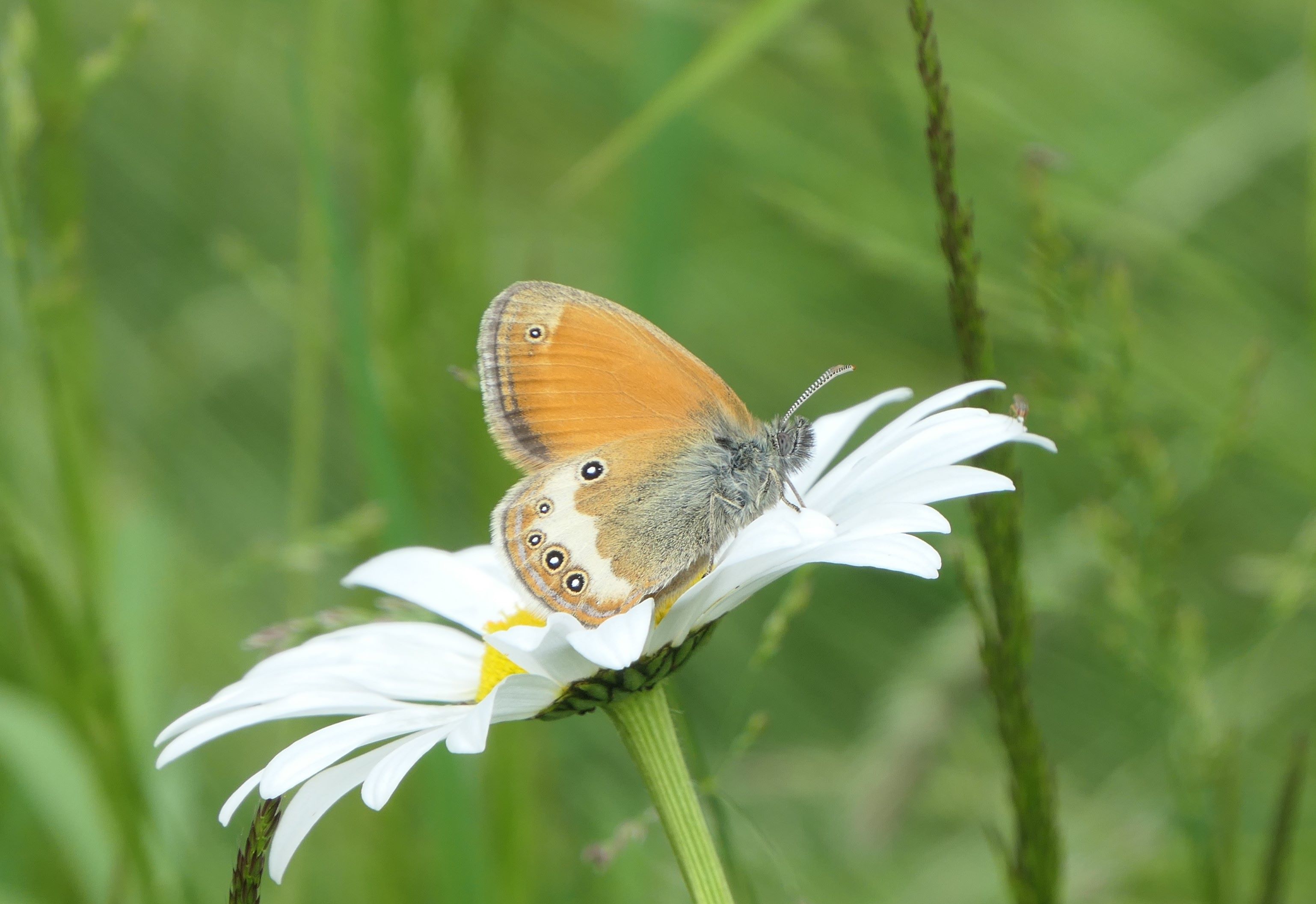
Pearly Heath-Italy
Apart from latitude, the other major determinant of butterfly diversity is a large altitudinal range. The greatest diversity of butterfly species occurs in montane regions, especially in places like the Alps and Pyrenees. As one ascends the mountains, there are different habitats and the species composition changes. We must also remember that while many lowland areas have been transformed by development, urbanisation and agriculture, many areas in the mountains remain relatively untouched and thus preserve their species diversity.
Anyway, to get the ball rolling, in 2022 I joined an organised butterfly tour to northeast Turkey, specifically the Kaçkars mountains which form part of the foothills of the mighty Caucasus range. Turkey as a whole has a butterfly list of around 380 and the north-east part of the country is a noted biodiversity hot spot. I had signed up for a baptism of fire!
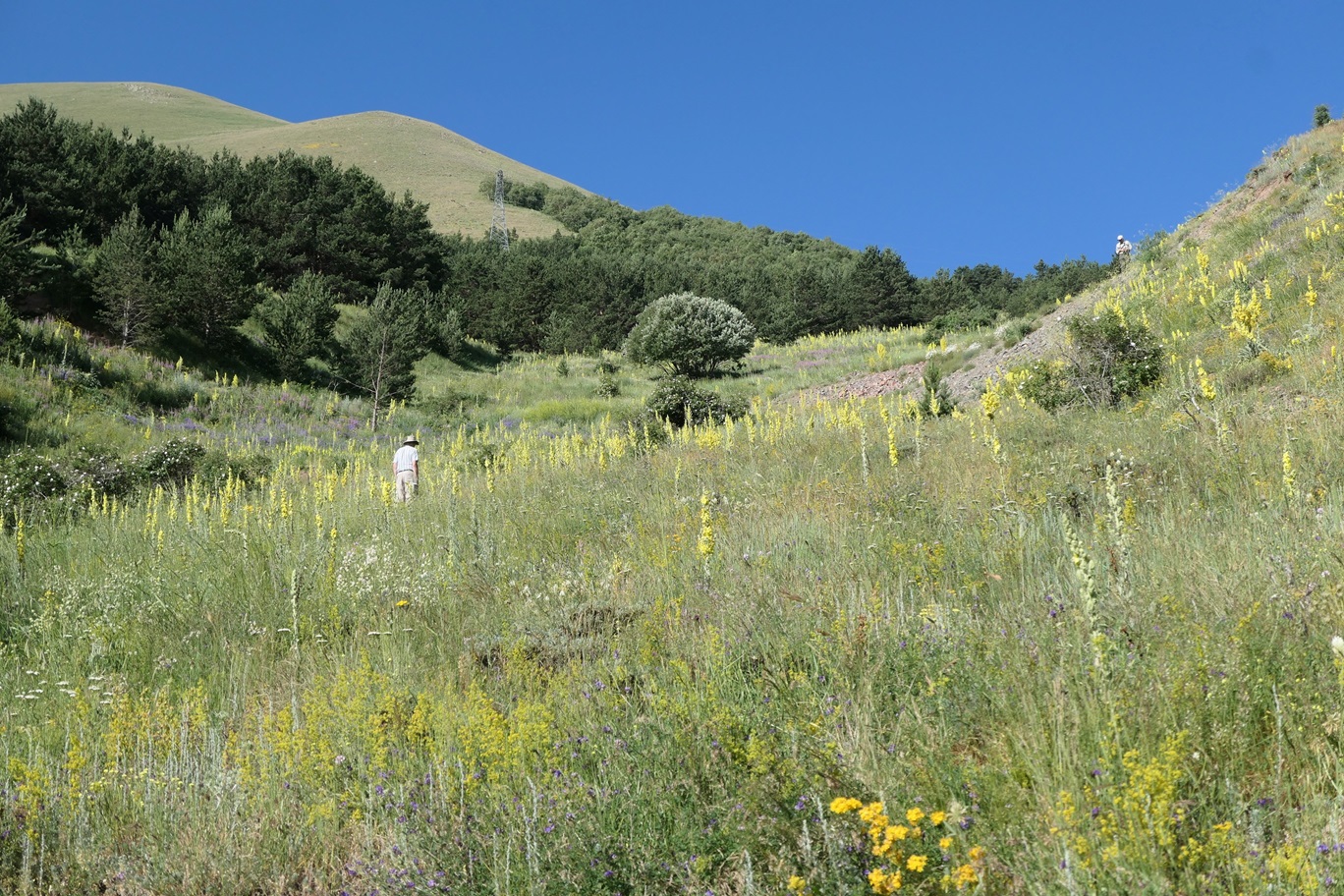
It was a great trip but frankly, I was in well over my head. That said, I did enjoy it and I learnt a lot. I well remember the first afternoon spent in a small area on a sunny mountain slope beside our hotel in Erzurum – we recorded 49 species without moving more than 500 metres: 140% of the Irish list! After that, we went to our main destinations, two different centres in the northeastern mountains. The first was Olgunlar, a high village at c.2,000 metres asl. This was essentially a summer village, as the winters here are harsh and people then move themselves and their animals to lower altitudes. Just up from the village is a long mountain valley with verdant meadows and screes that led up towards the high peaks of the range. Agriculture here is still practised as in the old days with cattle tended in the meadows and hay cut by hand; no tractors or fertilisers are used.
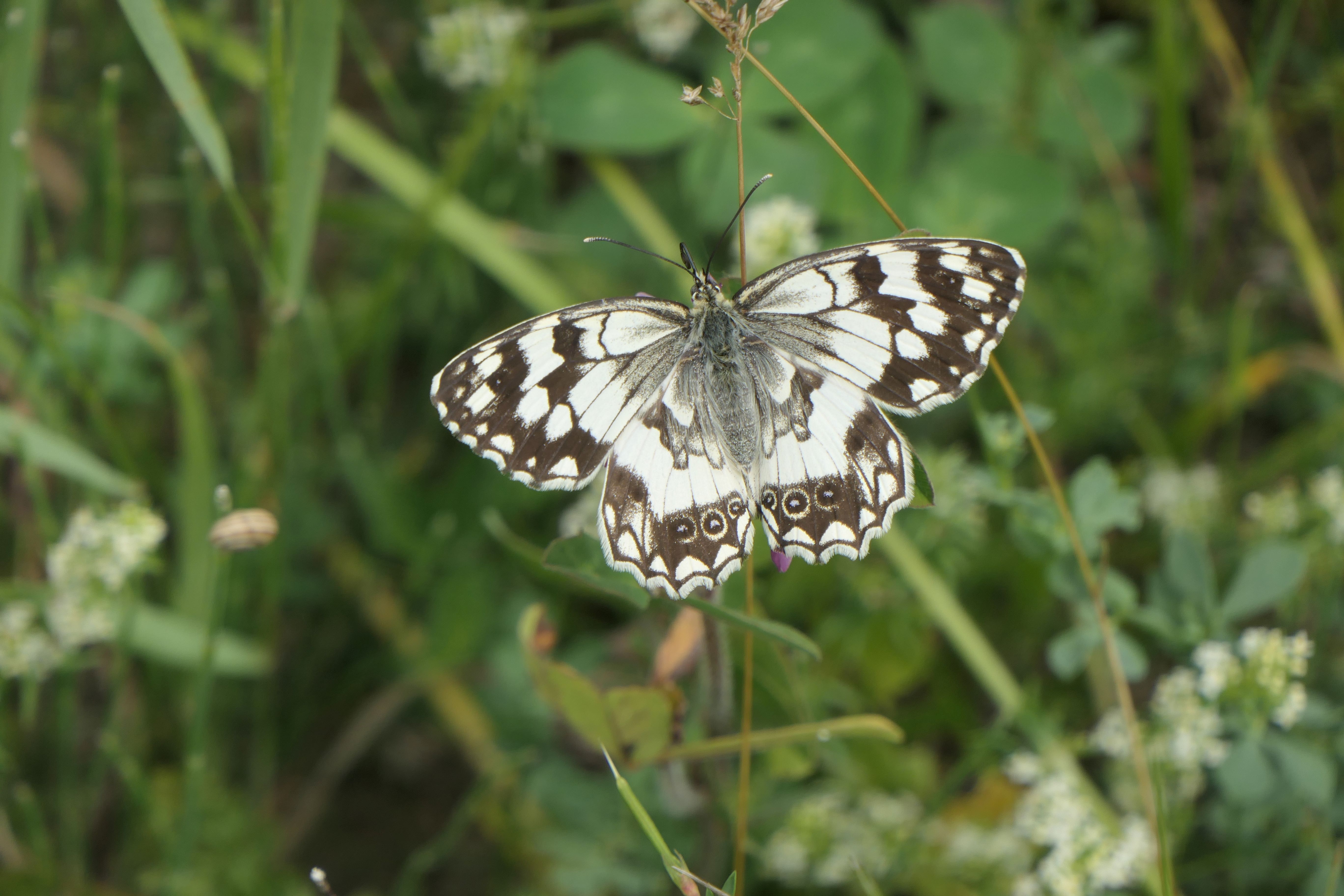 Balkan Marbled White, Turkey.
Balkan Marbled White, Turkey.
The second base was Barhal at c.1,300 metres asl, set in a wooded valley with numerous other valleys nearby full of excellent habitat: woods, crags and crystal-clear mountain streams. We stayed in small, homely guesthouses, with delicious local food. Every day, we ventured forth to look for butterflies in the lovely meadows, screes and woods, set against a backdrop of stunning mountain scenery. Evenings were spent perusing our photographs and trying to put names on the many confusing species, especially the Blues! There were too many species to enumerate anything more than a few highlights which for me included Swallowtail Papilio machaon, Apollo Parnassius apollo, Black-veined White Aporia crataegi, Balkan Copper Lycaena candens, the Marbled Whites Melanargia spp., Caucasian Fritillary Boloria caucasica, Nettle Tree Butterfly Libythea celtis, Southern White Admiral Limenitis reducta, Scotch Argus Erebia aethiops, etc.
I was introduced to two new ways of seeing butterflies here: roosting and mud-puddling. As the name implies, roosting involved searching grasses on the tracksides in the late evening and early morning to look for roosting butterflies, which were invariably docile and quiescent. Mud puddling is where butterflies congregate at wet, muddy spots, often where rivulets crossed the tracks to pick up vital salts and minerals. Butterflies would frequently congregate on animal dung too for the same reason. The resulting assemblages contained a remarkable variety of Blues and Skippers, with other species sometimes present.
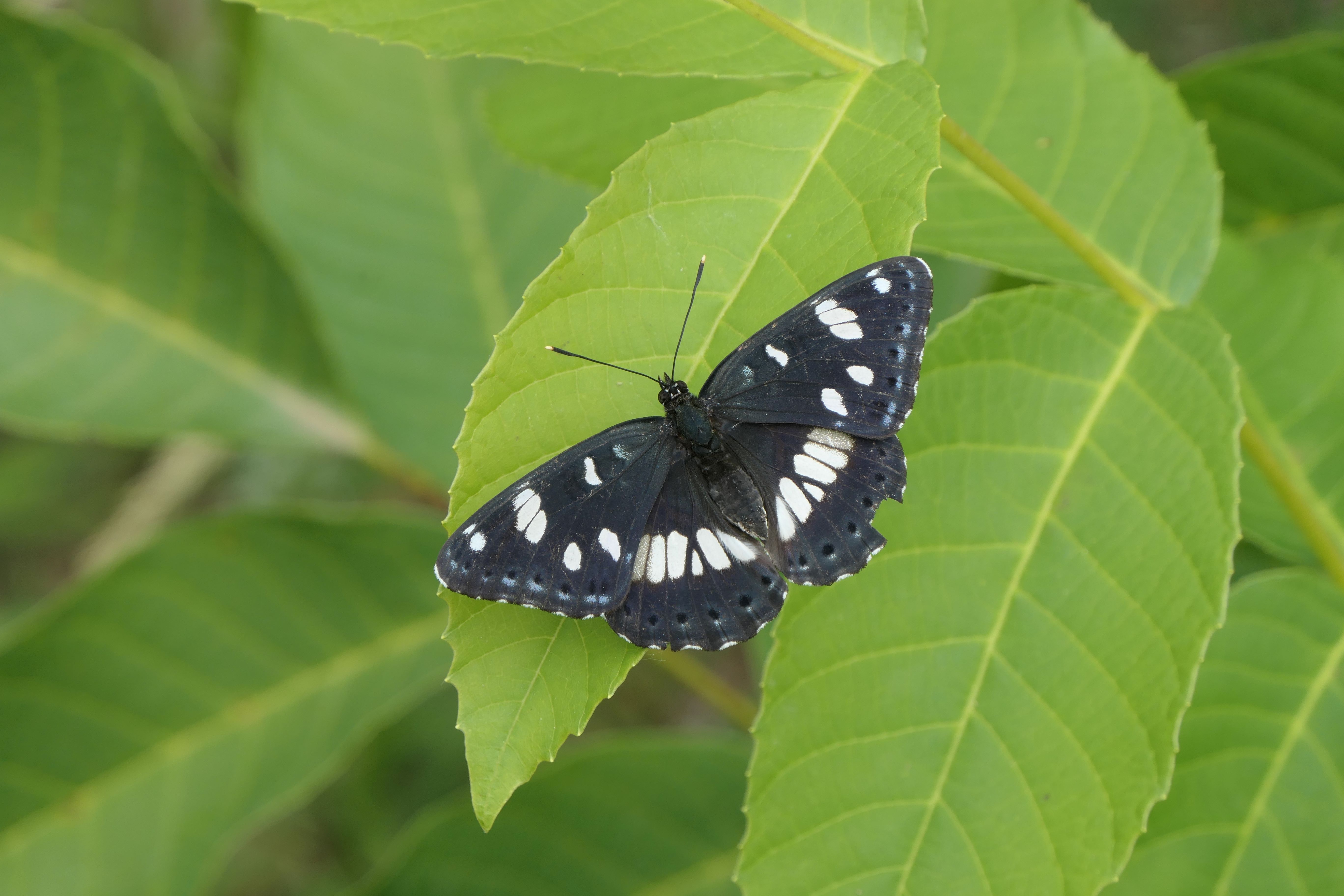
Southern White Admiral, Turkey.
After an exhilarating but exhausting few days, we returned to Erzurum seeing many more interesting butterflies en route. The total trip list was about 140, of which I saw c.100 as it was impossible to see everything with a relatively large group and such a dazzling array of species. In the months afterwards, I had great fun matching my photos to different species and learnt the hard way that I had to be better organised in future.
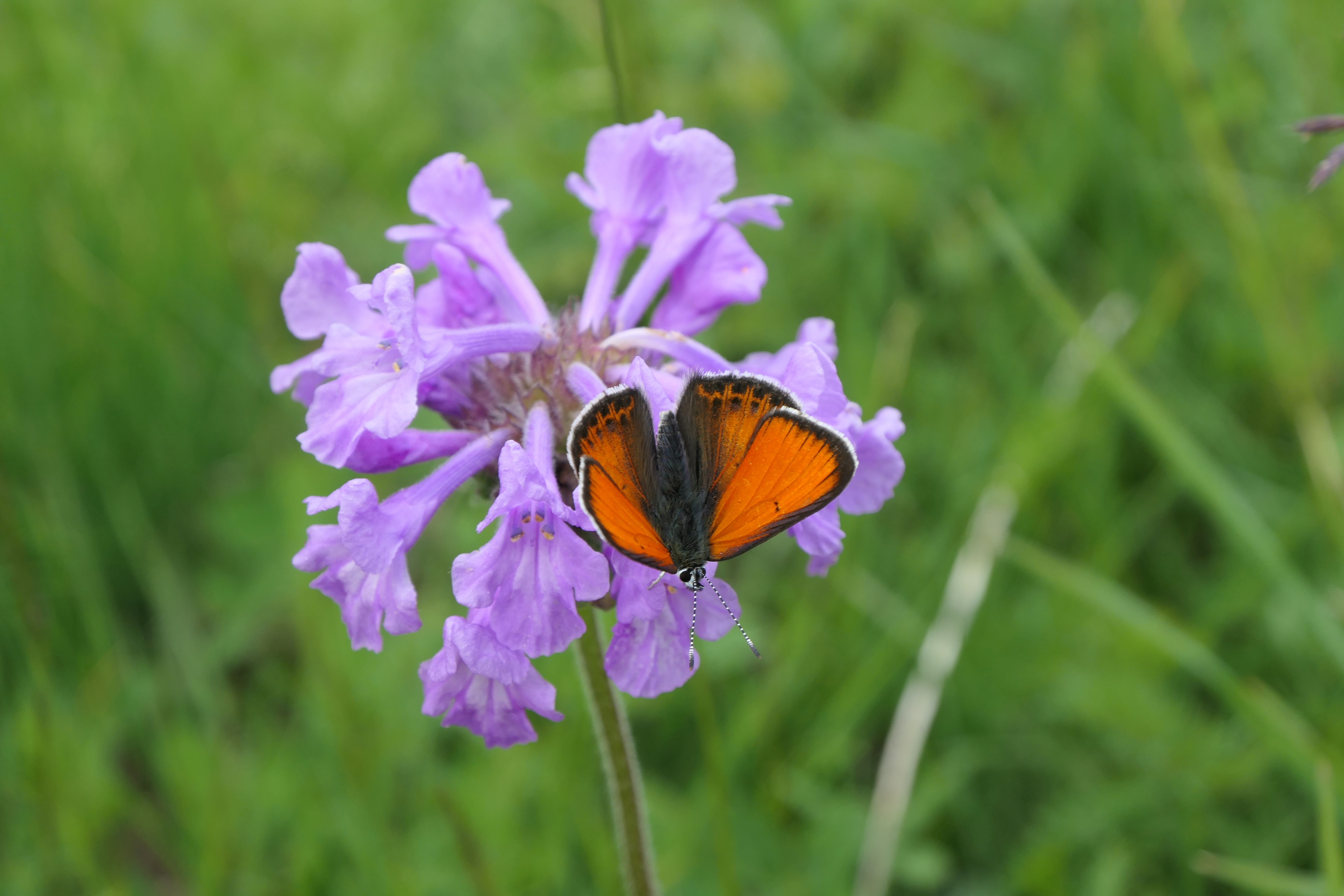
Balkan Copper, Turkey.
In 2023, I was fortunate to go away a few times, first on a winter sun week to Tenerife. This Atlantic island has quite an interesting butterfly fauna but as it was February and I was unable to access the better habitats, I saw only a few interesting species including the endemic Canary Islands Speckled Wood Pararge xiphioides, African Grass Blue Zizeeria knysna and the largest butterfly in Europe, the impressive Monarch Danaus plexippus.
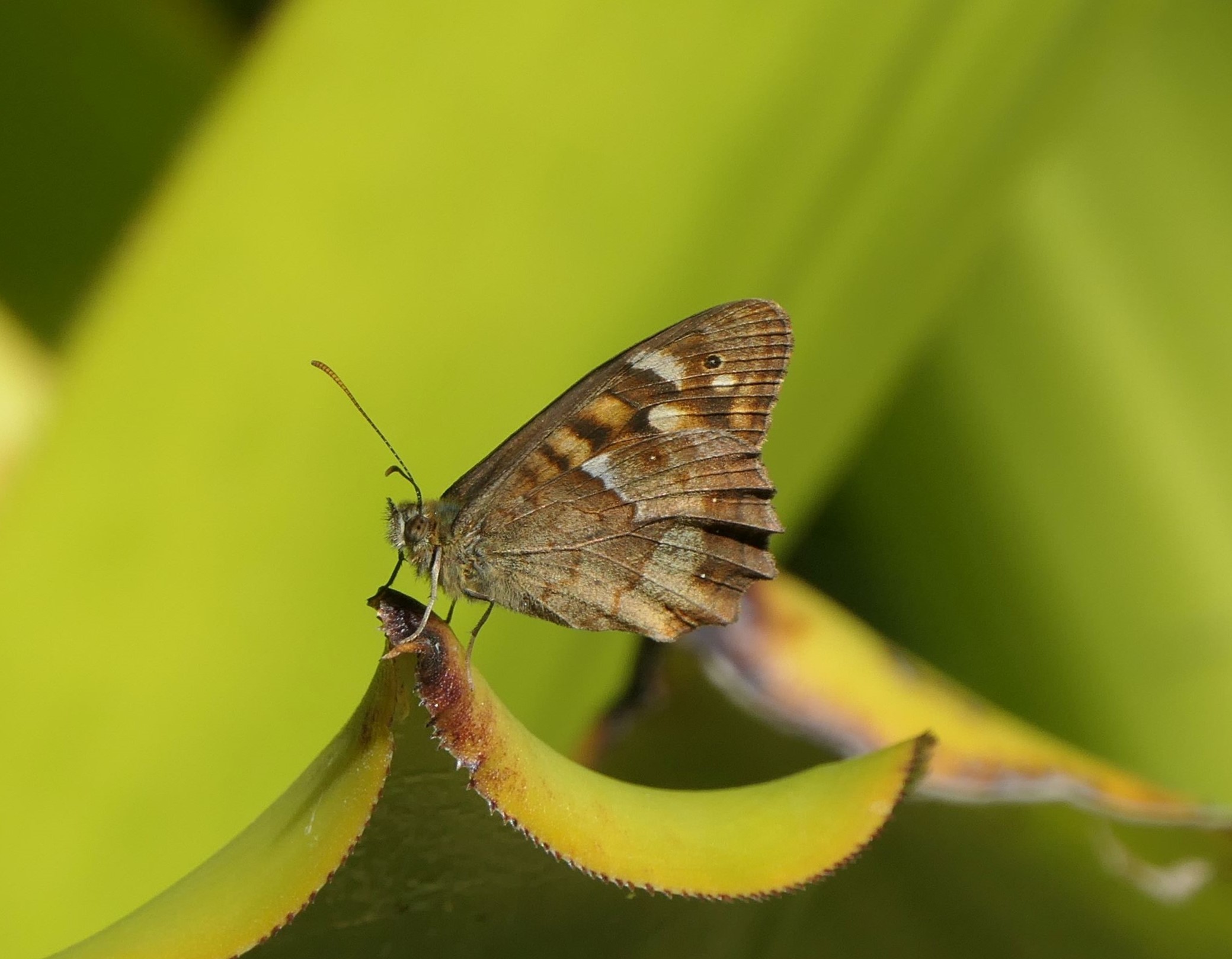
The Canary Speckled Wood flies throughout the year.
I followed this up with a holiday to Cyprus in spring, where I was able to chase birds, butterflies and dragonflies, as well as trying to grapple with some of the exotic flora there. We were based in Paphos in the south-west of the island and some local areas proved fruitful, although longer journeys were necessary to increase the species list. Cyprus has a relatively modest butterfly list and three endemic butterflies: Paphos Blue Glaucopsyche paphos, Cyprus Meadow Brown Maniola cypricola and Cyprus Grayling Hipparchia cypriensis. All three are widespread and easy to see.
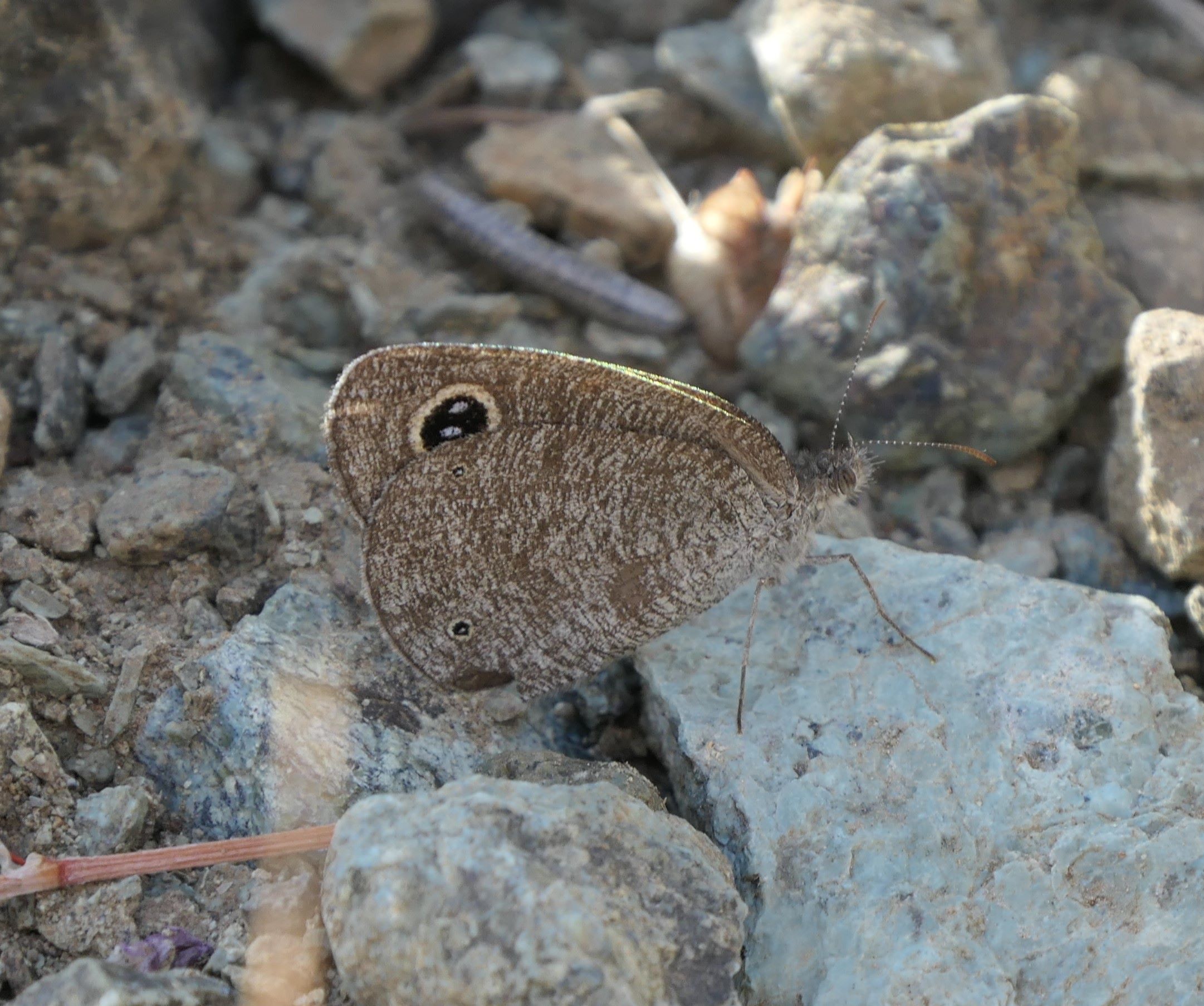 African Ringlet, Cyprus. This butterfly is very restricted in its range in Europe.
African Ringlet, Cyprus. This butterfly is very restricted in its range in Europe.
There are also several other nice butterflies, including Lulworth Skipper Thymelicus acteon, Cleopatra Gonepteryx cleopatra, Eastern Bath White Pontia edusa, Eastern Festoon Zerynthia cerisy and the rare and elusive African Ringlet Ypthima asterope. Overall, this was a most pleasant holiday as I saw 25 butterfly species as well as some good birds and a range of nice dragonflies.
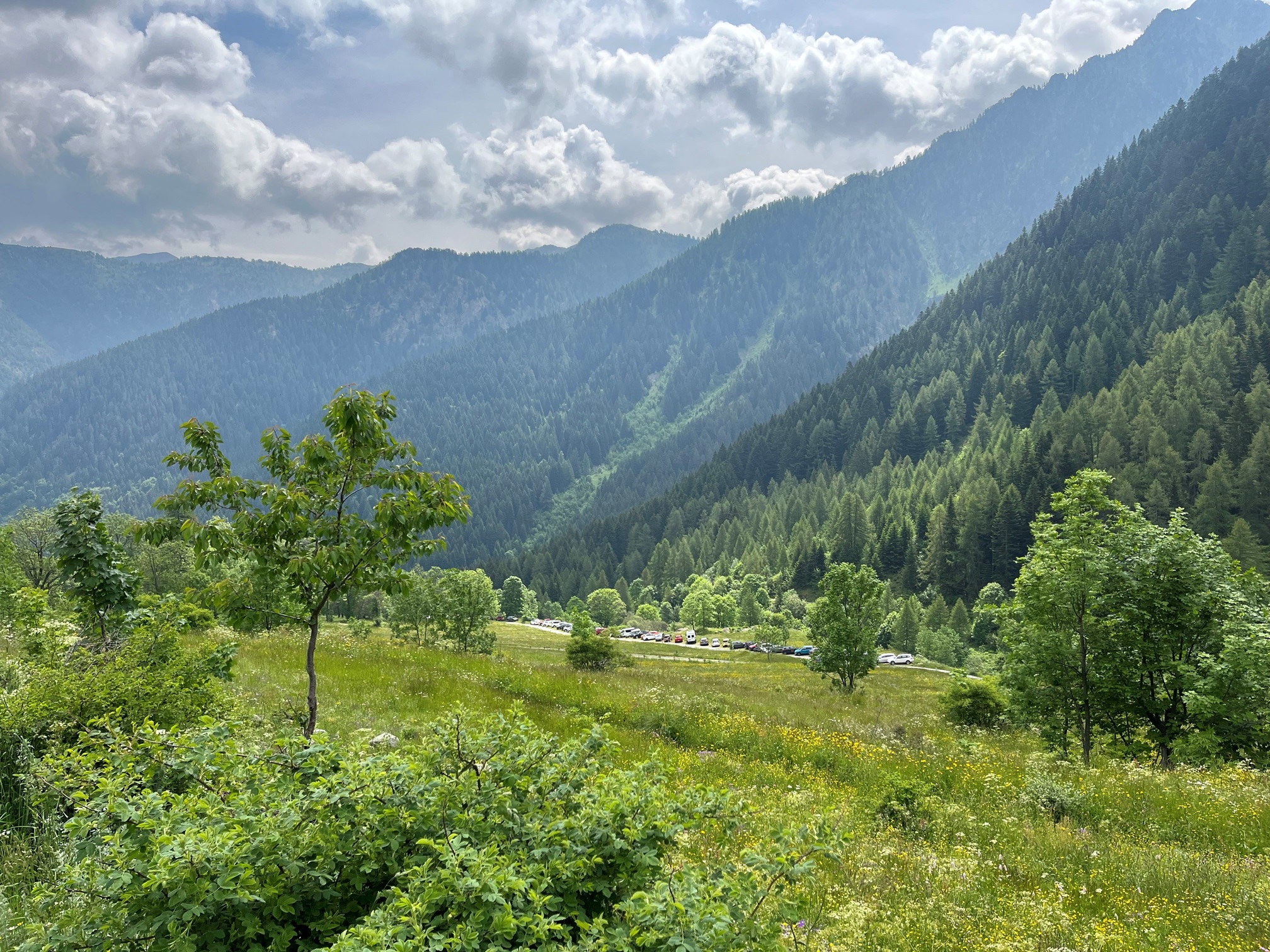
Now it was time for the main course in 2023; another organised butterfly tour! This time, I decided to visit the Alps, specifically the Maritime Alps in Italy, just across the French border. The European Alps are renowned for their large butterfly fauna. As one would expect, we were able to enjoy magnificent scenery, flower-filled meadows and a fine array of nice butterflies. Our base was a small village, Bagni di Vinadio, named after the thermal springs there. Our comfortable hotel boasted a lovely outdoor pool, thermally heated! Every day we set out to visit different areas at different altitudes and with subtly different habitats.
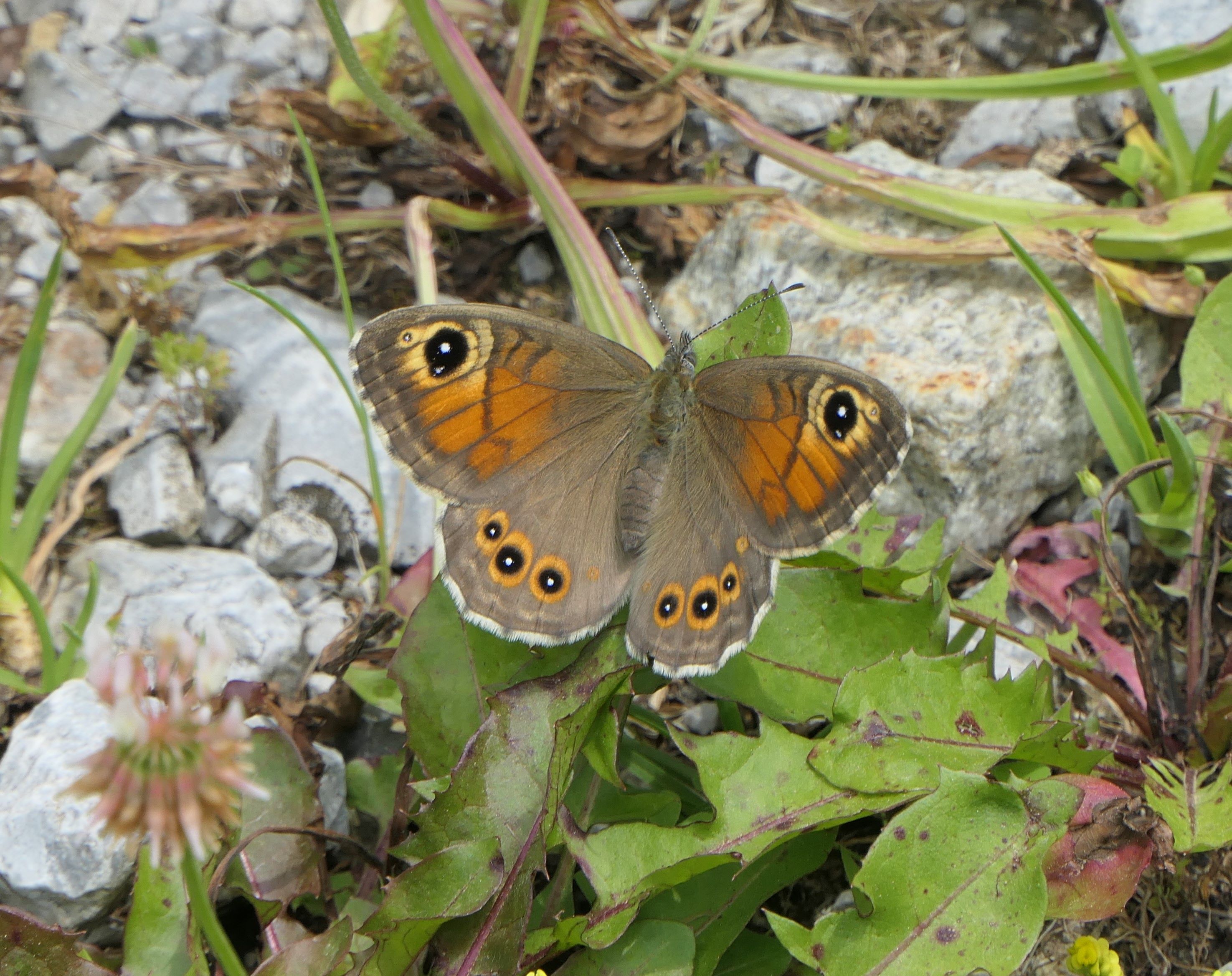
Large Brown Wall, Italy.
After my trip to Turkey, I was better able to handle the diversity and felt I was starting to get a handle on the large European butterfly fauna. As one would expect, highlights were many and included Adonis Blue Lysandra bellargus, Blue-spot Hairstreak Satyrium spini, Purple-edged Copper Lycaena hippothoe, Titania’s Fritillary Boloria titania, the spectacular Poplar Admiral Limenitis populi, Large Tortoiseshell Nymphalis polychloros, Pearly Heath Coenonympha arcania and several wall brown species.
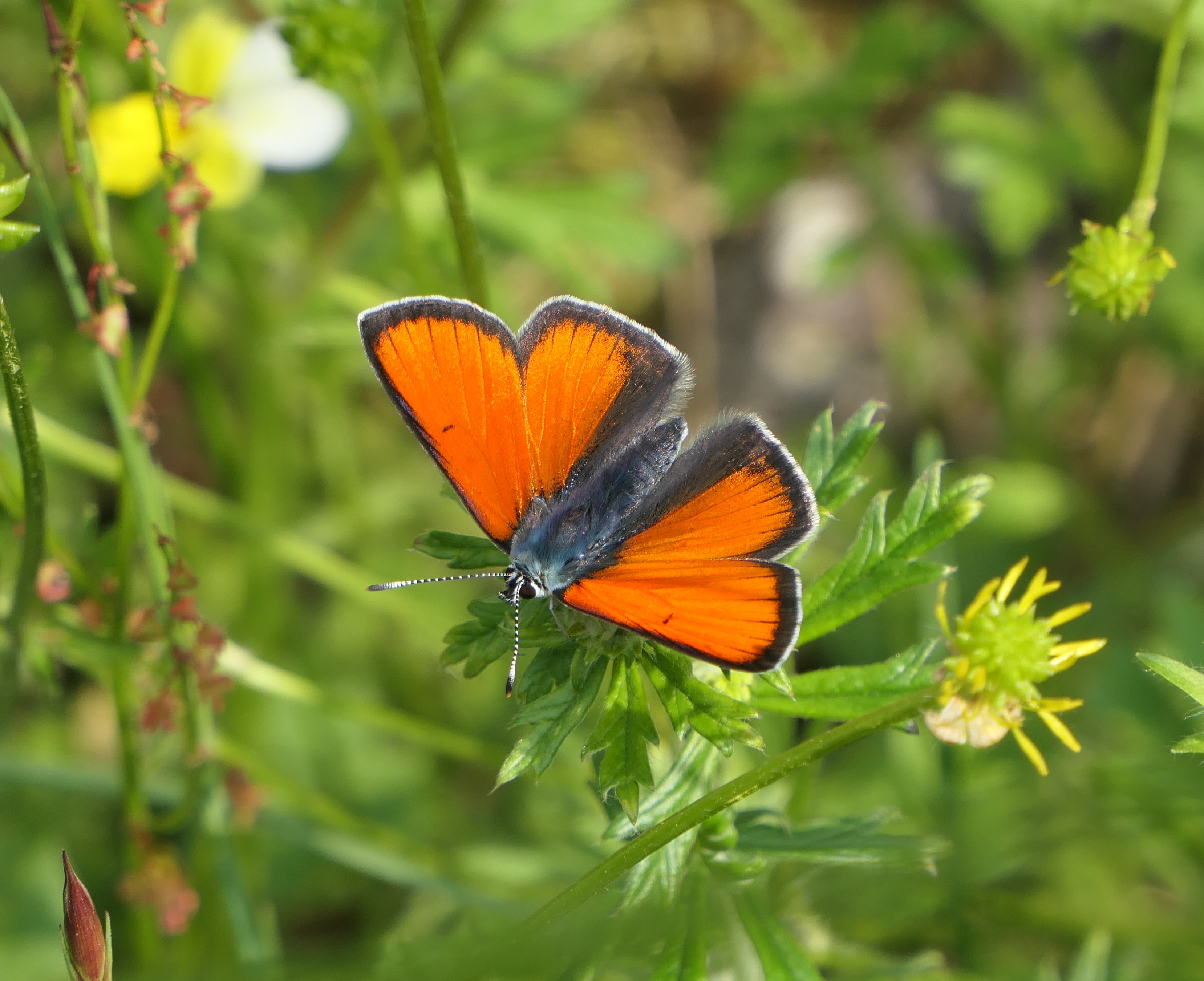
Purple-edged Copper, Italy.
Looking for roosting butterflies was very productive here and they were easy to see and photograph in the clear, haze-free evening light. Mud-puddling also featured, and animal droppings usually attracted interesting butterflies. The overall trip list was about 100 and I managed to see some 80 of these.
Overall, all the trips were very enjoyable. There is certainly considerable merit in an organised tour where you have the benefit of expert guidance and the convivial company of like-minded enthusiasts. That said, looking for butterflies on a family or general sightseeing holiday is also great fun and there is the feeling of satisfaction at finding and identifying all your butterflies.
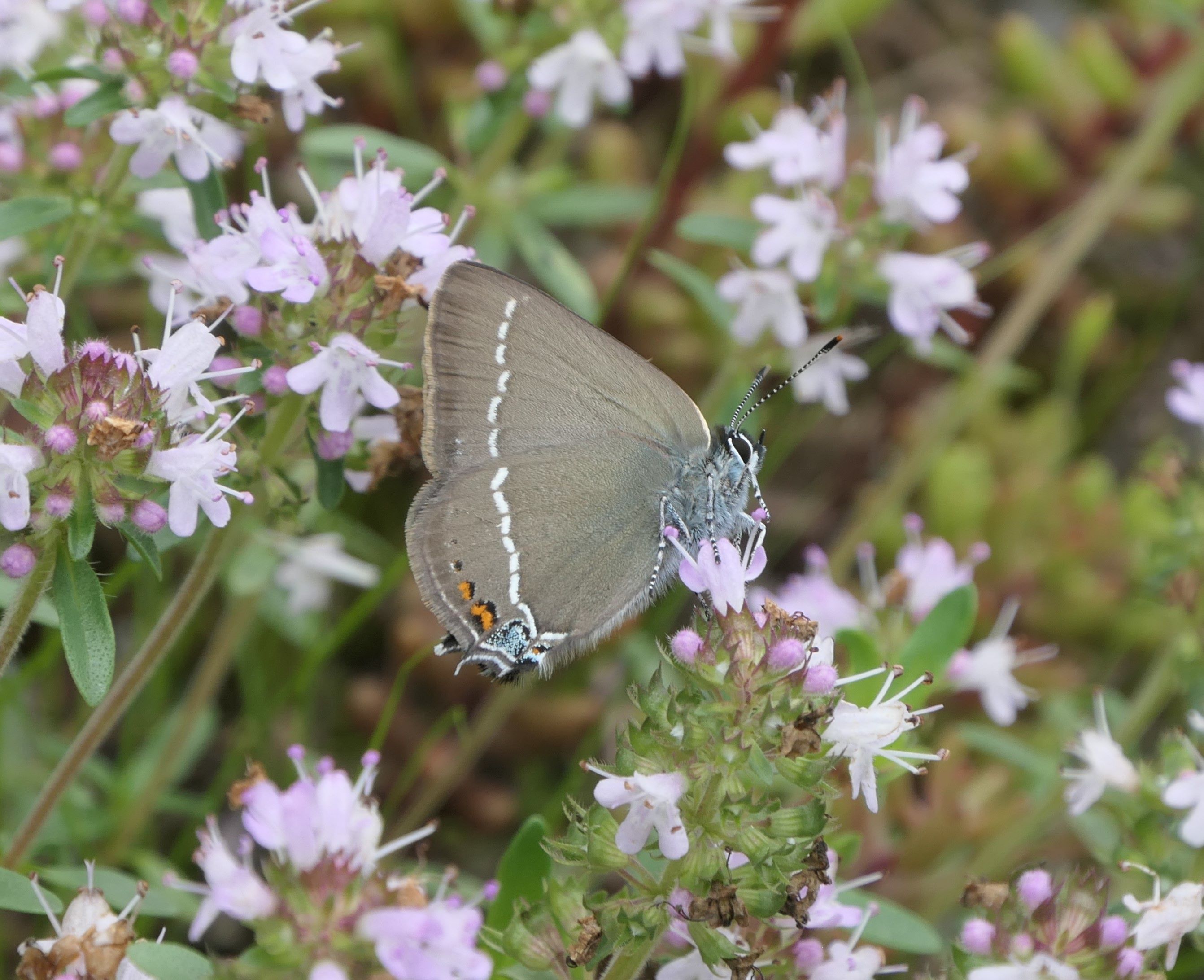
One of the key elements when looking for butterflies abroad is good reference books. The main ones I relied upon were the Collins Butterfly Guide by Tom Tolman which covers all the butterflies in Europe with superb illustrations by the legendary Ian Lewington. The other excellent book was The Butterflies of Britain and Europe: A Photographic Guide by several Finnish authors. This book also had the advantage that it covered the Atlantic Islands and the islands in the eastern Mediterranean and SW Turkey. Finally, there is A Photographic Guide to the Butterflies of Central Europe & Britain by Peter Gergerly, which is indispensable and is available as a free PDF. Finally, the eBMS (European Butterfly Monitoring Scheme) has produced simple guides to the butterflies of several European regions; these are available as free PDFs. These have just illustrations with limited information on status and flight seasons but they are very useful because they help to narrow down the available choice of species to look for. The one for Cyprus was very useful.
I cannot wait to go away again to another European location and see what butterflies it has to offer!
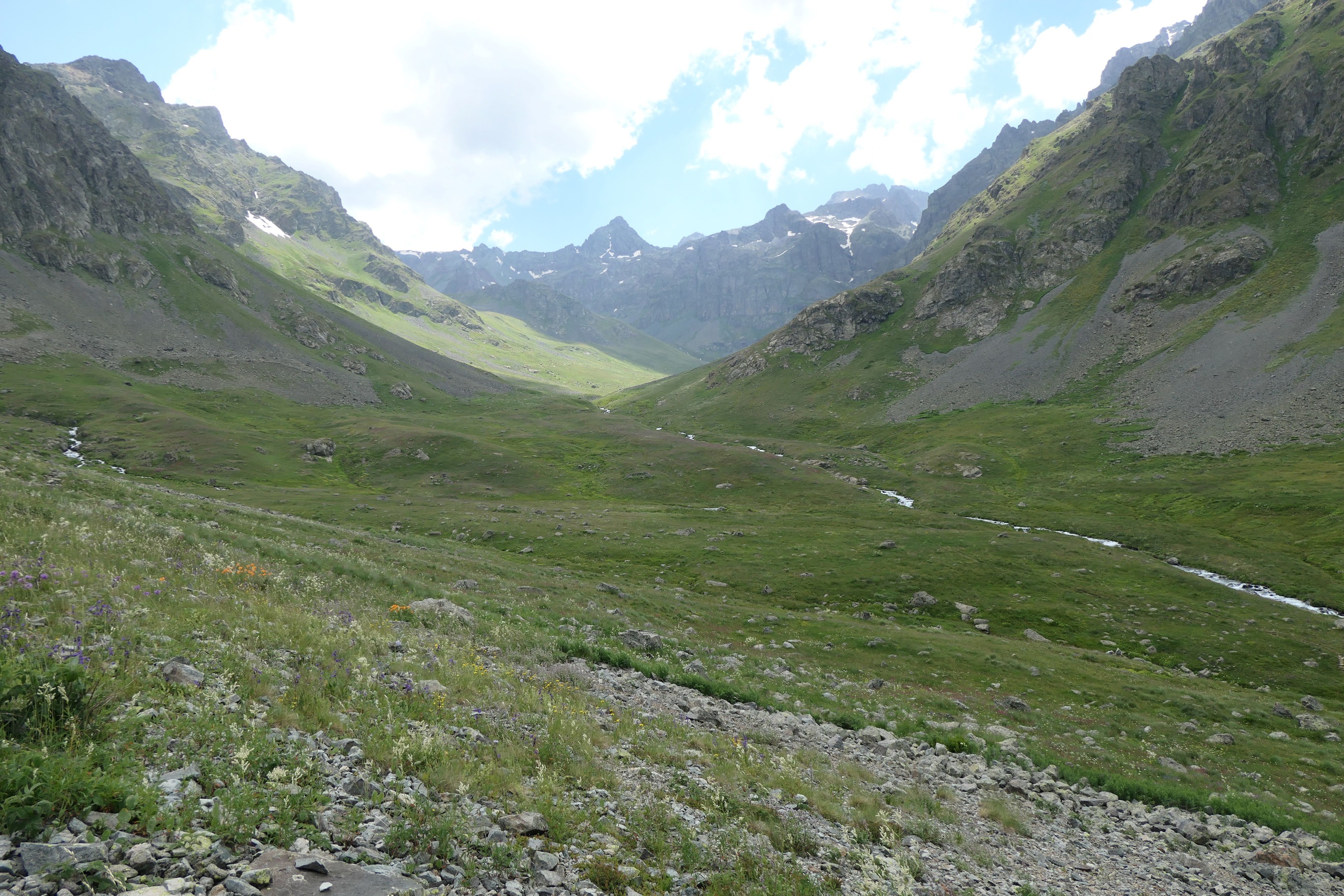
High mountain valley, Kaçkar mountains, northeast Turkey.
All photographs in the OVERSEAS BUTTERFLY ODYSSEY © Jim Fitzharris
BUTTERFLY SEASON REPORT 2023
In the past 15 months, Ireland has experienced the wettest October (2022), the wettest March and the wettest July on record. January was quite mild and drier in the second half of the month, and February 2023 were very mild and very dry, but March was payback time. April was mild and changeable but had below-average sunshine, while the first half of May continued similarly but the second half of May was dry and sunnier as it progressed. June was sunny and most of the month was dry, with some rain towards the end of the month. June 2023 was the warmest June on record. Then July hit us with cold, wet and dull weather. August continued with July’s wet hangover, with heavy rain and flooding early in the month and later, with some sunny weather in the third week but August registered below-average sunshine in most places.
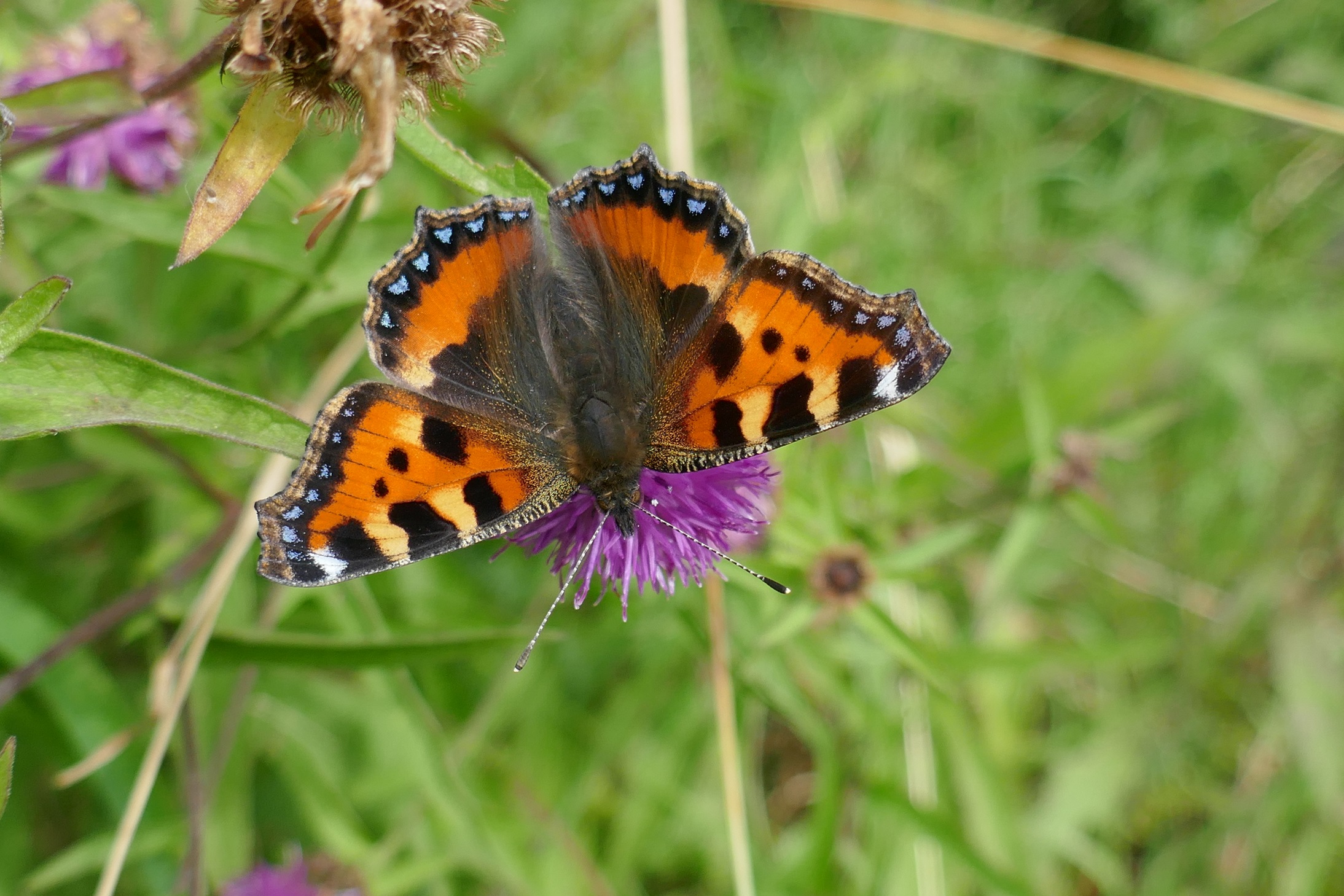 Early September’s spectacular weather allowed butterflies like this Small Tortoiseshell to feed up for winter.
Early September’s spectacular weather allowed butterflies like this Small Tortoiseshell to feed up for winter.
Partial redemption shone in early September when we had a heatwave. This brought one of the warmest spells of the year as a hot tropical-continental air mass moved over the country from the south-southeast, with record maximum and minimum temperatures for September at many stations. Scattered thunderstorms broke out between the 7th and 10th before Atlantic weather fronts brought a change of air mass on the 11th. The rest of September was often unsettled with above-average rainfall everywhere. October, you may have guessed, had above-average rainfall, below below-average sunshine but was mild, showing higher-than-average temperatures. November and December were mild and wet. Summing 2023’s weather up, it rained, but overall, the temperatures were above average and sunshine levels were above average in summer and autumn.
However, aside from about six weeks from mid-May, we had no prolonged settled weather, by which I mean periods without significant rain. How did our butterflies deal with these conditions?
For the first time in many years, I was not asked to go on the radio to explain why there are such low numbers of butterflies being seen by members of the public. However, bad weather during March saw very few records. Only 37 butterflies were reported to the BCI Records Page in March 2023 compared with 308 in March 2022. 663 butterflies were reported during April 2023, a huge jump, but to be expected as the season advances.
Arising from the poor March conditions, the Orange-tip, and the first broods of the Green-veined White and Holly Blue did not appear in March (except for one Green-veined White on 31st March) but the number of reports of the Orange-tip, Green-veined White and Holly Blue in April were in line with April 2022 figures. May was much better for abundance, reflecting better weather and seasonal progression. The first and last reports of these three species were Holly Blue (2nd April, 5th November), Orange-tip (10th April, 22nd June) and Green-veined White (31st March, 1st October).
The Small White made its first appearance on 16th April in Sutton, County Dublin, reported by Frank Smyth. The Large White was reported first by Con O’ Donnell in Moville, Donegal on 29th April. The first Dingy Skipper was seen by Luke and Sean Geraty on 9th May at Lullymore, County Kildare. This is certainly later than in some previous years; in 2020 for example, it was first observed on 25th April. On that date the first Cryptic Wood White was observed; in 2023 the first Cryptic Wood White waited until 9th May, when Alex and Jesmond Harding also saw the first Small Copper of 2023. The last Cryptic Wood White record in 2023 was on July 19th when Michael Gray saw two in The Raven, Co. Wexford. The Speckled Wood was first reported on 30th March, in Knocklyon, Dublin, by Jim Fitzharris while another spring and early summer butterfly, the Green Hairstreak was seen first by Eamonn Mc Glinchey at Ballyare Wood, Ramelton, Donegal on 17th April; Eamonn saw seven Green Hairstreaks that day.
Four of our butterflies overwinter as adults and these are the earliest to emerge in spring. The first sightings were: Brimstone (16th March), Small Tortoiseshell (3rd February), Peacock (13th February), and Comma (16th March).
The Marsh Fritillary put in its first showing of 2023 on 16th May at Lullybeg Reserve, seen by Jesmond Harding. The final record of this rarity was nearby on 22nd June, also by Jesmond Harding. The species appeared in unusual locations in 2023, most likely because the beautiful sunny weather during the flight period allowed individuals to be mobile, encouraging dispersal. The highest number reported was 99 individuals on 27th May, at Lullybeg Reserve. On that day, it vastly outnumbered all the other butterflies combined!
Other butterflies to emerge in late spring and their first emergence details are Small Heath, 16th May, by Frank Smyth near Creevy Pier, Ballyshannon, Co. Donegal and Common Blue, 8th May at Brittas Bay, County Wicklow, by Jim Fitzharris. The Small Blue was first recorded on 13th May when Maurice Simms reported seeing four at Sheskinmore, Donegal. No large numbers of this scarce species were reported in 2023. The final report came from Simms also at Sheskinmore, on 22nd June. A notable record of the Small Blue came from Adrian Riley, who found at least 12 just east of the R477, close to Fanore Beach, County Clare. The dunes there did not contain any Small Blue population or habitat when I last checked them, so it is reassuring to know they are found close by.
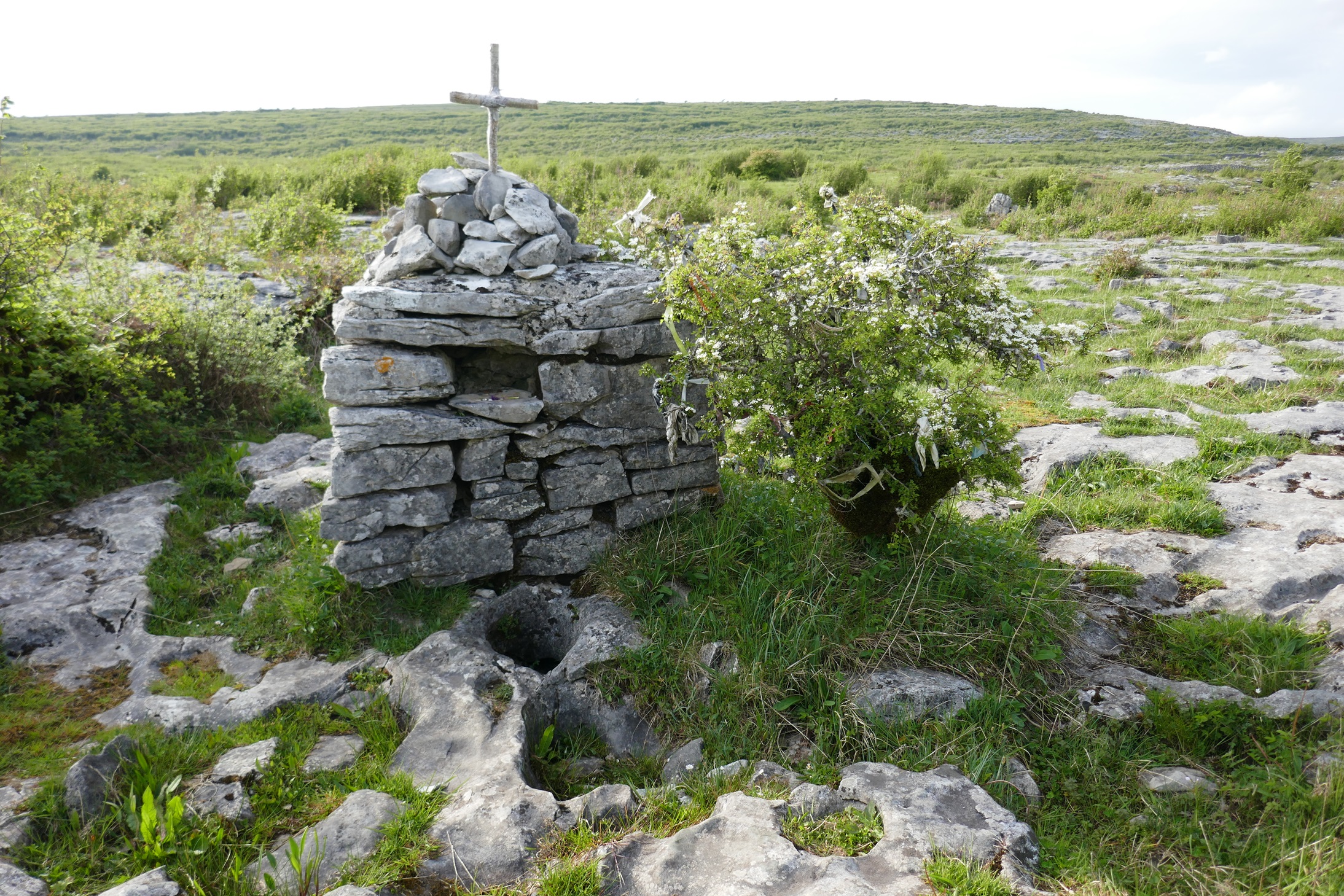 A holy well with rag tree in the Burren, County Clare. This site holds several rare butterflies including the Pearl-bordered Fritillary and Wood White.
A holy well with rag tree in the Burren, County Clare. This site holds several rare butterflies including the Pearl-bordered Fritillary and Wood White.
There are few observers in the Burren particularly during the spring months so tracking the abundance and flight period of Pearl-bordered Fritillary and Wood White is difficult. There are just eight reports of the Pearl-bordered Fritillary, from May 13th to June 1st while the Wood White was first reported on May 13th when a BCI outing found 15 or more in Clooncoose Valley, County Clare. Second-generation Wood Whites were recorded at Tulla, near Gort, County Clare and Gortlecka, County Clare on August 15th by Jim Fitzharris, Luke and Sean Geraty.
Two mid-summer butterflies, the Dark Green Fritillary and Grayling, which are mainly in flight in July and August were first reported by Eamonn McGlinchey on June 19th at Bunbeg, County Donegal, although Ethna Diver also saw her first Dark Green Fritillary that day, at Magheraroarty, also in County Donegal. The stupendous abundance of this magnificent butterfly at Sheskinmore continues to enthral, with Maurice Simms counting 153 on June 22nd. The species had its finale on August 17th at Doagh Isle, Donegal, observed by Con O’Donnell. July saw days of grey skies and rain, but the Dark Green Fritillary does not mind that.
Neither did the first brood of the Small Tortoiseshell which began to emerge in mid-June. Larger numbers of Small Torts were spotted during its second reign which seemed to hatch earlier in 2023, being much in evidence by mid-August with big counts made (148 at Lullybeg on August 21st, 50 on Bull Island’s Alder marsh on August 28th, 246 at Lullymore on September 3rd, 135 at Lullybeg the following day, etc). The Peacock also embraced the rain in July and August and appears to have rebounded after a poor showing in 2022. The new batch began to emerge around mid-July, with Pat Wyse seeing over 50 near Killyguire, Co. Kildare and over 50 in Newbridge, also in Kildare on July 25th and August 1st respectively.
The last butterfly reported to us in 2023 was a Peacock, near Grafton Street, Dublin, on 7th December, sunning itself on a wall. The Comma, flying from March 16th to November 5th was reported to us 187 times, the highest figure so far for this rapidly expanding species.
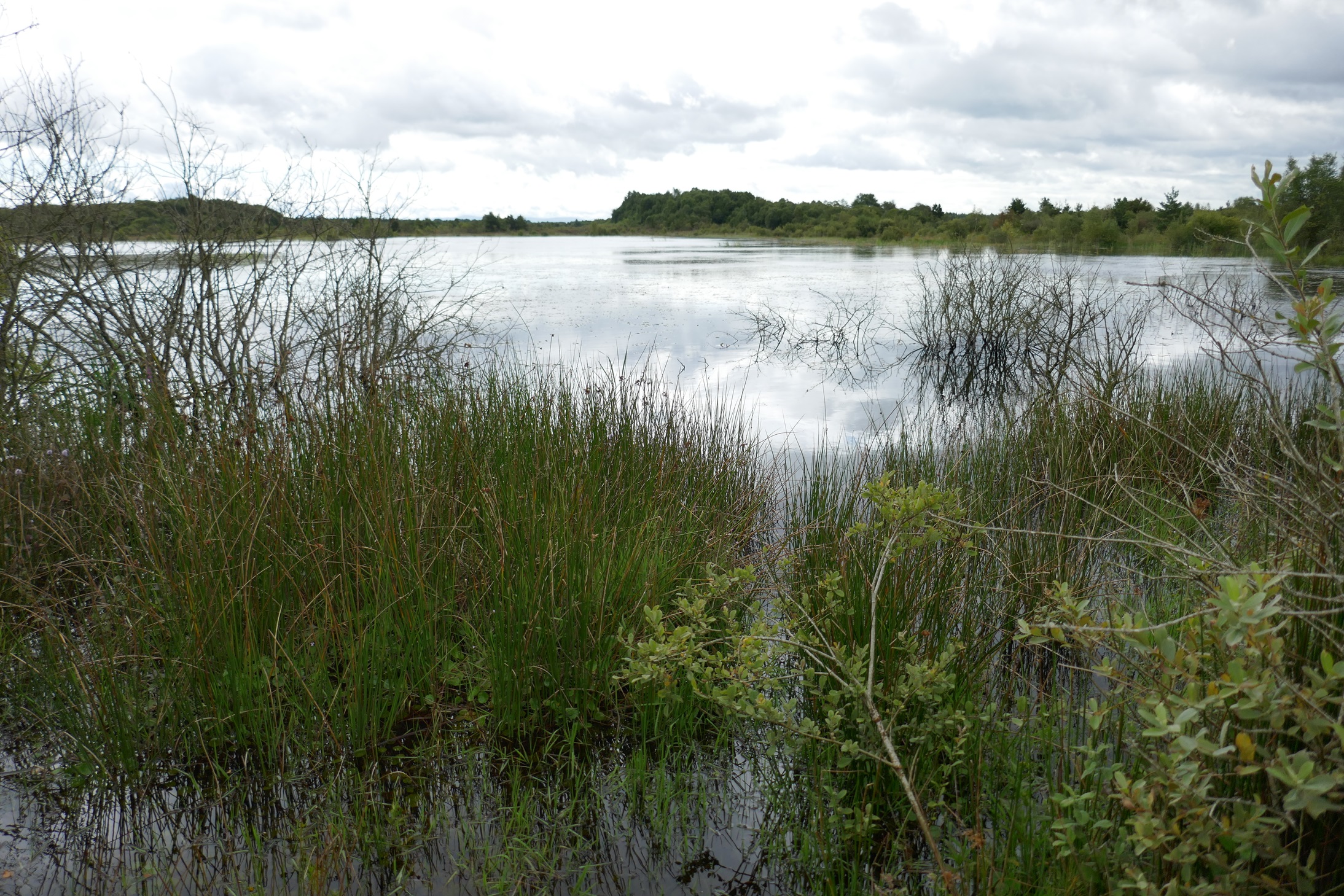 Flooded cutover bog, Drehid North, County Kildare, July 2023
Flooded cutover bog, Drehid North, County Kildare, July 2023
Another butterfly undaunted by July’s miserable weather is the Silver-washed Fritillary. In 2023, its recorded flight season was between June 21st, Lullymore (Pat Wyse) to August 30th, Lullybeg (Jesmond Harding). Although there is no report of high abundance (the highest was 25 from The Raven, July 8th, Stephen Bolger, Luke and Sean Geraty), it certainly thrived at Lullybeg (see Reserve Report). It is likely that if other woods where it is known to reach high populations were checked at the correct time, we might have impressive totals to lay before you.
Mid-summer is the heyday of our two golden Skippers with the Essex Skipper and Small Skipper making their debut on July 7th and July 4th respectively. I was fortunate to see 34 of the latter on July 28th on North Drehid Bog, Kildare, and one of the former. Michael Gray counted 54 Essex Skippers at Sinnottstown Lane, Wexford Town, County Wexford, on July 20th.
How did our arboreal hairstreaks find the conditions during July and August 2023? We have seven records of Purple Hairstreak starting on July 3rd when 7 were seen in Phoenix Park, Dublin by Sean Geraty. The last record was from August 20th, from Knocksink Wood, Enniskerry, by Jim Fitzharris. In this wood, it can be observed from the bridge which provides a perfect view of the canopy of a mature Sessile Oak. Brown Hairstreaks were seen three times, firstly by Helen McQuillan at Knockauroe, Burren National Park, Co. Clare on August 1st, and 2nd and on August 15th at Tulla and Knockaunroe, County Clare, Jim Fitzharris, Luke and Sean Geraty.
The first new summer Brimstones were spotted on June 29th at Lullybeg. They enjoyed the highest abundance in northwest Kildare I have known; on August 9th I saw 91, and there must have been many more present, for only a small area was checked. The latest 2023 Brimstone record was September 9th.
Ireland’s brown butterflies are suffering declines, due to changes to grassland habitats especially on farmland and probably from atmospheric nitrogen deposition. The Meadow Brown was first noted on May 31st in Clare (by Adrian Riley, Shropshire-born author of texts on British butterflies and moths) and the final record comes from Lullybeg on September 9th (Jesmond Harding). Over 100 were seen by Jesmond Harding in late June along and adjoining Walshe’s Lane, Mulhussey, County Meath, particularly on bramble blossom, and it is likely large populations flew elsewhere in 2023. Similar numbers were seen there on July 4th. It is doing well in large parks where grass is allowed to grow, such as St. Catherine’s Park, Lucan.
The Ringlet is another common brown butterfly with a shorter flight period. During 2023, its recorded flight period ran from June 10th (Lullybeg, Luke and Sean Geraty) to August 10th (Michael Gray, Kilmashogue, County Dublin). We had 98 reports of the Ringlet in 2023, compared to 121 reports in 2022. As early as June 21st, over 50 were seen near Russborough House, County Wicklow. On June 22nd, Jesmond Harding counted 361 Ringlets on Lullybeg Reserve. High numbers persisted there into early July but with far lower figures elsewhere. Is it declining? More checks of its best habitats, tall, wild grasses in moist areas with some shade, are needed in 2024. We had 13 reports of the Grayling in 2023, all but one from coastal locations, the inland exception being the Burren National Park on August 15th (Jim Fitzharris, Luke and Sean Geraty). The recorded flight of the Grayling in 2023 spanned June 16th to September 4th.
The Speckled Wood, believe it or not, is Ireland’s most recorded butterfly with more individuals recorded than for any other butterfly, with 54,100 records in the National Biodiversity Database. In 2023, we received 294 reports of this species, underlining how common it is in Ireland. Its recorded flight period in 2023 was March 30th to October 25th. However, it is not the most reported species on the BCI record database for 2023, that honour belongs to the Red Admiral, with 350 reports of one or more individuals.
A declining species, the Small Heath was reported to BCI 61 times in 2023. The numbers of reports from 2019-2023 are 54, 64, 83, 57, 61 respectively. The highest figure recorded anywhere was 21 at Lullybeg on June 13th. The recorded flight time was May 16th to August 17th.
The Wall Brown, once distributed throughout Ireland but now in serious retreat, was reported to BCI just 34 times (32 in 2022), beginning on May 2nd (Fanad, Co. Donegal, Frank Smyth) and finally on August 25th (Rosbeg, County Donegal, Maurice Simms). There was one spectacular abundance figure: 64 at Cruit Island, County Donegal at rocky outcrops opposite the old graveyard halfway up the island and on the south side along the rough path out to Aughnish Point, by Maurice Simms.
The bog butterfly, the Large Heath is rarely reported because few recorders take the plunge by traversing wet, uneven bogs even in June and July. On June 4th Luke, Sean, and Joe Geraty got to see 77 on Clara Bog, an outstanding site for it. Overall, we had just five reports.
Another decliner, probably in as much trouble as the Wall Brown, is the Gatekeeper/Hedge Brown. In 2023, we obtained 11 reports ranging in time from July 7th (The Raven, Jim Fitzharris) to August 28th (Seefin, West Cork, Co. Cork, Felicity Laws). The highest figure of 39 comes from The Raven, July 19th, seen by Michael Gray.
2023 had one nice surprise for us. Ian Stephenson discovered a Long-tailed Blue in Inchicore, County Dublin. The photograph showed the butterfly outdoors, wings closed. This might be the first record of the species that was not introduced on cultivated beans, often used as breeding plants. A fast-flying, mobile butterfly with a large geographical range, this one might join us on a full-time basis in time.
While 2023 will not be recalled for the glories of the Irish weather, unless you think only about June, some of our butterflies enjoyed a much-needed abundance boost. The weather patterns may have contributed to the butterfly boom. The heat of the latter half of May and June allowed many species’ caterpillars excellent growth opportunities on foodplants lush from the spring rain. The resulting butterflies emerged in July and August when floral sources were in good supply, and despite the rain, were able to avail of enough dry weather to feed for breeding, migration or hibernation. While one good butterfly summer does not a recovery make, it was nice not to be asked what has happened to our butterflies this year.
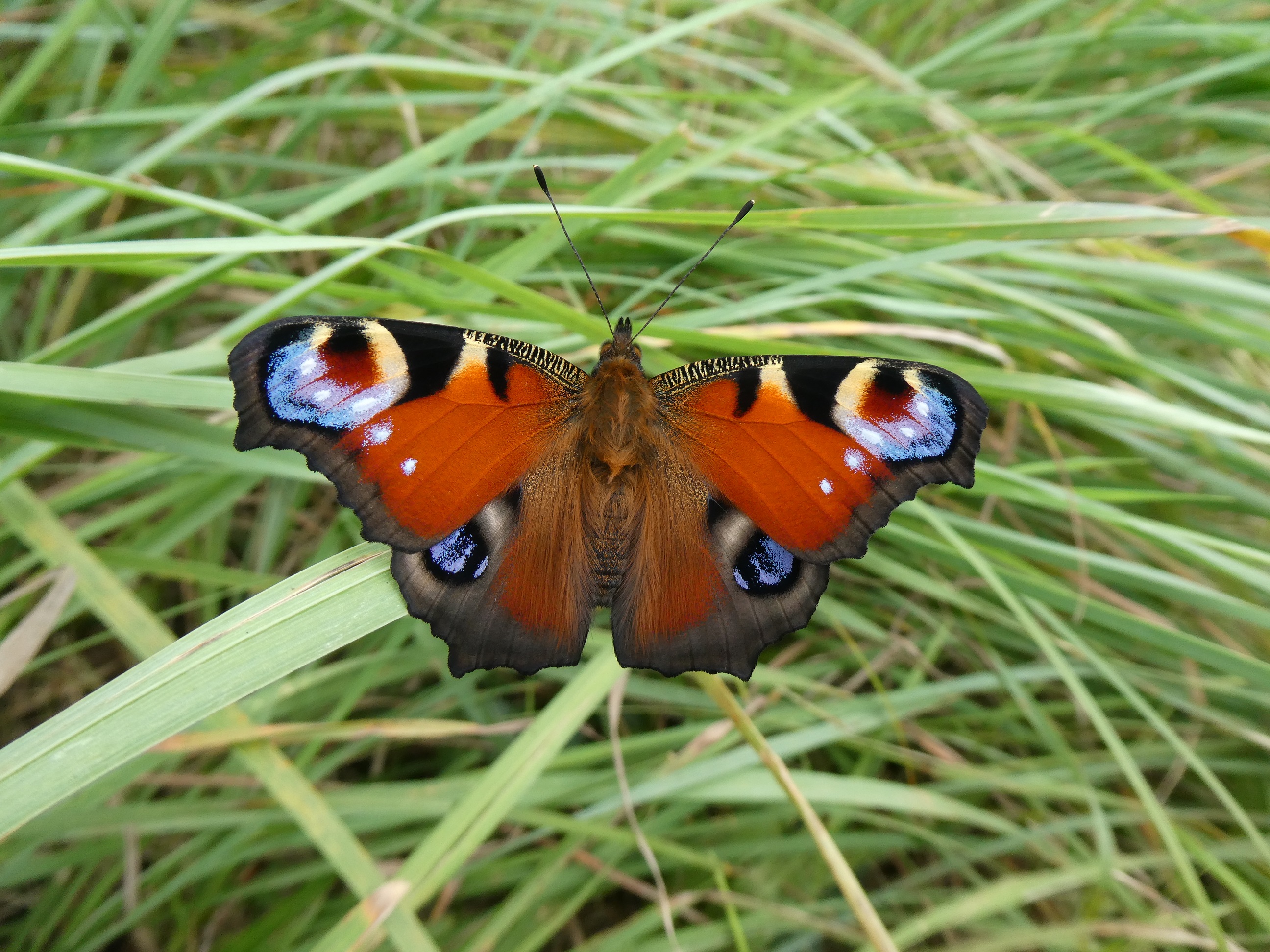 The peacock had a good year in 2023.
The peacock had a good year in 2023.
CRABTREE RESERVE REPORT 2023
| Species Recorded | Site Total 2018 | Site Total 2019 | Site Total 2020 | Site Total 2021 | Site Total 2022 | Site Total 2023 |
| Dingy Skipper | 14 | 10 | 10 | 47 | 31 | 21 |
| Brimstone | 63 | 102 | 52 | 47 | 44 | 129 |
| Cryptic W’d White | 3 | 9 | 6 | 6 | 1 | 0 |
| Green-v’d White | 40 | 6 | 7 | 10 | 14 | 20 |
| Orange-tip | 9 | 7 | 2 | 1 | 1 | 1 |
| Large White | 1 | 0 | 2 | 2 | 1 | 1 |
| Small White | 26 | 4 | 2 | 3 | 2 | 0 |
| Green Hairstreak | 0 | 0 | 1 | 0 | 0 | 0 |
| Common Blue | 71 | 44 | 36 | 31 | 18 | 32 |
| Holly Blue | 0 | 0 | 1 | 0 | 0 | 1 |
| Small Copper | 30 | 15 | 20 | 13 | 12 | 5 |
| Red Admiral | 13 | 65 | 13 | 2 | 93 | 101 |
| Painted Lady | 77 | 260 | 0 | 2 | 1 | 3 |
| Small Tortoiseshell | 500 | 206 | 231 | 270 | 134 | 517 |
| Peacock | 243 | 319 | 48 | 39 | 17 | 239 |
| Comma | 0 | 1 | 0 | 0 | 21 | 11 |
| Dark Gr’n Fritillary | 35 | 27 | 21 | 11 | 2 | 4 |
| Silver-w’d Fritillary | 36 | 28 | 9 | 6 | 8 | 57 |
| Marsh Frit | 31 | 80 | 163 | 287 | 206 | 247 |
| Wall | 1 | 0 | 1 | 1 | 0 | 0 |
| Speckled Wood | 51 | 35 | 11 | 7 | 19 | 22 |
| Meadow Brown | 239 | 401 | 204 | 417 | 206 | 264 |
| Ringlet | 752 | 1423 | 588 | 1097 | 636 | 1296 |
| Small Heath | 63 | 57 | 44 | 74 | 35 | 52 |
| Large Heath | 0 | 0 | 0 | 0 | 1 | 0 |
| Total | 2298 | 3099 | 1472 | 2373 | 1514 | 3023 |
The butterflies on Butterfly Conservation Ireland’s reserve at Lullybeg are counted by walking the transect route (a fixed route walk through habitats that represent those found on the reserve) on part of the reserve from April to the end of September and in October when conditions favour butterfly activity. The results are sent to the National Biodiversity Data Centre for the Irish Butterfly Monitoring Scheme. Butterflies seen outside the transect route are counted separately but the table above gives combined figures to give the site total (note: only the managed areas of the reserve are surveyed). In 2021 and 2022, 21 counts were made. In 2023, 24 counts were made. Twenty species were seen on the reserve in 2023. The notable missing species were the Cryptic Wood White and Small White, neither of which are common in the area, although Cryptic Wood White is usually seen each year.
The headline figure is the total number of butterflies seen and 2023 had a huge increase in abundance, being five butterflies short of being double the 2022 total! This is not attributable to the two additional visits. The increased abundance figures are mostly due to the recovery of the populations of the Brimstone, Small Tortoiseshell, Peacock and Ringlet, all butterflies that can produce large populations when conditions favour them. For example, 2022 saw an abject performance in the Peacock, with a mere 17 counted but 239 were recorded in 2023.
However, the increases were also dramatic in some less common butterflies. The Silver-washed Fritillary had a bumper year with the jump from eight in 2022 to 57 in 2023, seven-fold increase. The Marsh Fritillary showed a more modest rise, from 206 to 247 butterflies, while the declining Small Heath increased from 35 to 52.
The news, as ever, is not universally positive, with drops in the Dingy Skipper, Small Copper and, unexpectedly, the Comma and with the Dark Green Fritillary at a low point on the reserve. We did not see the Green Hairstreak or Wall Brown on the reserve in 2023. The habitat does not suit the Green Hairstreak, because the wet heath areas are not large enough but the Wall Brown’s decline, as it is in so many places, does not appear to be linked to the quality of the habitat but perhaps to the operation of more sinister factors such as the concentration of atmospheric nitrogen, which is then deposited on soils. Some factors are beyond the power of reserve managers to address.
The reserve was well managed in 2023, with scrub control and grazing applied, with special thanks to everyone who helped and supported our work. The reserve would not be the special place it is without the care you have shown; thank you.
CONSERVATION NEWS 2023
This report deals with some of our work undertaken during 2023. During February 2022, the planned work party uprooted birch and willow to clear the grassland on the reserve. During the November work event, we concentrated on uprooting saplings on a wide ride on the northern section of the reserve. Some scrub clearance by hand was undertaken by individual members at various times during January and February and this made a great difference to the habitats, particularly for the Marsh Fritillary, Dingy Skipper and Brimstone.
Scrub on the broad ride through woodland connecting Lullymore and Lullybeg was also cut to ensure that the two excellent areas remain linked so that butterfly populations in the area do not become isolated. Machinery cut scrub in the southern part of the reserve and along the silt pond on the northern edge of the reserve which is used as a feeding area by butterflies. Grazing was organised after fencing purchased from a grant from Kildare County Council was installed. The grazing took place in October, for about two weeks. While the cattle made an impact, the density of tussocky grasses means additional grazing is needed. Summer grazing is best but is difficult to arrange. We will try to arrange grazing in spring 2024.
On August 30th 2023, 27 Marsh Fritillary larval nests were found on the reserve, all but four on the northern side of the reserve. On August 28th 2022, 73 Marsh Fritillary larval nests were counted on the reserve, up from 65 Marsh Fritillary larval nests found in 2021 and far above the 29 nests found in September 2020. The large drop in the nests from the high in 2022 is not alarming, because great inter-annual fluctuations are typical for this species. What is important is that the habitat remains in good condition. It is hard to account for the decline in nests found because more adults were observed on the reserve in 2023 than in 2022 (see Reserve Report 2023). Perhaps some adults migrated from the reserve to seek new breeding sites in the region. Interestingly, the first larval nest arising from the butterflies that bred in 2023 was found on the reserve on June 29th 2023, the first time a nest was found there in June. This early hatching might have arisen from the prolonged sunshine from mid-May to near the end of June.
Our butterfly recording scheme began in 2013 and continued in 2023. We have thousands of records on our website. These records are of a high quality, because these are from reliable observers and contain clear information about the species and numbers found, the date and location of the finding, and sometimes additional information about the weather conditions and habitat.
New recorders frequently provide photographs of butterflies to support their record. Our online platforms promoted conservation throughout 2023. Various blogs were written to draw attention to butterfly and moth species that may be seen at various times of the year, to conservation measures one can take to enhance gardens and public spaces for butterflies, to promote recording, to comment on findings of various reports on butterfly and moth populations and to report on Butterfly Conservation Ireland outings.
Our Facebook page presents very attractive images sent in by members and by the public, as well as publicising our work/events. Conservation and habitat enhancement advice was provided to a range of bodies and members of the public.
Building support for the proposed National Peatlands Park continued during 2023. Several meetings to develop the proposal and communicate our vision were held during the past accounting year. We made a further submission to Minister Noonan and a final submission to the Draft Kildare County Development Plan 2023-2029, in April and May 2022 respectively. Butterfly Conservation Ireland produced a brochure to support the proposal (available as a PDF to anyone who wants it).
Copies of this have been provided to important decision-makers and it was submitted as part of our response to the draft Kildare County Development Plan. The final Plan shows strong support for this vital, landscape-scale proposal to tackle our biodiversity crisis. This project is ongoing and has resulted in intensive engagement and planning. We hope to have some positive news on this venture in 2024.
Butterfly Conservation Ireland is a key partner in an all-Ireland initiative, involving the National Biodiversity Data Centre, Butterfly Conservation UK Northern Ireland branch to produce a butterfly atlas for Ireland 2010-2021. Several members are involved in producing species accounts for the Atlas, a reflection of the expertise within our membership. The species accounts for the Atlas have been written along with most of the other sections of the Atlas. We are now at the editing and design stage and we hope that the Atlas of Ireland’s Butterflies 2010-2021 will appear this year.
We continued to engage with the construction team working on a solar farm in Drehid Bog, County Kildare to ensure that no damage is done to the habitat used by the Small Skipper. The two meetings held in the field during 2022 to guide the mitigation and advise on conservation work planned for the site was followed up by a site visit on 28th July when a count was undertaken on the site to assess the impact of the construction and mitigation measures. We are happy to report healthy butterfly and moth populations have been maintained, but in the longer term, site works to control scrub are needed. For the record, the following were observed on 28th July:
Small Skipper 34, Essex Skipper 1, Brimstone 4, Large White 1, Small White 6, Green-veined White 6, Small Copper 12, Common Blue 8, Red Admiral 9, Painted Lady 1, Small Tortoiseshell 8 (plus hundreds of larvae of a range of instars), Peacock 29, Comma 2, Speckled Wood 7, Meadow Brown 13, Ringlet 4, Shaded Broad-bar 8, Latticed Heath 2, Lesser Cream Wave c.5, Cinnabar larvae several, Small Purple-barred 2, Pyrausta purpuralis 1; Odonata: Blue-tailed Damselfly 3, Brown Hawker 1, Emperor Dragonfly 3, Common Darter 8, Black Darter 1 between N 75483 33524 and N 76942 34978, North Drehid Bog, Co. Kildare.
Our members have continued to work hard, organising and carrying out fundraising, recording, participating in practical conservation work and, very importantly, enjoying our butterfly and moth heritage. Please continue your recording and conservation work in 2024; no matter how small your work may seem you can make a difference. Some man-made habitats, such as gardens, often contain a greater range of biodiversity than semi-natural habitats because of the diversity of habitats and micromanagement possible in a garden.
Finally, Butterfly Conservation Ireland thanks everyone who helped with our conservation and education work in 2023. Conservation is a battle for the preservation of everything good about our natural world, and we greatly appreciate your commitment to the most elegant emblems of our natural heritage, our butterflies and moths.
GARDEN SURVEY REPORT 2023
Butterfly Conservation Ireland members and members of the public participate in our garden survey from March to November inclusive. The survey form, available as a download from our website www.butterflyconservation.ie and by post on request to conservation.butterfly@gmail.com asks the participant to record the first date each butterfly listed on the form was first recorded in their garden in each of the following three-month periods: March-May, June-August and September-November. In a final column, the highest number of each butterfly species seen, and the peak date are given. Finally, surveyors are asked to indicate which of the following attractants are provided in their gardens: Buddleia, butterfly nectar plants other than Buddleia and larval food plants. Twenty butterflies are listed for recording. The following report comments on the 2023 flight season, outlines the status of these butterflies in gardens during 2023, offers interpretations and comments on the findings and concludes by urging conservation and involvement in recording garden butterflies.
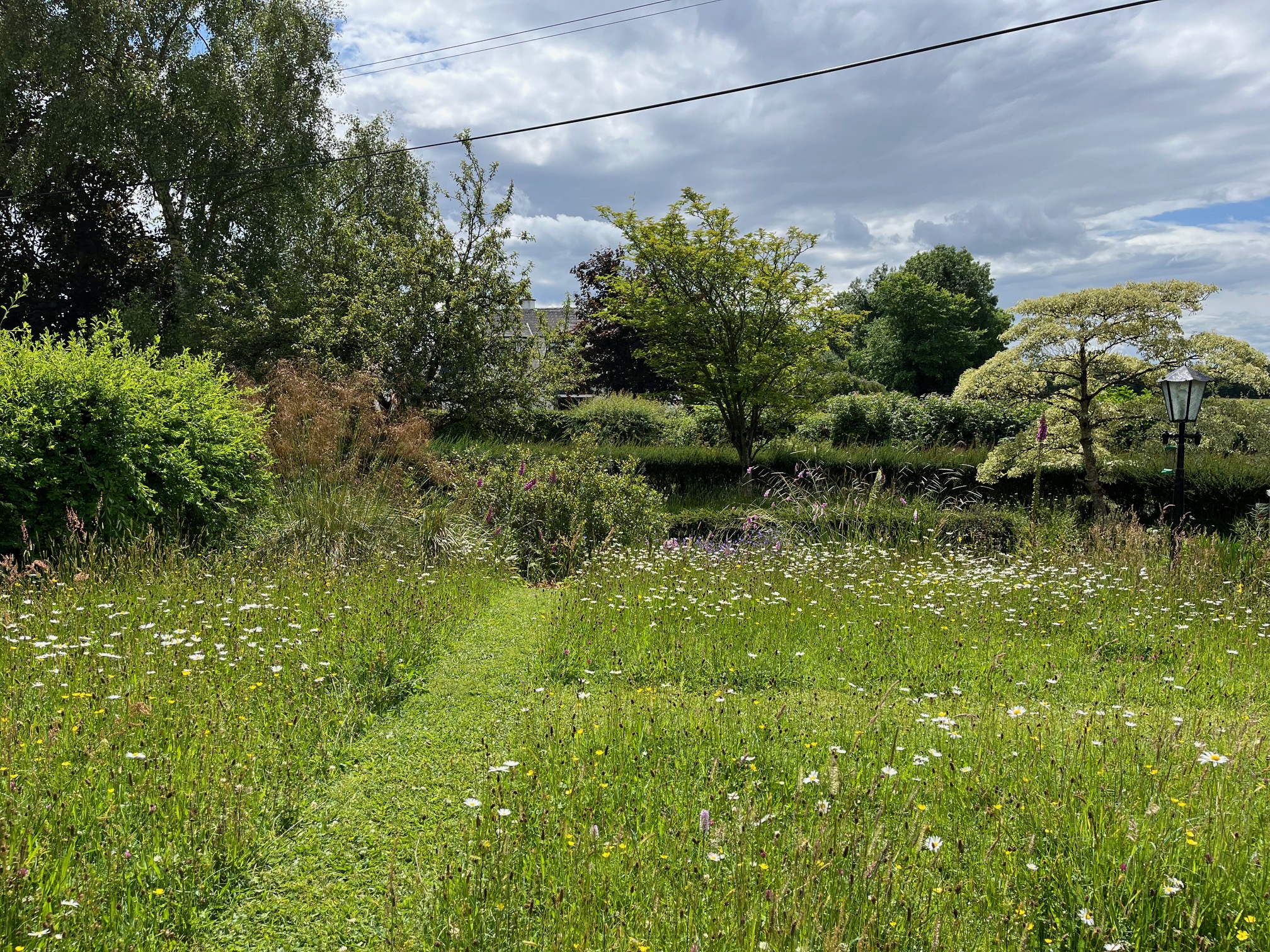 Lesley Whiteside’s beautiful orchid-rich garden, Westmeath. Photo Lesley Whiteside.
Lesley Whiteside’s beautiful orchid-rich garden, Westmeath. Photo Lesley Whiteside.
There were some astonishingly high abundance figures for garden butterflies recorded during 2023, astonishing not just for the abundance of butterflies but also for abundance following a wet spring, and a record wet July. Robert Donnelly, whose superb garden is in Ballyknock, County Kilkenny, counted 158 Small Tortoiseshells on August 22nd. It is worth recalling that Robert counted 91 Small Tortoiseshells on August 17th, 2022. Robert found five Cryptic Wood Whites on 23 May, 17 Commas on 6th July (a phenomenal figure for this species), and 42 Red Admirals on 25th July. Michael Gray recorded 212 individual butterflies in his garden in Rathfarnham, Dublin, during 2023, including 60 Small Tortoiseshells and 48 Holly Blues.
My peak count for one species was 23 Small Tortoiseshells on 29th August. Pat Bell, based in Maynooth, County Kildare counted 40 Small Tortoiseshells on 20th August, Enda Flynn in Dundalk, County Louth found 18 Small Tortoiseshells on 23rd August. During the June-August period, Marilyn Farrell found 75 Red Admirals, 59 Small Tortoiseshells and 37 Small Whites in her garden in Lispole, County Kerry, which lies c.8km east of Dingle. Marilyn’s garden on the southern side of the Dingle peninsula is well located to benefit migrating Red Admirals. One observer, Elaine Mullins from Portmarnock, County Dublin counted every butterfly she saw during the recording period. Elaine’s beautiful suburban garden returned 105 individual Holly Blue sightings between April 1st and October 22nd. The Comma flew in Elaine’s garden from 13th April to 7th October; 78 counts of the Comma were made by Elaine during this time.
Pat Bell, Maynooth, commented on his experience of butterfly abundance during 2023.
I had my best year ever with a total count of 400 compared to my previous high of 352 in 2021. This was driven in particular by new highs for Small Tortoiseshell (171) and Red Admiral (68) and a second highest for Peacock (57). I also had new highs for Holly Blue (25) and Comma (10). Whites are still not great – Large White average at 30 and Small White second worst at 13.
Key dates for butterfly abundance during 2023 were between 20th August and 5th September. These dates corresponded with chiefly warm, sunny weather. For example, I recorded 26 butterflies in my garden on 2nd September, Elaine saw 30 individuals on each day from 18th-31st August. This period of mainly warm, settled weather followed an extremely dull, wet and cool July and unsettled weather during much of August, the key month for garden butterflies. The population peak period seen in 2023 reflects that seen in previous years apart from 2022, which was hot throughout August so butterfly abundance was distributed across a longer period with no pronounced peak that year. The heat wave recorded in many stations in September from Monday 4th to Friday 8th 2023 encouraged butterflies (a heatwave occurs where there are five consecutive days or more with a maximum temperature over 25°C, that is a daily maximum screen air temperature > 25°). Maurice Simms in Combermore, County Donegal, had 20 butterflies in his very elegant garden on 6th September while Michael Gray had 22 on 7th September.
However, some butterflies hide during hot weather, and we did not appear to record very high abundance during early September, but Jesmond Harding was delighted to find several Vestal moths, a rare migrant, in his garden during this period.
The number of species recorded in the gardens surveyed during 2023 was 18; it was 19 in 2022, 17 in 2021 and 2020 and 18 in 2019 and 2018. The total of 17 garden butterfly species is up from 15 in 2017, up on 14 in 2015 and 2016; in 2014, 17 species were recorded. The mean number of species reported in the gardens was 12.6. The counties represented are Cork, Kerry, Kilkenny, Donegal, Dublin, Louth, Monaghan, Meath, Westmeath, and Kildare.
The less common garden visitors during 2023 are the Cryptic Wood White seen in two gardens (Robert Donnelly’s garden in Kilkenny and Jesmond Harding’s garden, Meath), the Silver-washed Fritillary seen in three gardens, Robert Donnelly’s, Felicity Laws, West Cork and Brian MacDomhnaill’s garden in Rockcorry, west Monaghan, where there is woodland nearby. Another uncommon garden butterfly, the Hedge Brown/Gatekeeper, was recorded, by Felicity Laws in West Cork. Felicity’s wild garden is an extension of the semi-natural wilderness in the Sheep’s Head peninsula, one of the less spoiled regions in Ireland.
The following butterflies were reported from all gardens: Red Admiral, Small Tortoiseshell, Peacock, Speckled Wood and Meadow Brown. The Green-veined White was found in all gardens but one. It appears to have flown in three generations in gardens during 2023, from April to September. The latest garden record for the Green-veined White in 2023 was in Frank Smyth’s Sutton garden in County Dublin, on 26th September. The Large White appears to have thrived too, with 17 seen on 23rd May by Robert Donnell, 7 on 29th July by Jesmond Harding, 29 seen during June-August by Marilyn Farrell and 142 from 20th July to 7th October by Elaine in Portmarnock. Like the Green-veined White, it appears to have had three generations in 2023. Jesmond Harding had the pleasure of seeing it breed in his garden, the colourful caterpillars feeding alongside its relative, the Small White. The Small White featured in most gardens too, but it often shies away from the more rural gardens unless brassicas are grown. Its recorded flight period in 2023 was from 23rd April to 23rd September.
The Common Blue was recorded in rural but not urban gardens, but the Holly Blue featured in both, especially in its beloved urban and suburban gardens, where it really thrives on both native and cultivated berry-bearing shrubs. The Small Copper appeared in all three-month recording period March-May, June-August and September-November: this was in Felicity Laws’ wild garden on the Sheep’s Head peninsula in west Cork, between 25th May and 14th October. This strongly suggests that three broods occurred in West Cork. Interestingly, Helen Cloney recorded a Small Copper on 5th October in her garden in Caim, Enniscorthy, County Wexford; presumably a third brood individual. This third brood was not reported from any garden north of these.
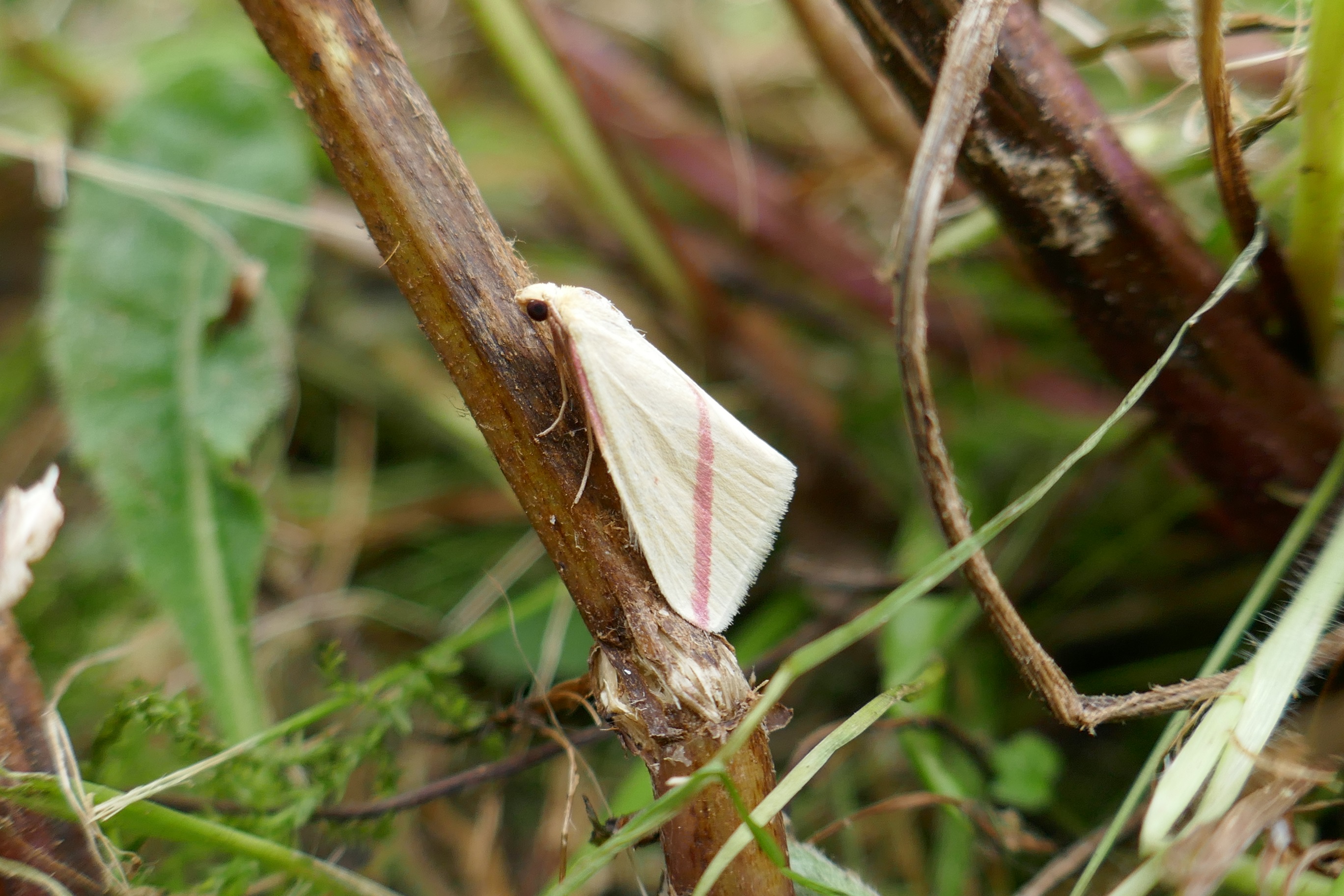 The Vestal, a rare migrant in Jesmond Harding’s garden, 9th September 2023. Photo J.Harding.
The Vestal, a rare migrant in Jesmond Harding’s garden, 9th September 2023. Photo J.Harding.
The Red Admiral, Peacock and Small Tortoiseshell were ubiquitous, with the latter doing magnificently in 2023, with high numbers in and outside gardens. The Painted Lady was distributed well too, but some gardeners missed it last year and nobody had high figures for it.
The Comma’s expansion north and west is being picked up by gardeners. Lesley Whiteside and Richella Duggan have recorded this amazing butterfly in Westmeath, Enda Flynn in Louth but it has not appeared in Brian’s MacDomhnaill’s garden in Monaghan yet, in Felicity Law’s garden in west Cork or Marilyn’s garden in west Kerry. It should reach these areas if the expansion continues as expected.
While the Meadow Brown and Speckled Wood were found in all gardens the numbers varied; the male Speckled Wood is territorial so numbers in most gardens are usually low; the Meadow Brown and Ringlet are more social and much more tolerant of their kind, allowing numbers to build if the habitat is sizable and suitable. Because the Meadow Brown is less specialised, occurring in open and partly shaded areas, in long and short swards, it is often more numerous in gardens. With the right mix of grassy habitats and space for these, more can be achieved. Peak counts of 15 Ringlets and 26 Meadow Browns were made by Robert Donnelly. Jesmond Harding recorded 15 Meadow Browns on two dates; the Ringlet occurs in much lower numbers in gardens, probably because it needs much taller grassland usually on moist soils with some shade.
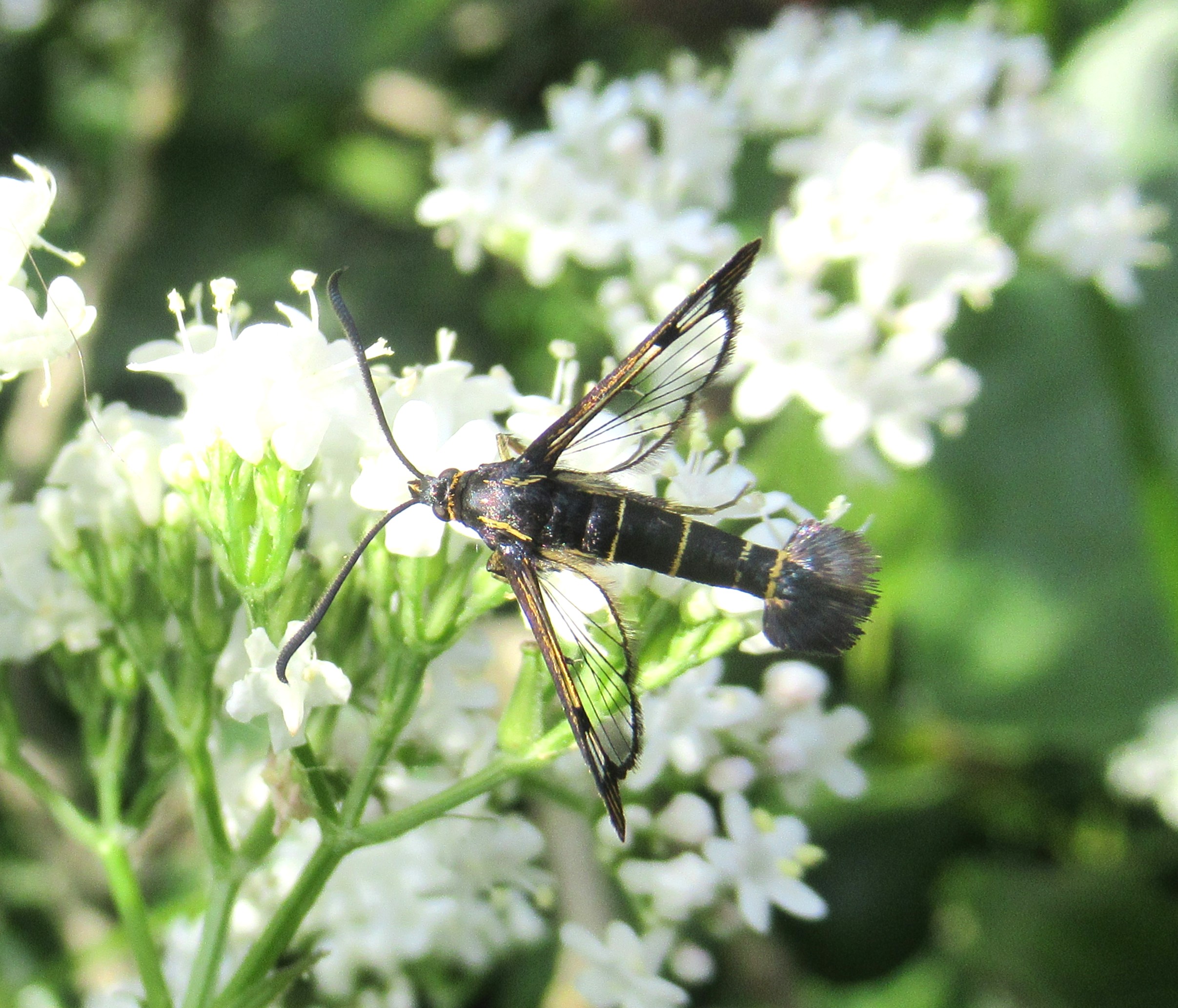 A Currant Clearwing moth in Pat Bell’s garden in Maynooth. Photo Pat Bell.
A Currant Clearwing moth in Pat Bell’s garden in Maynooth. Photo Pat Bell.
The earliest butterfly recorded was a Red Admiral on 16th February, and the last butterflies recorded were, jointly, a Holly Blue and a Small Tortoiseshell on 22nd October in the same garden in Portmarnock. Other notable garden records are the Currant Clearwing moth, a very rare day-flying moth recorded in Ireland in just ten 10km squares (out of 1019 10km squares) since 2000 recorded by Pat Bell and Hummingbird Hawkmoths by Pat Bell and Michael Gray. Another record of note is a Small Tortoiseshell caterpillar found on a nettle on 27th October in Brian MacDomhnaill’s garden in Monaghan; this is a very late record for this butterfly and suggests that the good autumn weather allowed for a third generation.
How Important are Gardens for Butterflies?
We do not have Irish research to call on, but in Britain, the British Trust for Ornithology reported that the UK’s gardens are acting as a safe haven for butterflies. This study, the first of its kind to look at UK butterfly population trends in gardens separately from trends in the wider countryside, found that half of the 22 species considered saw a significant increase in their abundance within study gardens between 2007 and 2020. Although there was a corresponding increase in the abundance of butterfly populations across different non-garden habitats, on average the increases seen in gardens were greater.
The study uses UK-wide data gathered by almost 8,000 volunteers participating in the BTO Garden BirdWatch (GBW) scheme, which records other garden wildlife in addition to birds on a weekly basis.
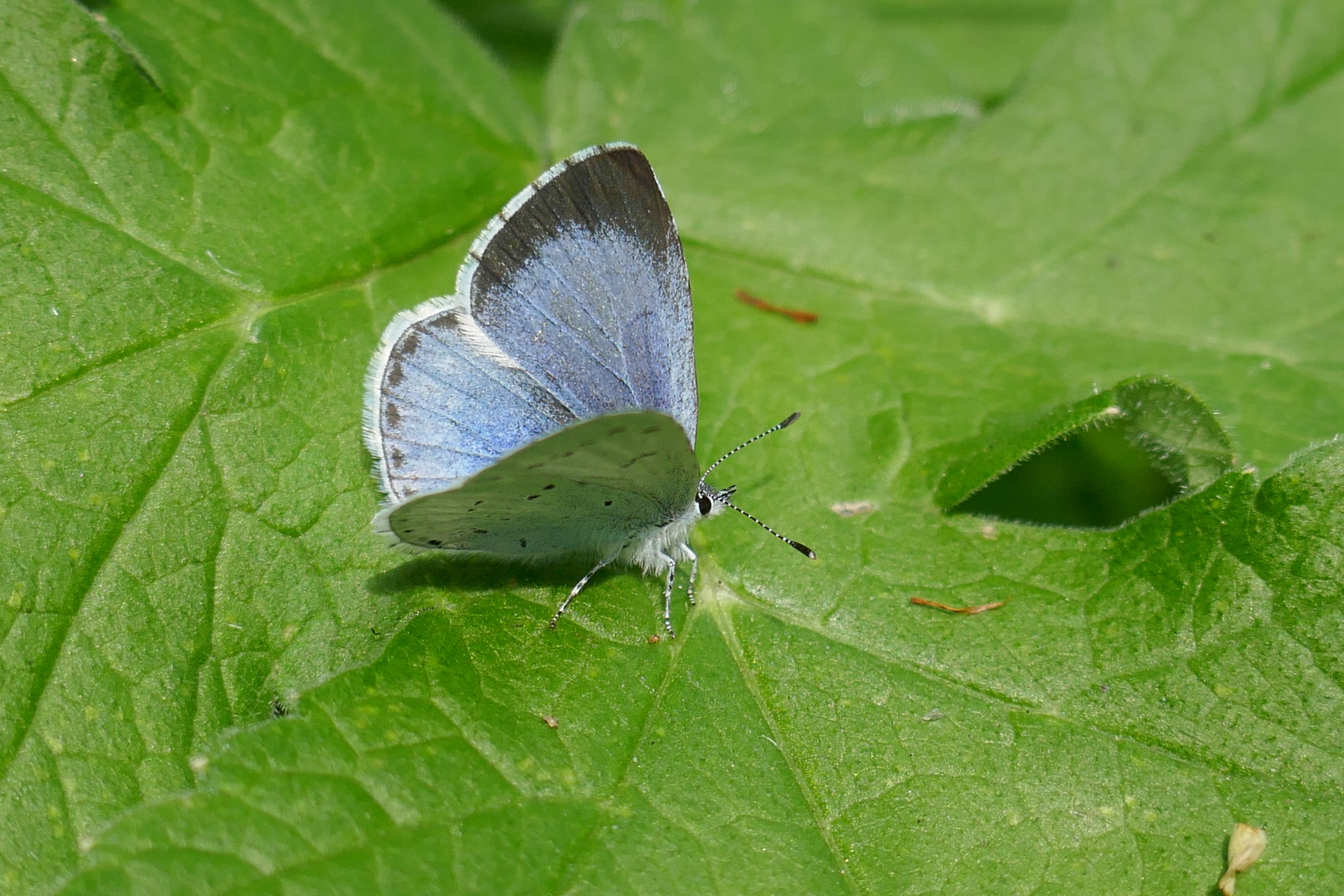 The Holly Blue has increased in gardens in Ireland and Britain. Photo J. Harding
The Holly Blue has increased in gardens in Ireland and Britain. Photo J. Harding
Numbers of Small Skipper, Brimstone, Orange-tip, Holly Blue, Ringlet doubled. It is unclear why these and other species are doing so well in gardens, but gardens could be providing valuable refuge and feeding opportunities for adult butterflies. The study found strong similarities between these new, garden-focused butterfly population trends and those previously reported more broadly by the UK Butterfly Monitoring Scheme (UKBMS). This suggests that patterns of abundance in gardens are largely a reflection of the changes that are occurring nationally in the UK. However, given that numbers are increasing to a greater extent in gardens than in wider countryside habitats, the study suggests that gardens may have an important role to play in sustaining the UK’s butterfly populations now and in the future.
Effective monitoring of butterflies in gardens allows us to determine how population trends might vary across different habitat types so we can better understand the impacts of human activities on wildlife more broadly. Private gardens are often difficult to access, however, so coverage using professional surveys has often been poor. This citizen-science approach, engaging garden owners in the collection of information on butterflies, is an important step towards understanding the role that private gardens can play in butterfly conservation.
Importantly, the study’s findings highlight that individual garden owners have a role to play in protecting and enhancing UK butterfly populations through their gardening choices.
Dr Kate Plummer, BTO Senior Research Ecologist and lead author on the paper, says: “It is extremely encouraging to see that gardens are contributing to the population growth of some of the UK’s widespread butterfly species. We are increasingly finding that gardens are crucial for biodiversity conservation, and these new findings certainly support that. Ongoing monitoring… will help us to better understand how to maximise the positive environmental impacts of our gardening activities.”
Dr Emily Dennis, Senior Ecological Statistician at Butterfly Conservation, says: “This new study suggests that gardens may play a role in supporting populations of some of the UK’s widespread butterfly species, and encourages the positive contribution that adopting wildlife-friendly gardening practices, such as planting suitable nectar plants, can have in helping support common wildlife populations.”
Gardens in Ireland can also play this positive role if the gardens are managed with the needs of butterflies involved, with nectar for adult butterflies and foodplants for their caterpillars, with vegetation cover for overwintering caterpillars, pupae and adult butterflies. Native plants are best as nectar for adults and foodplants for caterpillars. The much-maligned Common Nettle is very important, along with members of the pea family, especially Common Bird’s-foot-trefoil, Meadow Vetchling, Bush and Tufted Vetch. Other very important plants are bramble, Grey Willow, dandelions, Common Holly and Common Ivy, Cuckoo Flower, Common Knapweed and Devil’s-bit Scabious, to mention a few.
Thank You
A very special thanks is due to all our garden butterfly surveyors, on whose data this report is based. Our gardens provide important places for our butterflies, which are only attracted to gardens that contain the resources they need. Without your help, your local butterflies might be under even more pressure than they are.
References
Butterflies find safe haven in UK gardens, new research reveals https://butterfly-conservation.org/news-and-blog/butterflies-find-safe-haven-in-uk-gardens-new-research-reveals accessed 18 January 2024
MEET THE BURNETS
There are seven burnet moths recorded in the British Isles. They are day-flying black and red moths, and anyone who has visited a beach in summer is certain to have seen at least one of the Burnet family. Scientifically, the family is Zygaenidae, and in these islands, it includes three similar-looking forester moths. These are the Forester Adscita statices, Scarce Forester Jordanita globulariae and Cistus Forester Adscita geryon. These day flyers are known for their lovely, gleaming, emerald forewings.
The burnets are Scotch Burnet Zygaena exulans, Slender Scotch Burnet Zygaena loti, New Forest Burnet Zygaena viciae, the aptly named Six-Spot Burnet Zygaena filipendulae and Five-Spot Burnet Zygaena trifolii, Narrow-bordered Five-spot Burnet Zygaena lonicerae, and finally the Transparent Burnet Zygaena purpuralis.
In total, there are 10 species in the family Zygaenidae in Britain and Ireland, but in Ireland, the family is represented by four: Forester moth, Six-spot Burnet, Narrow-bordered Five-spot Burnet and Transparent Burnet. Only one, the Six-spot Burnet, is widespread and abundant, with records throughout most of Ireland but with a strong coastal bias. It breeds mainly on Common Bird’s-foot-trefoil and some populations are enormous. I once found mature caterpillars in their hundreds in a few square feet of trefoil-rich dunes in Portrane in north County Dublin. Adults fly in sunshine from late June to August when dozens will be seen vying with each other and with Common Blues and Meadow Browns to feed on thistles and Common Ragwort. This is easily the most recorded moth on Butterfly Conservation Ireland’s database, especially because summer beachgoers report it to us.
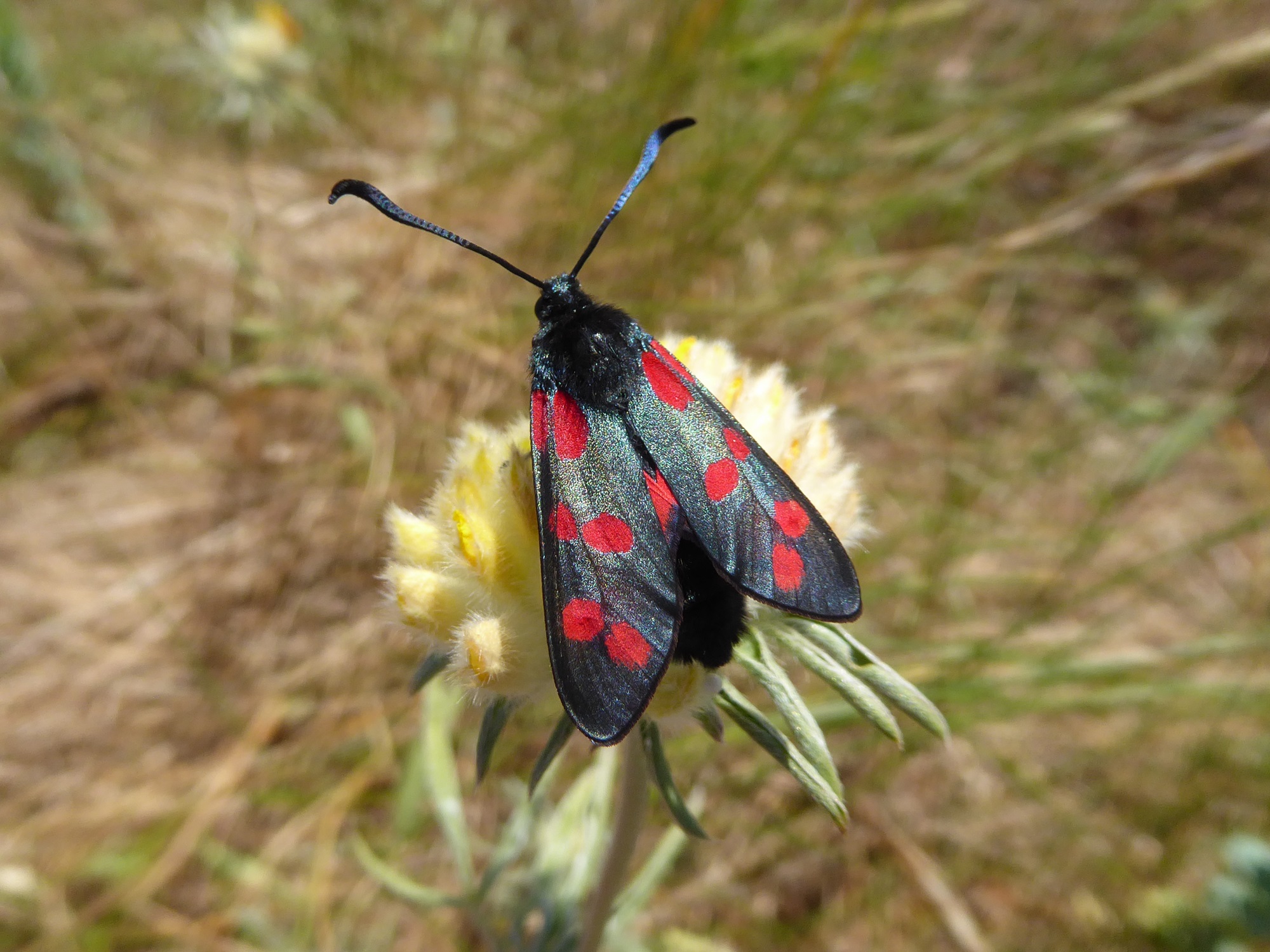 Six-spot Burnet moth on Kidney Vetch, Portrane, County Dublin. Photo J. Harding.
Six-spot Burnet moth on Kidney Vetch, Portrane, County Dublin. Photo J. Harding.
The bright yellow caterpillar, marked with black, looks very like the caterpillar of the much rarer Narrow-bordered Five-spot Burnet which strongly prefers Meadow Vetchling.
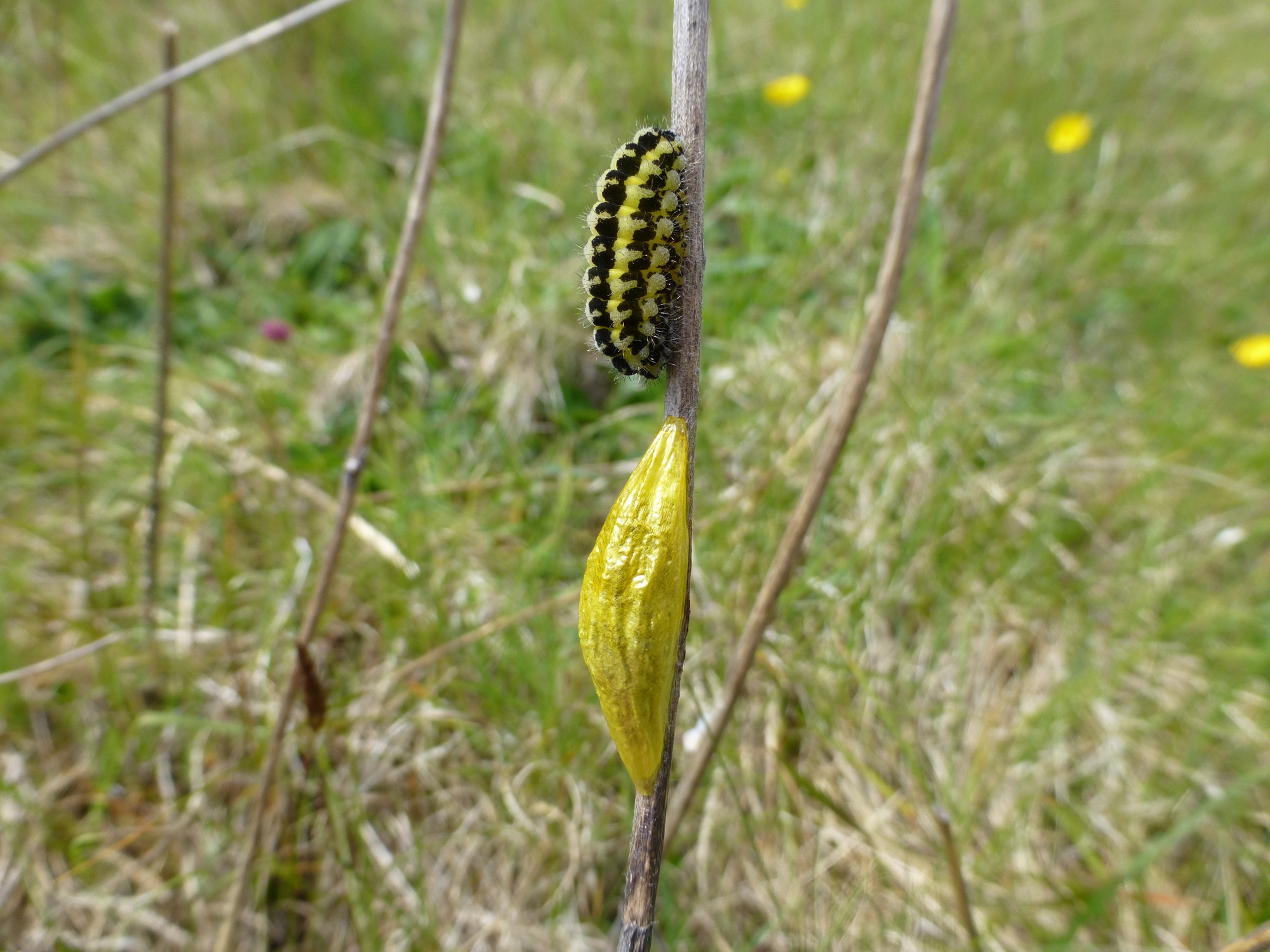 Six-spot Burnet moth cocoon below and caterpillar above. Photo J. Harding.
Six-spot Burnet moth cocoon below and caterpillar above. Photo J. Harding.
According to the distribution maps provided by mothsireland, the Six-spot Burnet has been recorded in 47% of Ireland’s 10km squares, while the Narrow-bordered Five-spot Burnet has been found in just 11.7% of Ireland’s 10km squares. The Transparent Burnet is rarer still, occupying just 3% of our 10km squares. The Forester moth has a presence in 7% of the country’s 10km squares but is more widely distributed than the Narrow-bordered Five-spot Burnet, which occurs mainly in the northern counties, especially in Fermanagh, Armagh and Antrim, and the Transparent Burnet, found mostly in limestone areas in north Clare, adjoining habitat in southeast Galway with outliers in north Galway and south Mayo, and one north Limerick location.
The conservation status of Ireland’s larger moths is contained in the Red List for Macro Moths drawn up using the criteria laid down by the International Union for the Conservation of Nature (IUCN). Published by the National Parks and Wildlife Service in 2016 it categorises the conservation status of Ireland’s larger moths according to hierarchy ranging from Least Concern to Regionally Extinct. The categories are: Least Concern, Near Threatened, Data Deficient, Endangered, Critically Endangered and Regionally Extinct. There is another category, Not Assessed, which applies to species that are migrants and whose appearance in Ireland depends on conditions overseas, to species that are not considered to be established here (adventive) and to species that have been resident in Ireland for less than 10 years before 2012. Under the IUCN criteria, the Six-spot Burnet and Transparent Burnet is rated Least Concern, the Narrow-bordered Five-spot Burnet is Vulnerable and unfortunately, the Forester is Endangered.
The Red List states:
This declining moth (the Forester) is found in uncultivated damp grassland, fens, sea-cliffs and the margins of coastal wetlands. The larvae feed on Sheep’s Sorrel Rumex acetosella and Common Sorrel R. acetosa. The day-flying adults feed on the nectar of many species of flowering plant and the flight period covers all of June and July. It has a wide distribution in Ireland although it is very local and there have been widespread losses throughout as habitats have been lost.
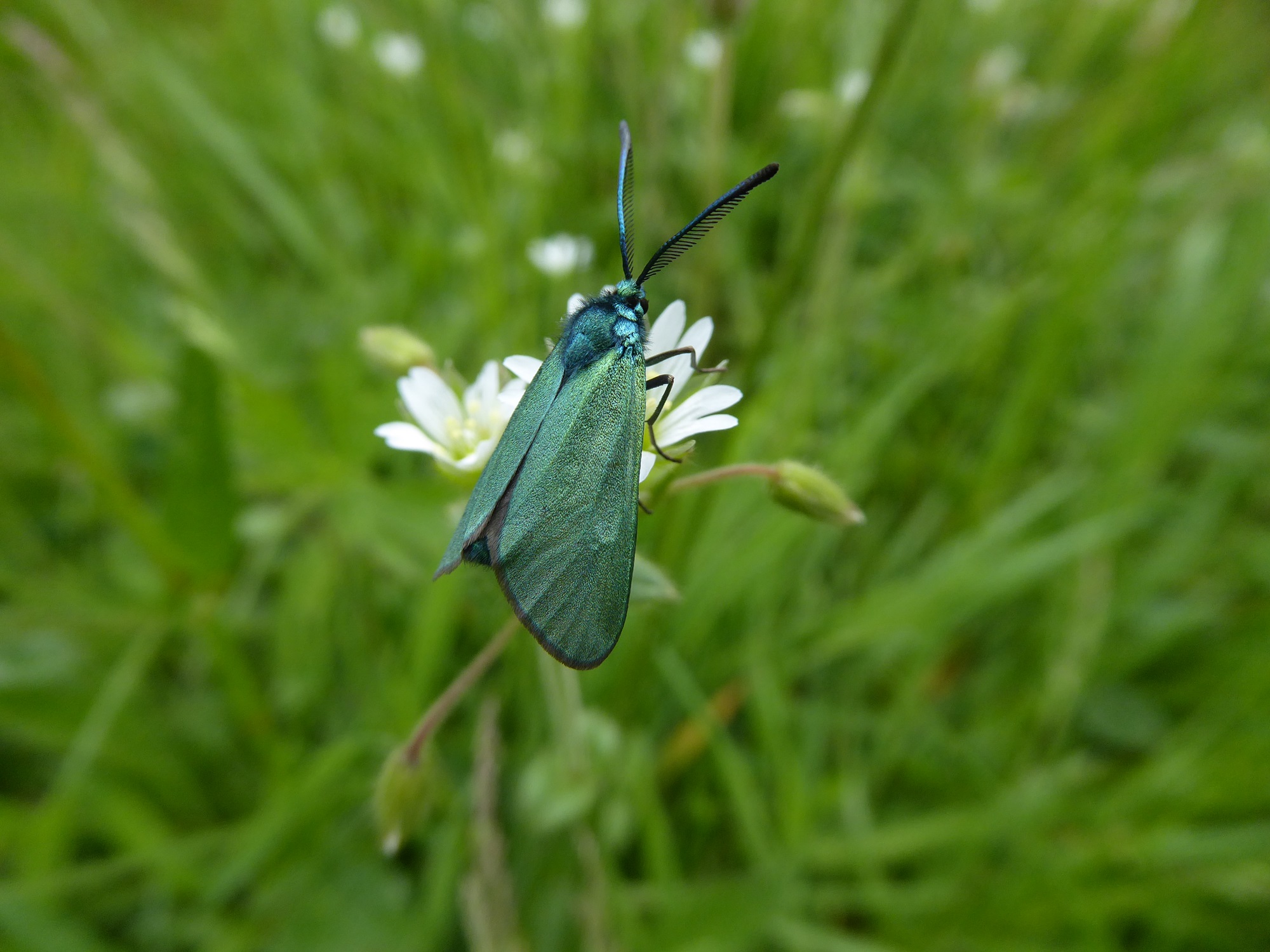 Forester moth on Mossy Saxifrage, Clooncoose, County Clare. Photo J. Harding.
Forester moth on Mossy Saxifrage, Clooncoose, County Clare. Photo J. Harding.
Alarmingly, the moth was recorded in a mere 25 10km squares during 2000-2012; it was found in 47 10km squares pre-2000. The maps show it has not been re-recorded in many areas of Northern Ireland where it was known before 2000. I have seen the moth in four areas; North Drehid Bog, Lullybeg, both in County Kildare, the Burren National Park and Clooncoose Valley, both County Clare. Clooncoose Valley is the only place I have seen this beautiful sylph in abundance. In that area, it breeds on the abundant sorrels rooted in the mossy carpet draped over the magnificent carboniferous limestone slabs.
The habitat here, interestingly, does not correspond to that described in the Red List; the area is on a steep hill. But the moss holds the moisture typically found in the Forester’s habitat. My observations of the habitats suggest that it requires nutrient-poor soil conditions. While the loss of its wetland homes has caused it to decline, it is disappearing from its remaining habitats too.
It might be a victim of pollution, especially of atmospheric nitrogen deposition. This is a result of global emissions of oxidised nitrogen (NO, HNO3 and NO2 – often referred to as NOy) from fossil fuel combustion, and reduced N (NHx) from agricultural sources. Only great changes in how we create energy and farm can solve that problem.
The effect of atmospheric nitrogen loads and climate change on an area of calcareous grassland are the subject of a paper Butterfly community shifts over two centuries by Habel et al. (2015). The study analysed changes in the species composition of a southeastern German butterfly and burnet moth community over nearly two centuries (1840–2013). They classified all species observed over this period according to their ecological tolerance, thereby assessing their degree of habitat specialisation. This classification was based on traits of the butterfly and burnet moth species and on their larval host plants. The researchers collected data on temperature and precipitation for their study area over the same period. The number of butterfly and burnet moth species declined substantially from 1840 (117 species) to 2013 (71 species).
The proportion of habitat specialists (species that rely on a narrow range of environmental conditions or have a limited diet) decreased, and most of these are currently endangered. In contrast, the proportion of habitat generalists increased. Species with restricted dispersal behaviour and species in need of areas poor in soil nutrients had severe losses. These data on species composition changes and the general trends of modifications may reflect effects from climate change and atmospheric nitrogen loads, as indicated by the ecological characteristics of host plant species and local changes in habitat configuration (layout, arrangement) with increasing fragmentation.
Species that like need nutrient-poor habitats declined or disappeared while species that like enriched soil increased in abundance. In total, 136 butterfly and burnet moth species were recorded in the study area from 1840 to 2013. The highest species numbers (117 to 123 species per decade) were observed from 1840 to 1880, in other words, just before Germany became industrialised. The period 1970–2013 had the lowest total number of species (121; 71–107/decade). The study found a significant negative correlation between the nutrient requirements of host plants and the proportion of endangered butterfly and burnet moth species, most of which depend on plants of nutrient poor sites. Furthermore, dominance of a few habitat generalists adapted to nitrogen-loving plants (like Common Nettle) increased.
Another study shows that applying Nitrogen fertiliser to grassland affects caterpillar survival rates (Kurze et al. 2018). One of the species shown to be affected by increasing Nitrogen is the Small Copper, which, like the Forester, breeds on Common Sorrel and Sheep Sorrel. The foodplant also died when Nitrogen concentration exceeded the plant’s tolerance.
Nitrogen pollution, if it is having the effect these studies suggest, is a very serious problem for biological conservation, and might be beyond the ability of any site management system.
The easiest step that can be taken immediately is a drastic reduction in nitrate applications on farmland, a step that is strongly resisted by farming organisations who fear the drop in productivity. There is little doubt that agricultural intensification has gravely damaged wildlife.
The Narrow-bordered Five-spot Burnet is also currently regarded as under threat, and ranked Vulnerable. The Red List makes the following remarks about its habitat, distribution and decline.
This is a day-flying species of unimproved, flower-rich, lowland grassland. The larvae can develop on a variety of herbs including trefoils Lotus spp. and clovers Trifolium spp. Adults are on the wing in June and July. The distribution is markedly northern and most occupied hectads are in southern counties of Northern Ireland with just a scattering of occupied sites in the Irish midlands as far south as Cos. Tipperary and Laois. The species may however have been overlooked or not distinguished from the more common Six-spot Burnet Z. filipendulae. Some new colonies have appeared on abandoned sites but these gains have not balanced out extensive losses of colonies since the 1970s and hence the species was assessed as Vulnerable.
The distribution maps provided on the Red List tell a grim tale. The pre-2000 maps show it in 42 10km squares but the 2000-2012 map shows it in just 25 10km squares, out of 1019 10 km squares. However, my observations suggest that this handsome moth is much better distributed than shown in the Red List maps. I have found it in several additional squares; it certainly occurs in Lullymore, Lullybeg (Square N62), Timahoe North/Drehid North (Square N73), Pollardstown (Square N71), all County Kildare, in the Native Woodland Trust Reserve, Burgage (Square N91), Co. Wicklow. Other squares I have recorded it in are O17 (Mornington, Meath), N94 (Mulhussey, Meath), and N93 (Louisa Bridge, Kildare). I even found it on an embankment on the M4 while I was waiting for the AA to replace my punctured tyre! Other recent records come from O24 (Baldoyle, Dublin) O23 (Sutton, Dublin) and O10 (Laragh, Wicklow). The map on the Mothsireland website also shows it to be much better distributed than the Red List maps do, but there are still very large areas where it appears to be absent.
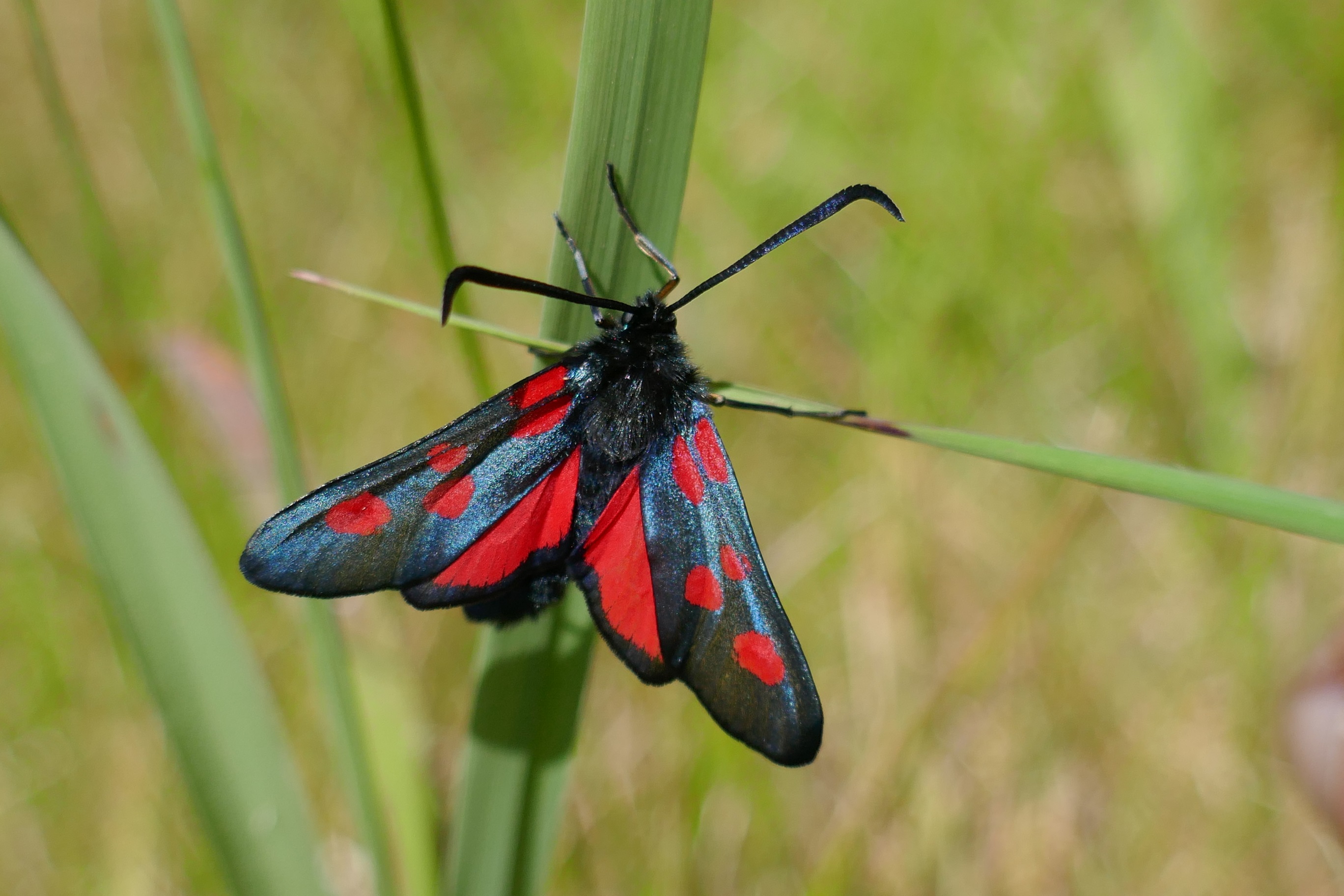 Narrow-bordered Five-spot Burnet moth, The Burgage, near Russborough House, County Kildare. Photo J. Harding.
Narrow-bordered Five-spot Burnet moth, The Burgage, near Russborough House, County Kildare. Photo J. Harding.
The Narrow-bordered Five-spot Burnet is less specialised than the Forester. It occurs on unfertilised well-drained and wet grassland, if the foodplant is present and grazing is not intense. The moth also seems to be mobile, and individuals have been found distant from known sites, including in housing estates. This suggests an ability to occupy new sites when they become available, and it has been recorded on recently created sites. The moth flies in June and July, and feeds avidly on nectar. Like the Six-spot Burnet, mating pairs are often found high on robust plant stalks, often near yellow pupal cases.
The Transparent Burnet moth occurs in the most restricted distribution but is ranked Least Concern. Why is this? Although mainly found in the Burren in north Clare, it is abundant there and its habitats are currently managed very sympathetically. It breeds on just one plant, Wild Thyme, but the plant is abundant. Like the other burnets and Forester, it overwinters in the caterpillar stage and resumes feeding in spring. The adult moth flies in June and July and has the curious habit of resting during rain on the top of a flower, often for days, when it is exposed to precipitation. At the peak of the flight period, many will jostle for nectar on mats of sweetly fragrant Thyme. This moth occurs in Ireland as subspecies sabulosa that boasts deeper, clearer red on the forewing upperside than the other three subspecies present in Britain. For me, seeing this crimson and black beauty is an essential part of the Burren in June.
Long may these brightly coloured day-flying moths continue to brighten our landscapes. The character they bring must not be allowed to dissipate. If you are fortunate to have the room, grow their foodplants, and the moths might appear. Three of the four (Transparent Burnet aside) might find your homestead. If they do, lucky you!
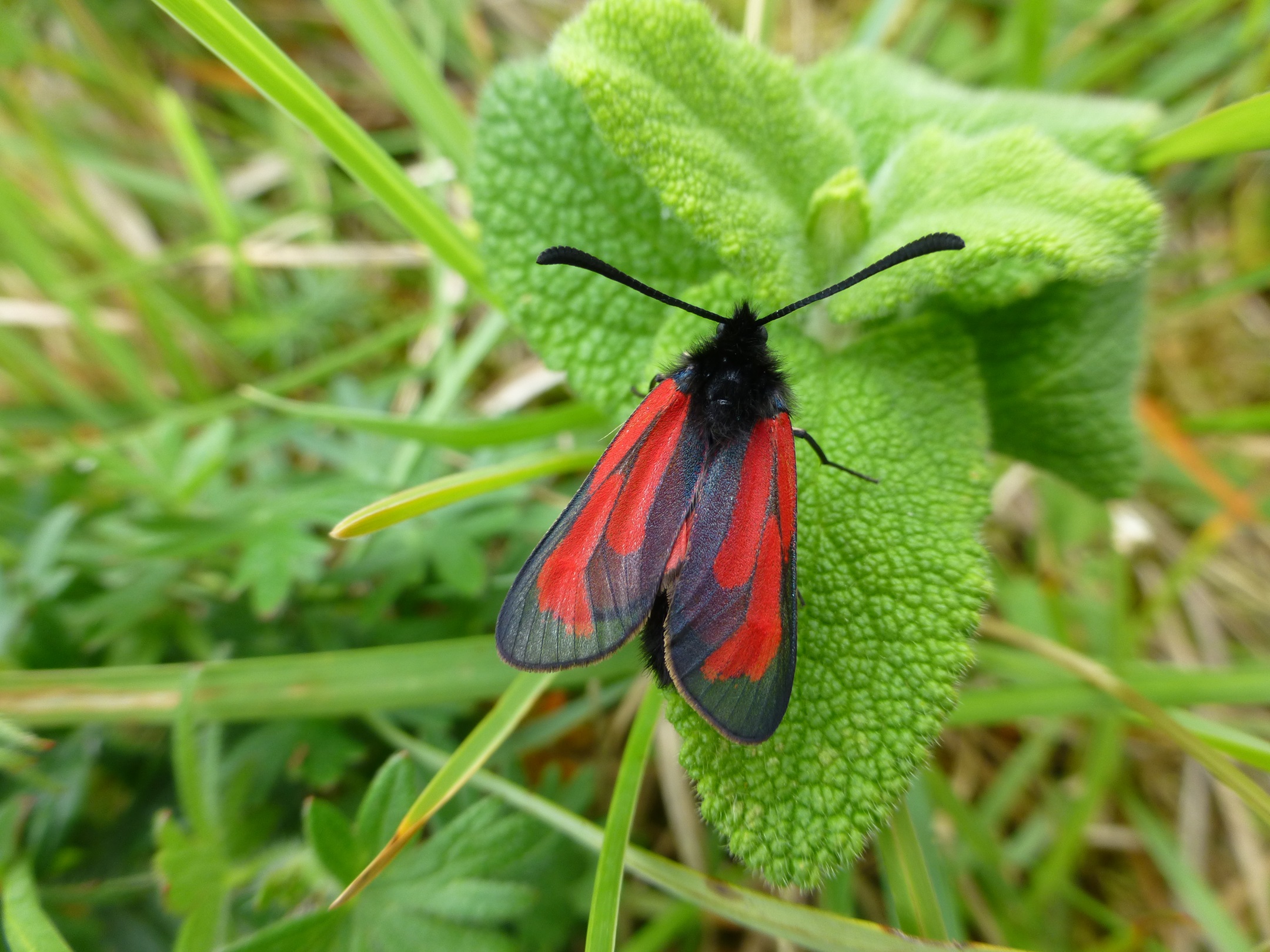 Transparent Burnet on Wood Sage, Coolorta, County Clare. Photo J. Harding.
Transparent Burnet on Wood Sage, Coolorta, County Clare. Photo J. Harding.
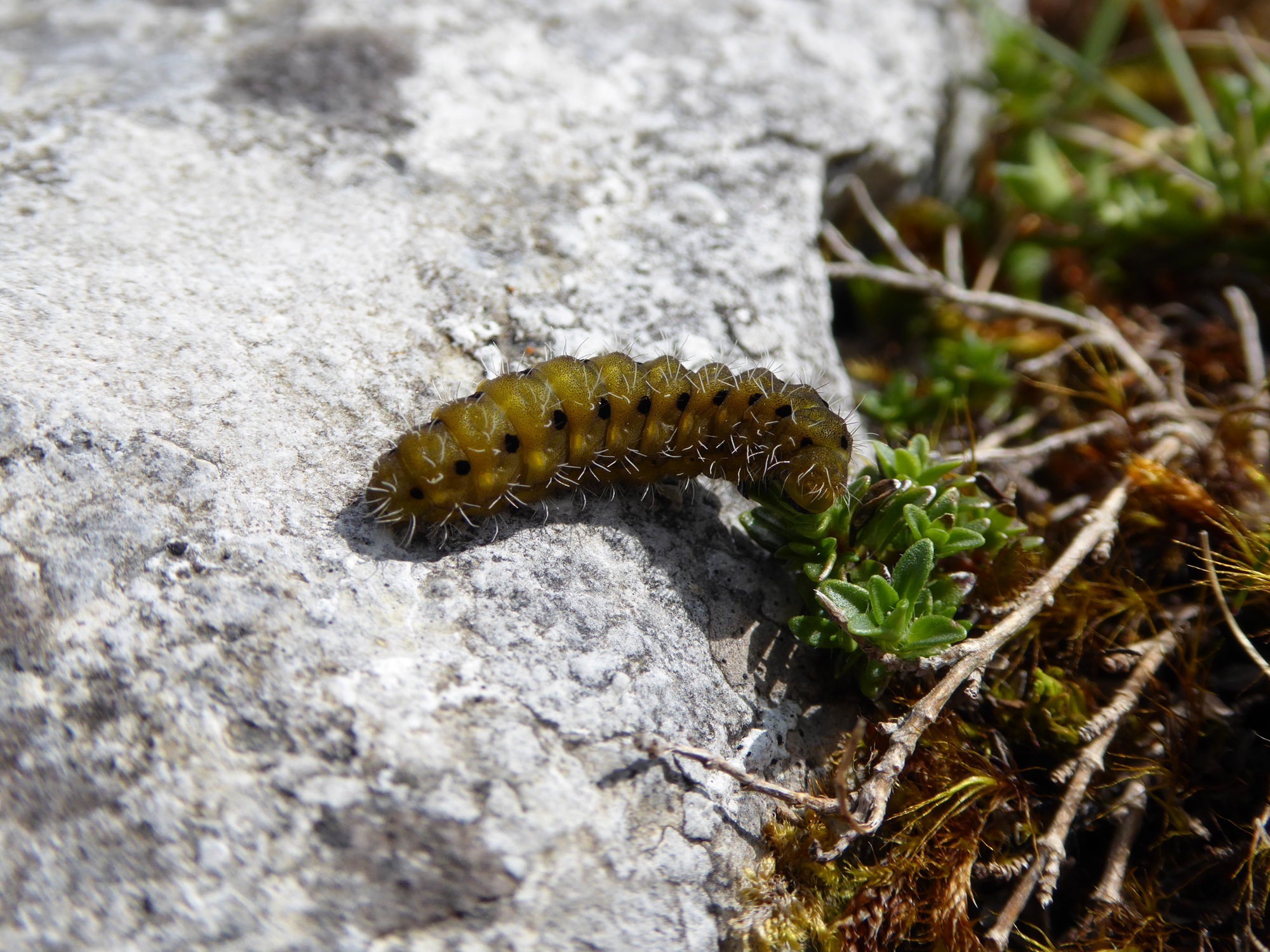 Transparent Burnet caterpillar feeding on Thyme, Lough Avalla Loop Walk, County Clare. Photo J. Harding.
Transparent Burnet caterpillar feeding on Thyme, Lough Avalla Loop Walk, County Clare. Photo J. Harding.
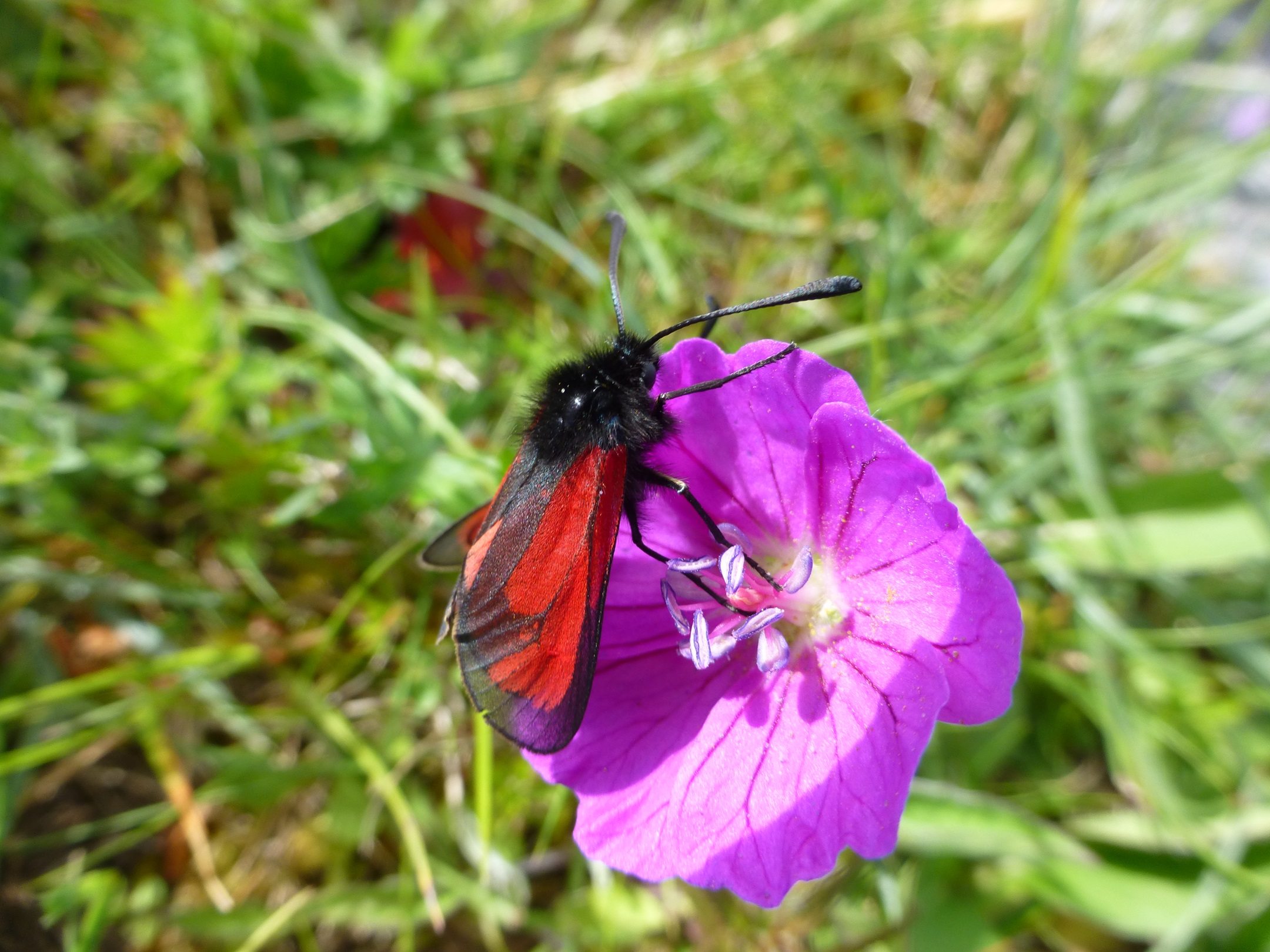 Transparent Burnet on Bloody Cranesbill. Photo J. Harding.
Transparent Burnet on Bloody Cranesbill. Photo J. Harding.
References
Allen, D., O’Donnell, M., Nelson, B., Tyner, A., Bond, K.G.M., Bryant, T., Crory, A., Mellon, C., O’Boyle, J., O’Donnell, E., Rolston, T., Sheppard, R., Strickland, P., Fitzpatrick, U., & Regan, E. (2016) Ireland Red List No. 9: Macro-moths (Lepidoptera). National Parks and Wildlife Service, Department of Arts, Heritage and the Gaeltacht, Dublin, Ireland.
Habel, J.C., Segerer, A., Ulrich, W., Torchyk, O., Weisser, W.W. & Schmitt, T. 2016, “Butterfly community shifts over two centuries”, Conservation biology, vol. 30, no. 4, pp. 754-762.
Kurze, S., Heinken, T. & Fartmann, T. 2018, “Nitrogen enrichment in host plants increases the mortality of common Lepidoptera species”, Oecologia, vol. 188, no. 4, pp. 1227-1237.
Air Pollution Information System (2023) (online). Available at https://www.apis.ac.uk/overview/pollutants/overview_n_deposition.htm#:~:text=What%20is%20it%3F,in%20precipitation%20as%20wet%20deposition. (Accessed 26 December 2023)
Mothsireland (2023). (Online) Available at https://www.mothsireland.com/maps-overview/maps-macro-english/ (Accessed 16 December 2023)
Waring, P., Townsend M. and Lewington, R. (2017) Field Guide to the Moths of Great Britain and Ireland. Bloomsbury, Dublin.
SPECIES FOCUS: SPECKLED WOOD
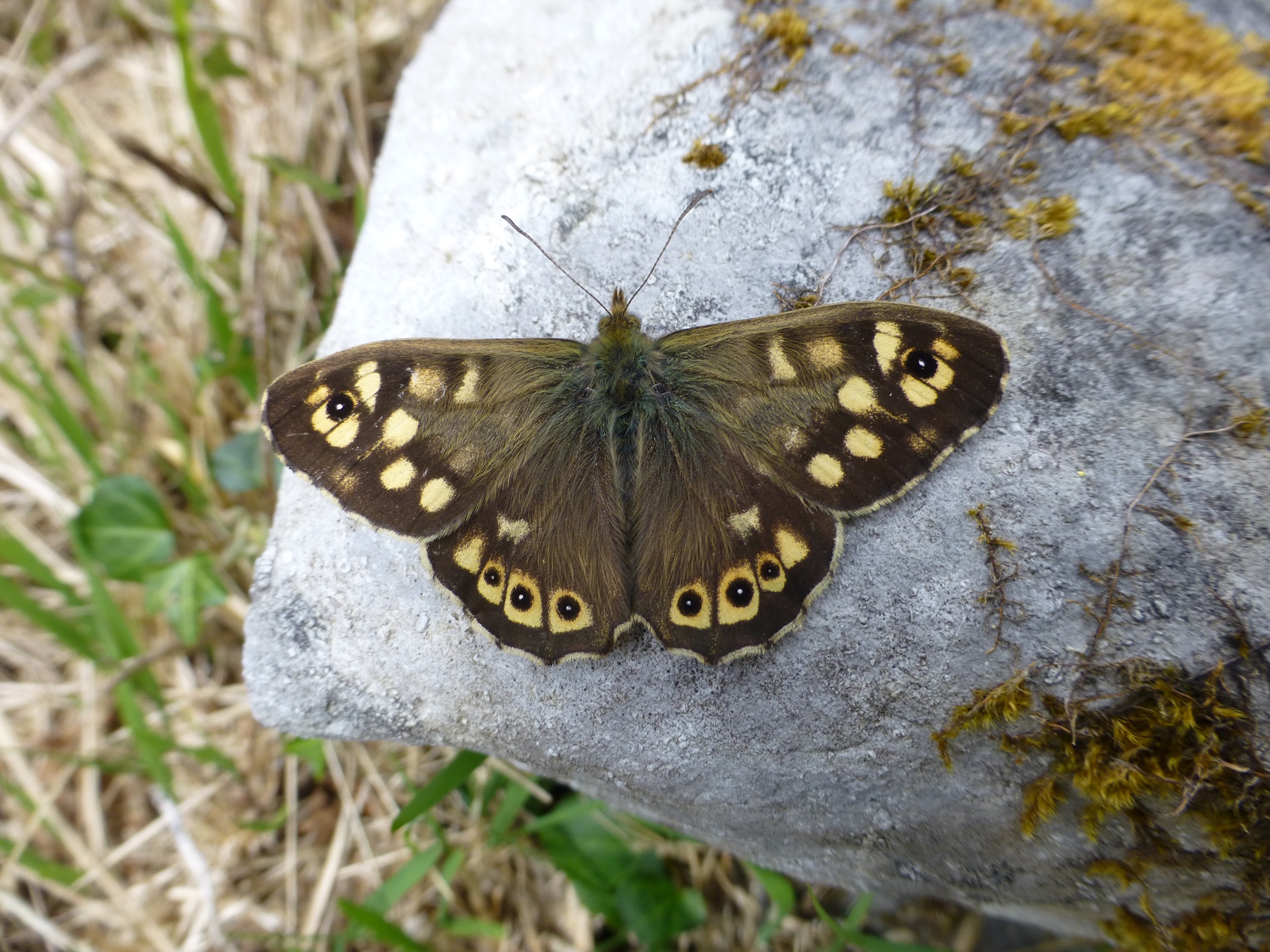 Speckled Wood male, spring generation, April 18th 2014 (Photo taken at Knockaunroe, Clare). Photo J. Harding.
Speckled Wood male, spring generation, April 18th 2014 (Photo taken at Knockaunroe, Clare). Photo J. Harding.
The Speckled Wood is a classic woodland and wood edge butterfly, able to tolerate more shaded conditions than any other Irish butterfly. The butterfly can be seen in most months of the year and is only fully grounded between early November and late March. The remarkably variable growth rate of the caterpillar means that the butterfly emerges over a very long period giving the impression that the butterfly is long-lived. However, in the wild, each butterfly lives about five days.
Despite not having the bright colours and dramatic flight of the more charismatic butterflies, the Speckled Wood is a very interesting species, both for its behaviour and life cycle. The following describes some of these features and includes some recent research findings.
On its upperside, the Speckled Wood is a chocolate brown butterfly with cream-coloured spots. White-pupiled eye spots are located on the upperside of the forewing (one on each) and hindwing (three on each). The forewing underside is similar but brighter than the upperside. The hindwing underside is mainly pale brown with a purplish tinge. This purple haze is often absent from specimens in England and is sometimes lacking in Irish examples.
The spring generation from the over-wintered pupa has larger spots that are a richer cream than those of the summer generation. Males are distinguished from females by their smaller size with typically a 47mm wingspan, (50mm for females) the smaller size of their cream spots and their behaviour.
The Speckled Wood is a woodland, hedgerow and scrubland butterfly breeding on tall wild grasses in damp and humid places.
The first Speckled Woods are usually seen in April, emerging from over-wintering pupae. These overlap in June with those that over-wintered as caterpillars. This explains why the first brood that emerges in spring and early summer lasts so long even though the adult butterfly is short-lived. A dip or a gap occurs during July. However, from late July lasting well into September, there is an extended emergence resulting from larvae produced during April-July. Not all spring larvae produce second-generation butterflies. According to Thomas and Lewington (2014) some develop slowly and form over-wintering pupae in autumn.
A smaller third brood flies in late September and October resulting from the second brood. The occasional Speckled Wood is found in November. Not all the second brood’s larvae develop at the rate needed to produce third brood butterflies in the year they hatch from the egg. These caterpillars will over-winter as pupae or larvae, while the third brood’s offspring will probably pass the winter in the larval state. This is not a universal rule as warm conditions and lengthy sunlight may result in some of the third brood producing pupae before winter (Thomas and Lewington 2014). The research suggests that the individual Speckled Wood larvae vary greatly in their response to light and temperature (Eeles 2019). This variability explains the complexity of the brood structure.
While Emmet et al. (1990) and Eeles (2019) state that the larva can overwinter successfully only in the third instar with extreme cold killing the other instars, the fourth instar larvae I am observing inland in County Meath survived the extremely low temperatures during January 2024. Different populations of the Speckled Wood may vary in their responses to environmental conditions, highlighting the necessity of carrying out breeding studies in Ireland instead of relying on the findings of British and European research. My captive breeding during 2023-2024 does support Eeles’ point that Speckled Wood larvae can develop at markedly different rates. Thus, at the time of writing on 20th January 2024, the larvae, which hatched together on 12th and 13th September 2023, are now in the third instar (c.9-12mm in length), or fourth instar (c.21mm in length; fully grown larvae reach c.28mm) or in the pupal stage.
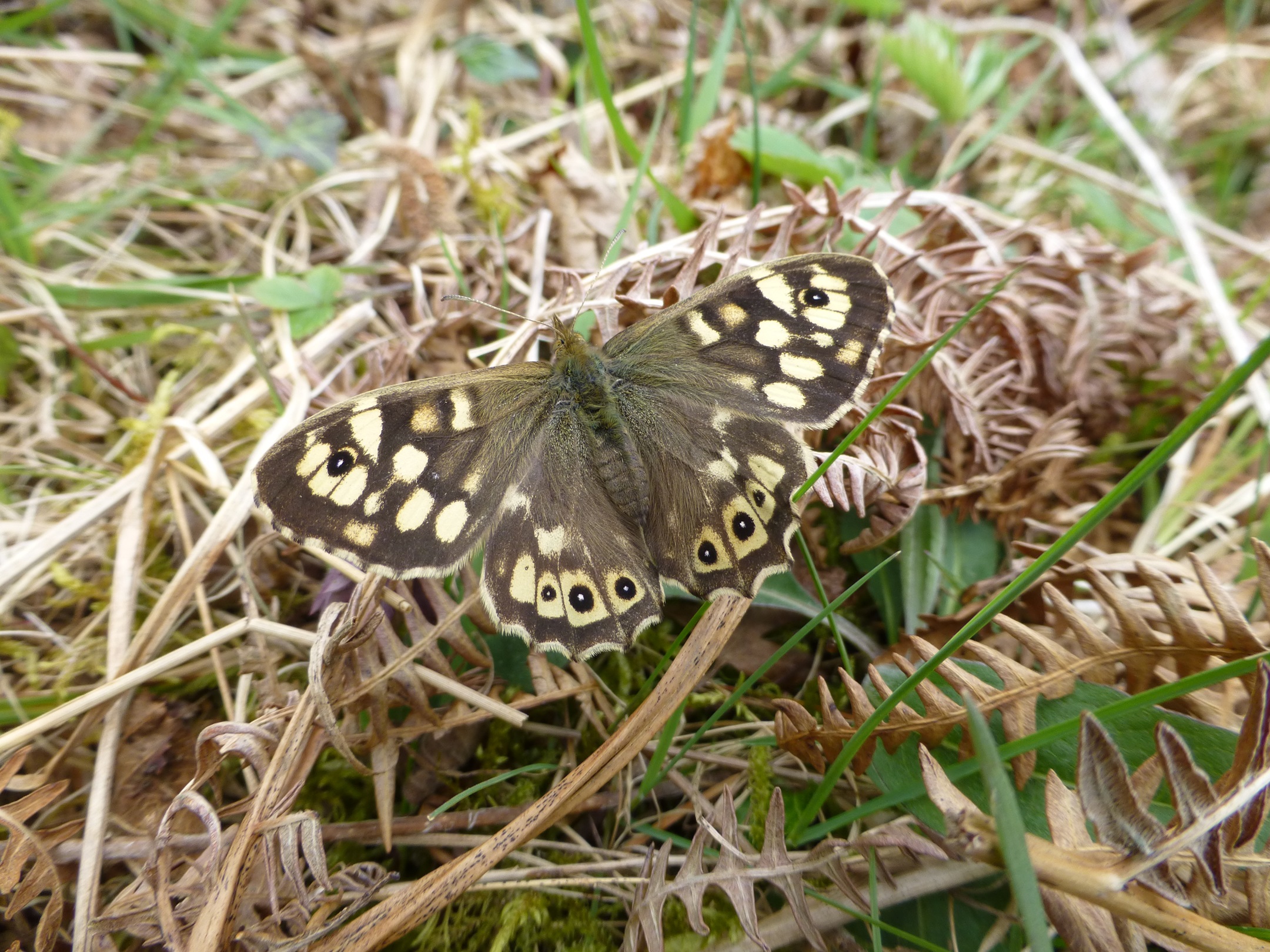 Speckled Wood female, spring generation, April 18th 2014. (Photo taken at Knockaunroe, Clare). Photo J. Harding.
Speckled Wood female, spring generation, April 18th 2014. (Photo taken at Knockaunroe, Clare). Photo J. Harding.
The adult male butterfly behaves differently depending on its anatomy, the time of year, the time of the day and temperature (Thomas and Lewington 2014). Males find females using patrolling and perching strategies. There is evidence that some males are more anatomically suited to one mate-seeking strategy (Thomas and Lewington 2014). Patrolling an area of woodland edge, clearing or hedge may increase his chance of encountering a female, but this requires much more energy, and higher temperatures and increases the likelihood of predation. Patrolling may mean less territorial behaviour, resulting in fewer fights with other males. Cooler spring and lower morning temperatures favour perching over patrolling.
Perching involves a male selecting a sunny sheltered area of shrubbery, a woodland edge or a glade and waiting on a leaf (or sometimes on the ground). The male will undertake an occasional inspection of his territory before returning to his perch. Any male who enters the territory is attacked and males spiralling in close circles are a common sight in sunlit clearings during the summer. These battles often see the butterflies drifting across a glade or road. When engaged in territorial disputes they are oblivious to danger and can be struck by traffic or snatched by predators. Occasionally, the combat occurs on the ground where head-butting occurs. The occupant of the territory always wins the battle against an intruder who quickly withdraws, but the prolonged conflict described here occurs when both males ‘think’ they are the residents (Davies 1978).
Virgin females sometimes advertise themselves by fluttering 1 to 1½ metres around shrubbery. A perching or patrolling male soon engages the female by fluttering around her. Typically, the female leads the male up to a higher point on a tree (3½ metres high in examples observed) where the male flutters briefly around the female. Before joining, the male settles facing away from the female, moves towards her and pairing occurs. Usually, both sexes close their wings before coupling but I have observed coupling when the two sexes settled on the mating platform with wings fully open. The pair in copula usually remain on the tree unless disturbed. The pre-copulation courtship ritual lasts about 30 seconds, with the subsequent mating lasting 20 minutes.
However, courtships observed in Lullymore, County Kildare in June and August 2018 were quite different. A female engaged by a male appeared to attempt to escape. She flew high and he pursued her. A sharply erratic, rapid zig-zag flight reminiscent of the Small Copper’s courtship followed until the female settled low down on bracken where joining followed. I do not know why these two courtships were so different from the ritual usually observed but the site in question, a sheltered grassy track contained a high number of individuals and an exceptional breeding habitat. Perhaps the females there are more selective, given the number of males to choose from and make the males work harder to win the right to mate.
When laying her eggs, the female flutters around grasses such as Cock’s-foot Dactylis glomerata, Reed Canary-grass Phalaris arundinacea, Yorkshire Fog or Common Couch Grass Elymus repens and lays a single (or two) bun-shaped, cream-coloured egg, 0.8mm high, often on the underside of a leaf.
A seasonal difference exists in the egg-laying sites chosen. Early and late in the year, warm clumps of wild grasses in full sun are selected for oviposition, while during the summer heat, partly shaded lusher grasses in humid locations are selected. However, a female will adjust her choice of egg-site according to temperature, so that grasses in shaded positions will be selected during hot weather in autumn.
The butterfly was bred from a captive female in 2013. On June 28th, the female laid eggs singly on the grass leaves, stalks and inflorescence of Yorkshire Fog grass. On July 11th, the eggs hatched (13-day egg stage). The first instar larva was covered in long white hair, its body pale translucent green and the head black. There were lines of dots along the lateral and dorsal areas.
On July 19th, five larvae were found head down and low down on the shaded hostplant. The leaves were eaten from the tip and edges. A sign of larval feeding is that leaf blades show irregular jagged edges. These second instar larvae measured 5mm. Second instar larvae are deeper green with a prominent darker green dorsal stripe running from the head to the tails at the end of the anal claspers. The tails are white. There is a pale greenish-white indistinct stripe on both sides of the dorsal stripe, followed by a broad sub-dorsal lighter green band. This is succeeded by a white lateral stripe running the length of the body, with a darker green stripe on both sides of this lateral stripe. The body is covered with white hairs. The head capsule is green with longer black hairs. The body segment edges are outlined in white. The appearance of third instar looks like the second instar but the fourth instar larva, the final instar, has a brighter green colouring.
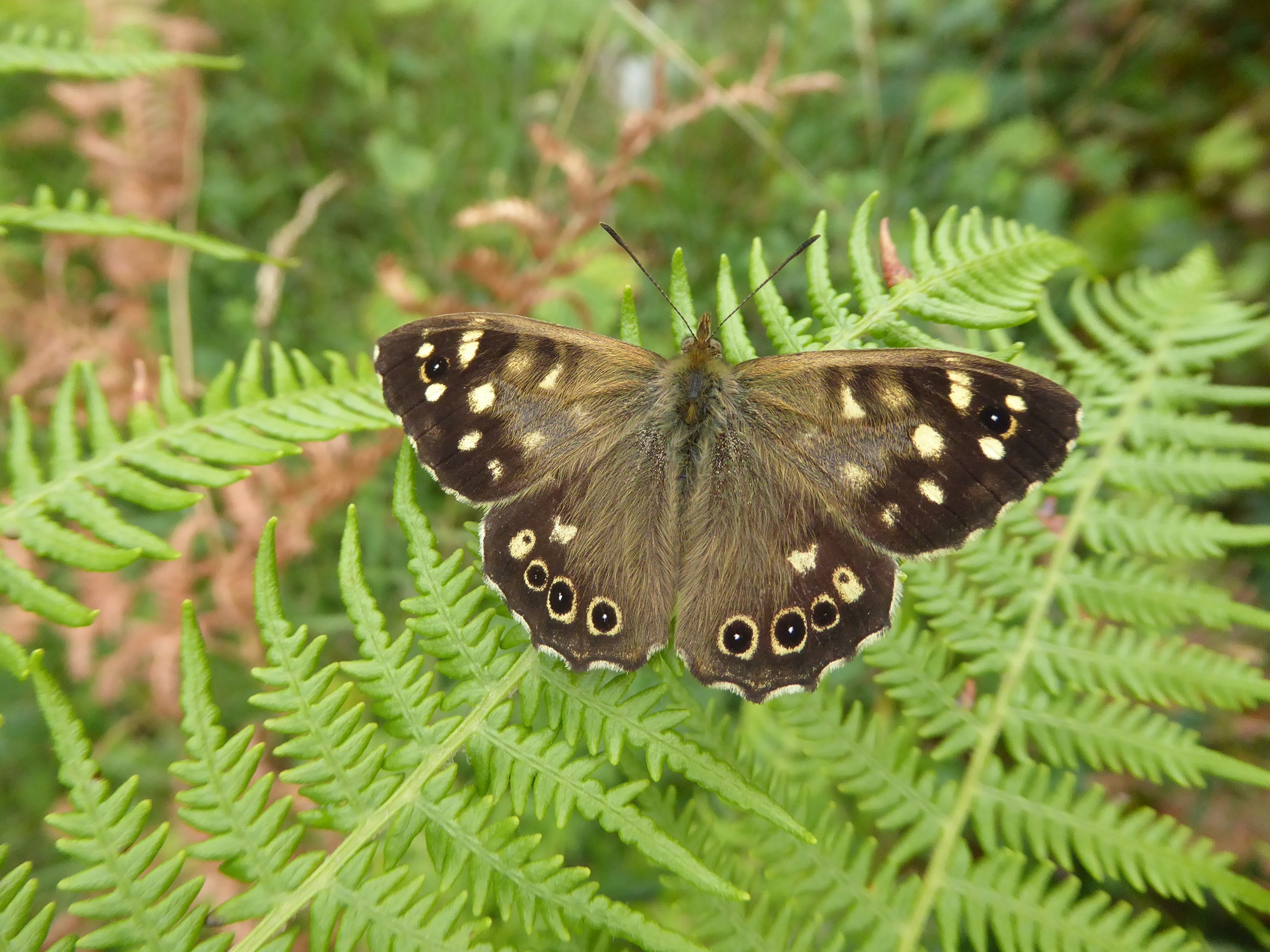 Speckled Wood male second generation, August 13th 2018. (Photo taken at Knockaunroe, Clare). Compare the appearance of this summer specimen with the first image, taken in spring. of a spring Speckled Wood. Photo J. Harding.
Speckled Wood male second generation, August 13th 2018. (Photo taken at Knockaunroe, Clare). Compare the appearance of this summer specimen with the first image, taken in spring. of a spring Speckled Wood. Photo J. Harding.
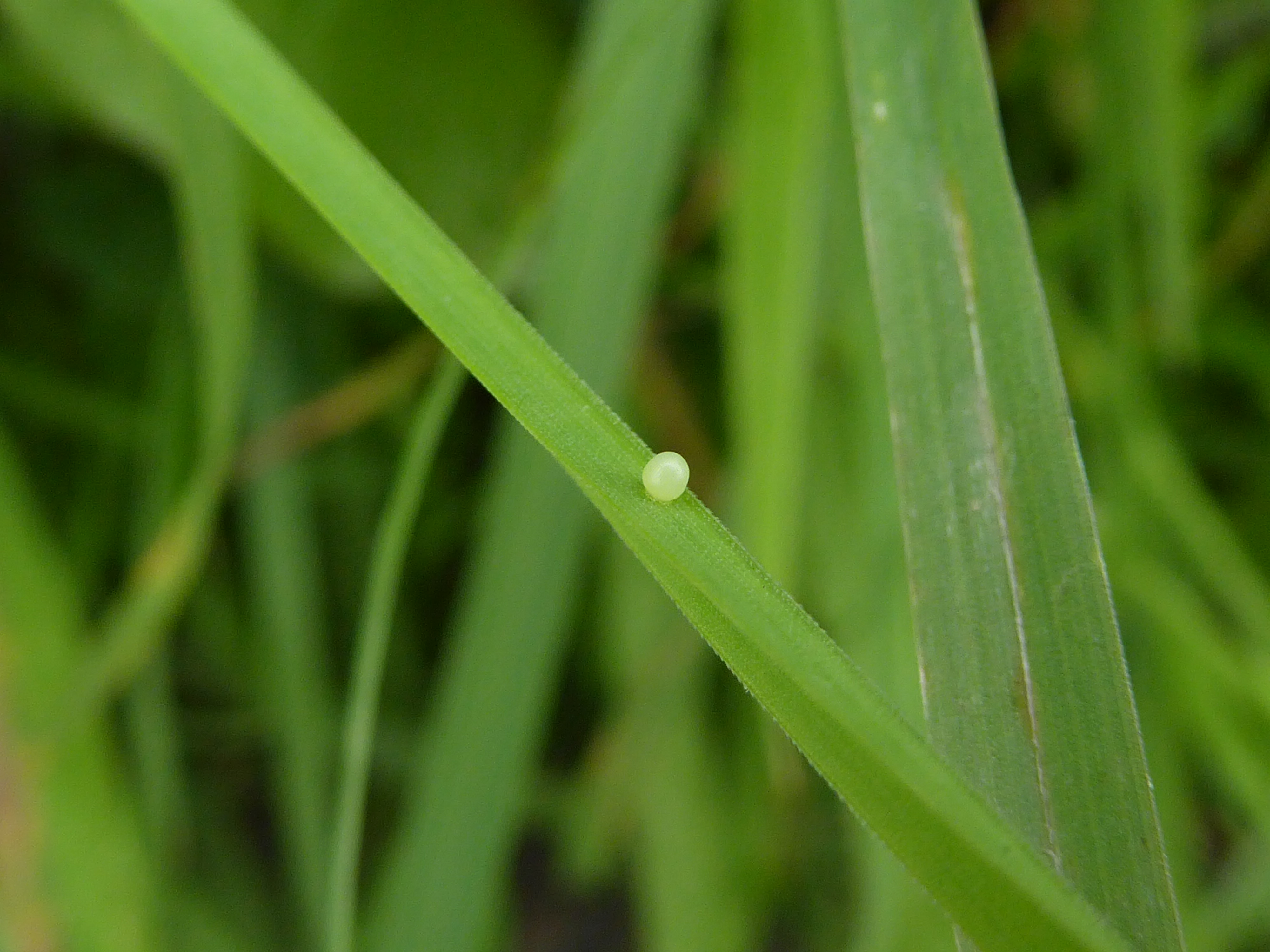 A Speckled Wood egg on Yorkshire Fog, June 28th 2013. Photo J. Harding.
A Speckled Wood egg on Yorkshire Fog, June 28th 2013. Photo J. Harding.
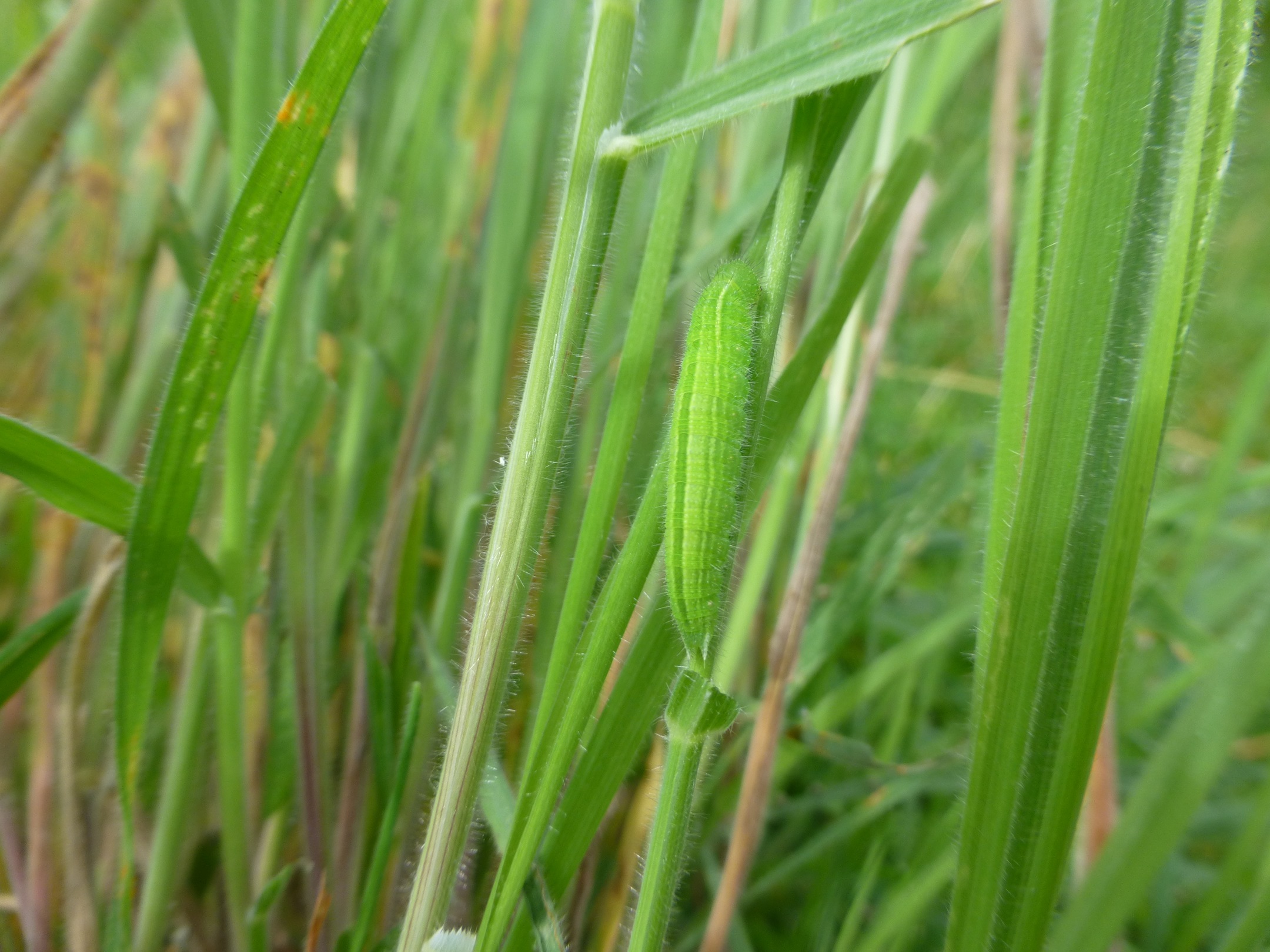 Speckled Wood larva fourth instar, August 7th 2013. Photo J. Harding.
Speckled Wood larva fourth instar, August 7th 2013. Photo J. Harding.
On July 21st, the larvae measured 7mm, showing rapid growth on the lush foodplant. On July 26th, the larvae were 13mm. The warm temperatures (night-time temperatures over the month ranged from 14-18 Celsius while temperatures during the day ranged from 19-30 Celsius) and the high quality of the hostplant assisted rapid development. The larvae fed during the day and night, and night feeding was also occurring during the winter in 2023-2024.
On August 6th, larvae measured from 17mm to 20mm, but one larva measured 25mm. On August 9th, one larva was found in the pre-pupal state, suspended head down from a pad on the anal claspers, beneath a grass blade. There are four instars. Pupation occurred that day, following a larval stage of at least 28 days. The pupa measures 12-13mm in length. The fresh pupa is pale green. It has two projections on the head, like the Peacock pupa. A dark green line runs along the ventral surface from the thorax to the end of the abdomen. The thorax is paler green than the head. Seven pupations occurred on August 14th. The remaining larva pupated on August 18th.
On August 26th, a male emerged in calm overcast conditions with the temperature at 18 Celsius. More males emerged the following day. Just before hatching, the pupa is slate blue in colour and cream speckles can be seen through the wing cases. The pupal stage lasted c.13-17 days. The egg to adult period for the first butterfly to emerge was 59 days.
It must be borne in mind that over-wintering caterpillars studied during 2023-2024 did not develop at the rapid rates just described here (which is to be expected during the colder times of the year) with vastly different growth rates between sibling caterpillars.
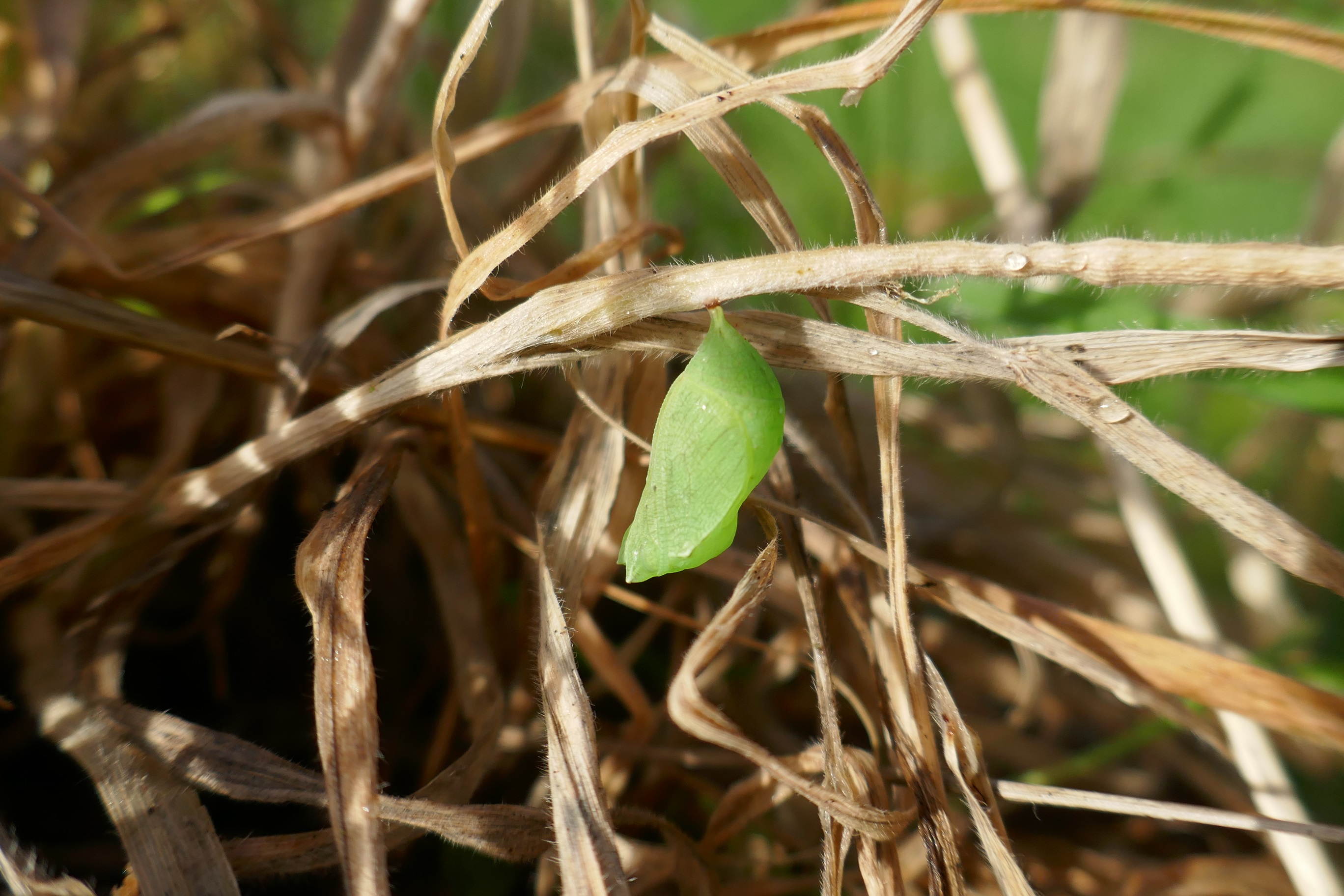 Speckled Wood pupa, December 10th 2023. Photo J. Harding.
Speckled Wood pupa, December 10th 2023. Photo J. Harding.
This butterfly occurs in most of Britain and Europe but is absent from most of Scandinavia and Northern Russia. It is well distributed throughout its habitats in Ireland. The abundance of its habitat means that the Speckled Wood is very common in Ireland and appears to be present almost throughout the country apart from northwest and west Mayo. This general countryside butterfly will occur in rural and suburban gardens.
Its status on the Red List of Irish Butterflies 2010 is Least Concern. The Irish Butterfly Monitoring Scheme data found a -40% decline over the period 2012-2021, a ‘Moderate Decline’ (Judge and Lysaght 2021). This contrasts with data from the monitoring schemes in the UK, where the Speckled Wood has increased in abundance by 108% and in distribution by 53% during the period 1976-2019 and 1974-2019 respectively. While the situation is less positive in Ireland, the -40% decline is the lowest decline figure of all the members of the ‘Brown’ family of butterflies.
Despite this decline, it is the most reported butterfly to the National Biodiversity Data Centre, with over 54,000 records from 2010-2021. Heavy strimming of roadside grasses during March to October will reduce its breeding habitat, albeit temporarily.
Removing vegetation or severe cutting near hedgerows on farms will also reduce the population. Allowing wild grasses bordering scrub, hedges and woods to develop will help this butterfly to flourish. If we cannot look after such an undemanding butterfly, what does that say about us?
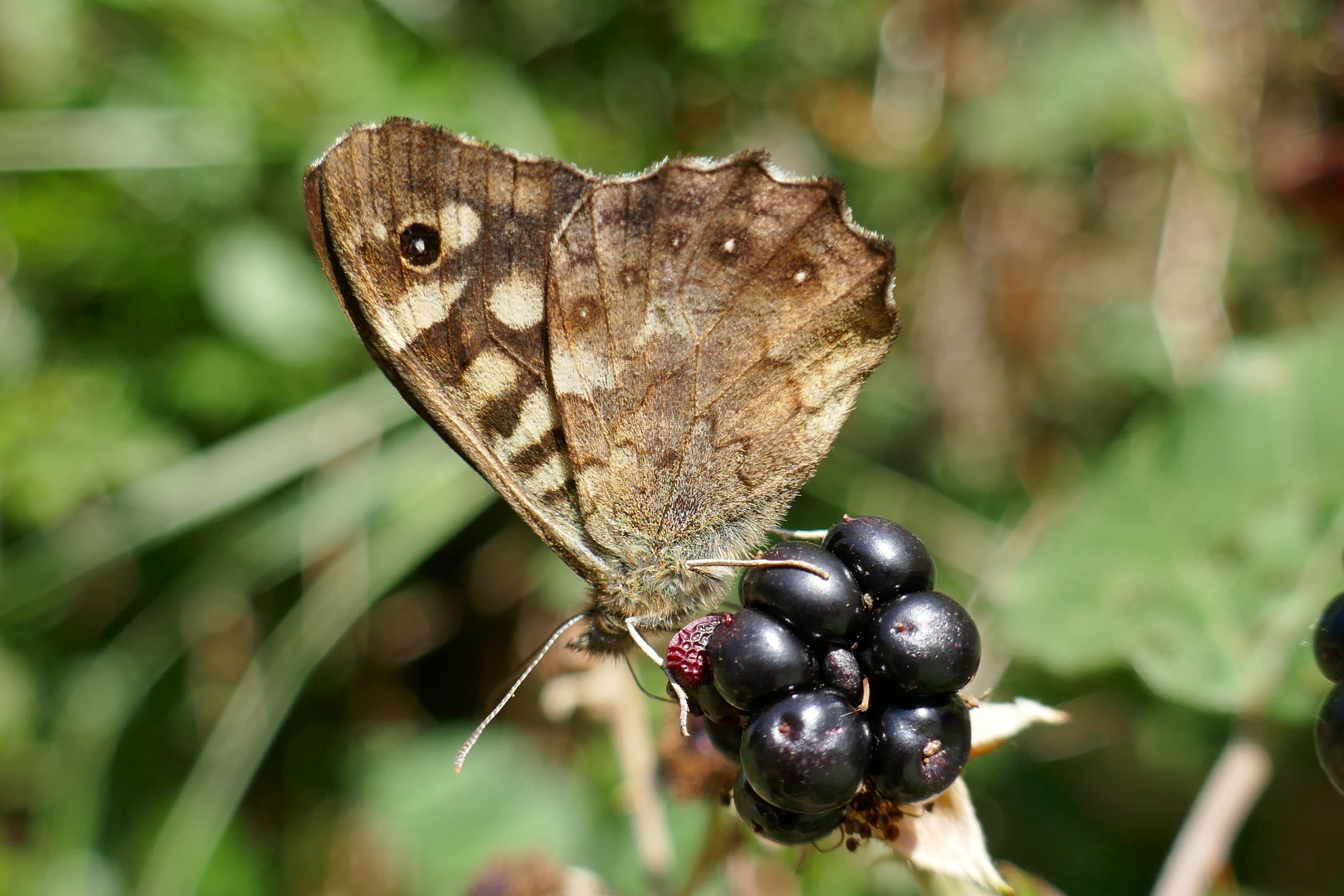 Speckled Wood feeding on blackberry, September 1st 2023. Photo J. Harding.
Speckled Wood feeding on blackberry, September 1st 2023. Photo J. Harding.
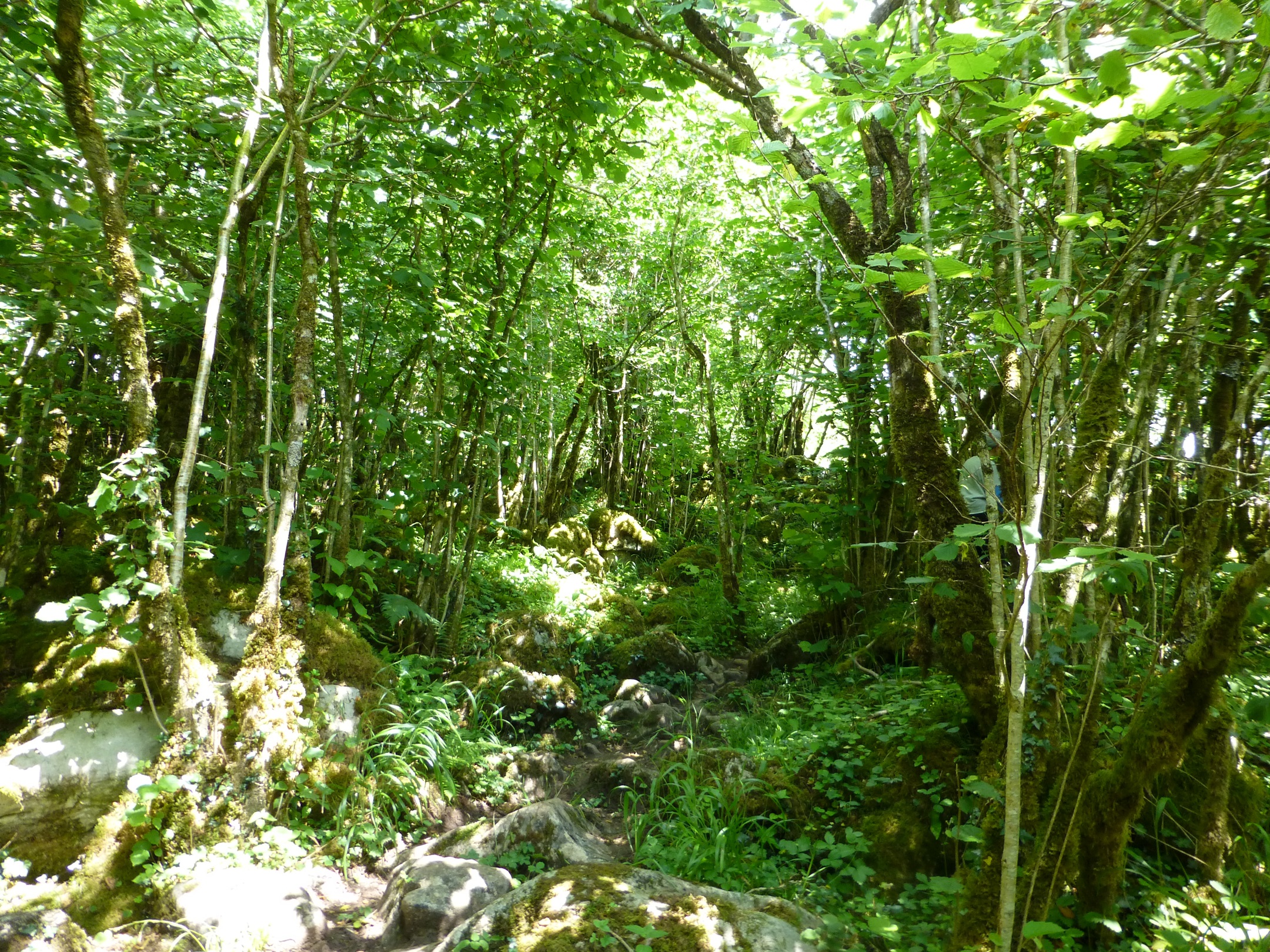 Typical Speckled Wood breeding habitat in native woodland. The grass in the photograph is False Brome Brachypodium sylvaticum, a major grass species used in wooded habitats. Photo J. Harding.
Typical Speckled Wood breeding habitat in native woodland. The grass in the photograph is False Brome Brachypodium sylvaticum, a major grass species used in wooded habitats. Photo J. Harding.
References
Davies, N (1978) Territorial defence in the speckled wood butterfly (Pararge aegeria): The resident always wins. Animal Behaviour, Volume: 26, Edward Grey Institute, Department of Zoology, Oxford. pp. 138-147.
Eeles, P. (2019) Life Cycles of British & Irish Butterflies. Pisces Publications, Berkshire.
Emmet, A.M. and Heath, J. (eds) (1990) The Butterflies of Great Britain and Ireland. 7 (1). Harley Books, Colchester.
Fox R, Dennis EB, Purdy KM, Middlebrook I, Roy DB, Noble DG, Botham MS & Bourn NAD (2023) The State of the UK’s Butterflies 2022.Butterfly Conservation, Wareham, UK.
Thomas, J. and Lewington, R. (2014) The Butterflies of Britain and Ireland. (Revised edition) British Wildlife Publishing, Dorset.
WHY ARE IRELAND’S BUTTERFLIES DECLINING?
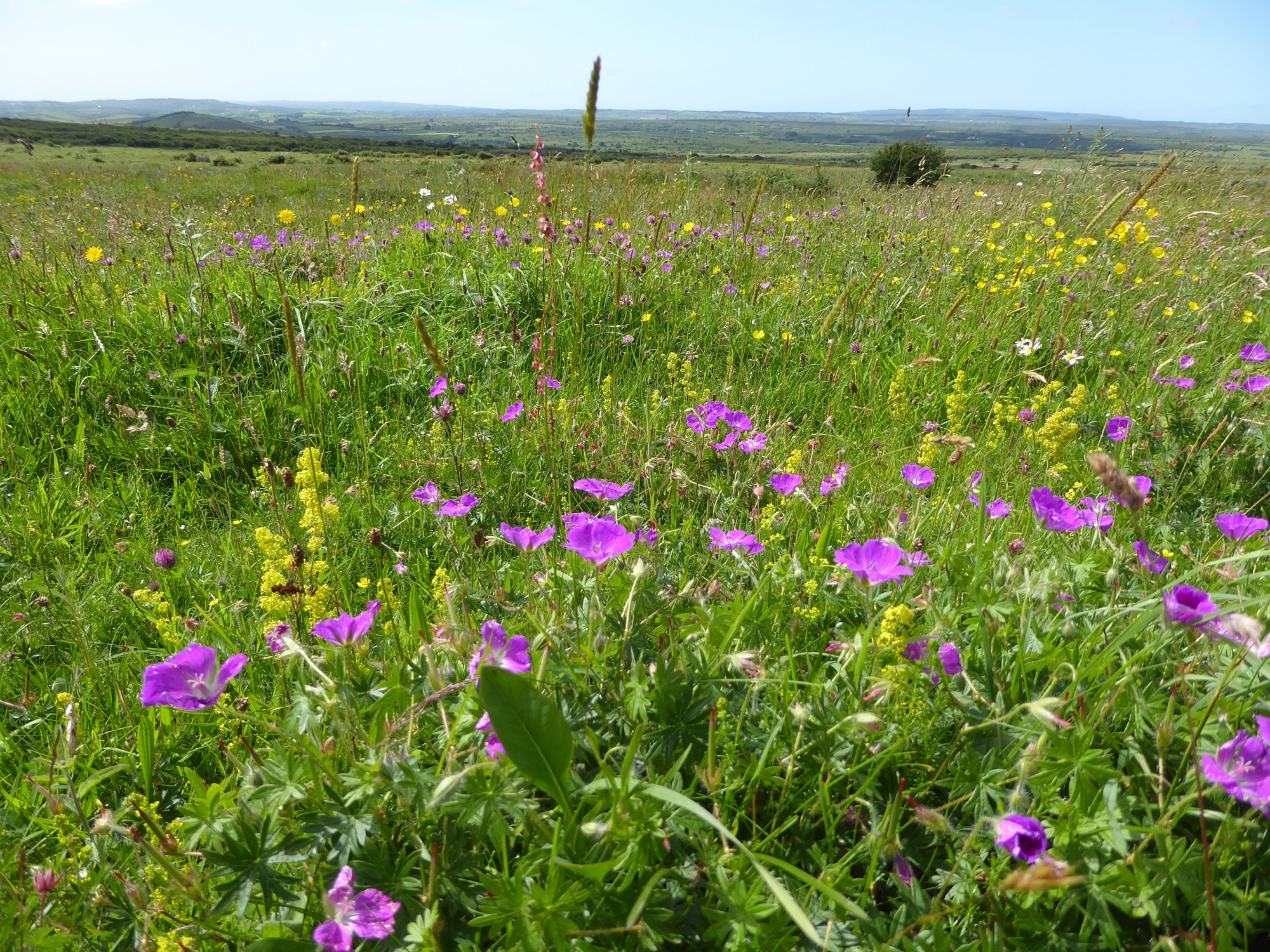 Flower-rich dry calcareous grassland, a habitat rich in butterflies, is disappearing in Ireland. Photo J. Harding.
Flower-rich dry calcareous grassland, a habitat rich in butterflies, is disappearing in Ireland. Photo J. Harding.
Most long-term observers of Ireland’s butterflies will say that they see far fewer butterflies than they did in their youth. Nostalgic reminiscing colours our impressions when we project our impressions of contemporary collapse against our memories of endless sunny days, frothy, fragrant meadows and billowing clouds of butterflies. It is understood that butterfly abundance has declined, especially in northern Europe, and studies have investigated the causes.
According to research carried out in Britain, the Netherlands, Germany, and Denmark, and a Europe-wide study of grassland butterflies that includes data from the National Biodiversity Data Centre in Ireland the factors causing the decline of butterflies fall into three main categories (Van Swaay et al. 2022). These are habitat loss/degradation, chemical pollution, and climate change (the latter having both positive and negative effects, depending on the species and region). By far the most evident and serious threat to Ireland’s butterflies is habitat loss/degradation with some of the habitat loss arising from habitat destruction.
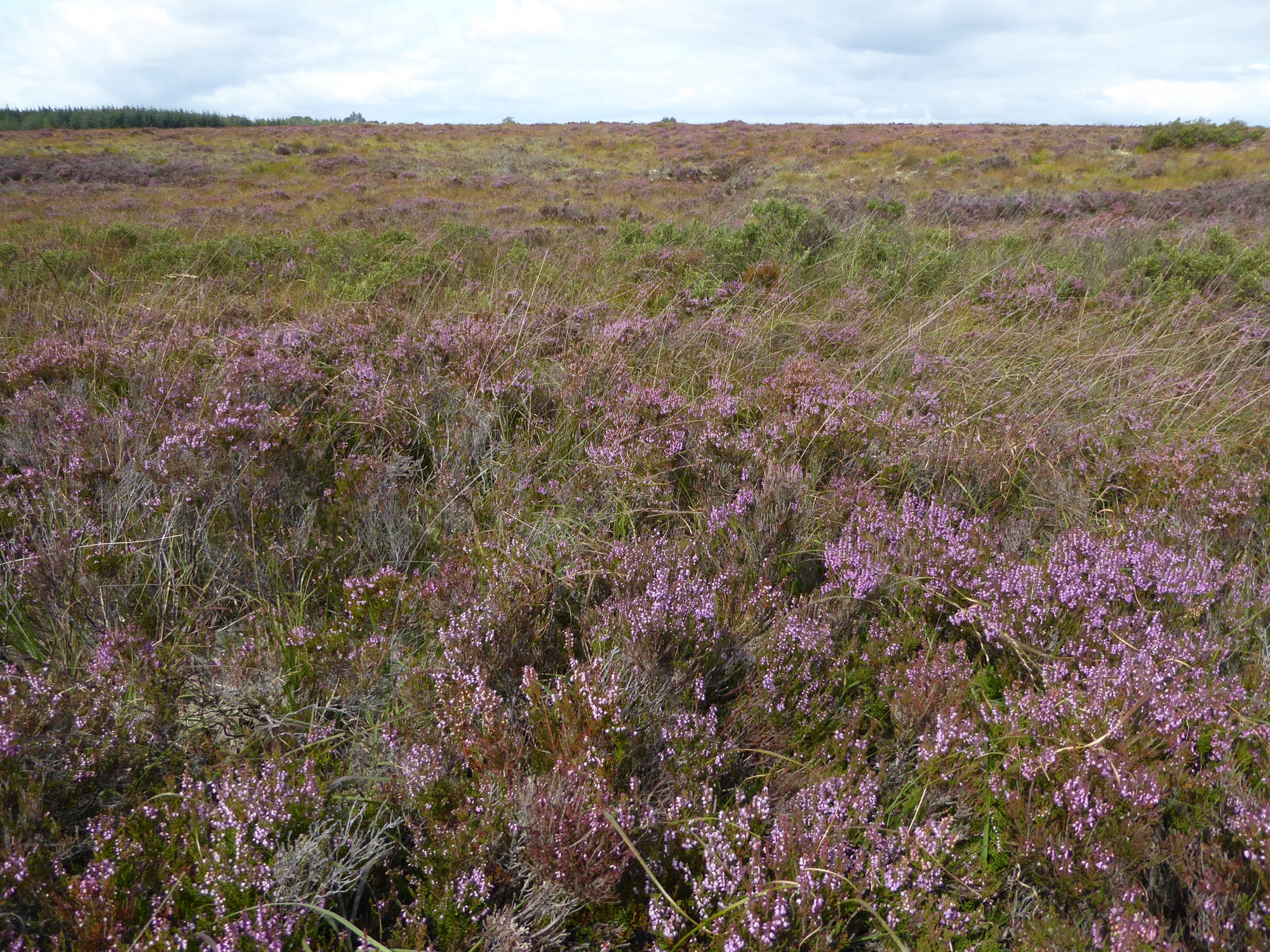 Bellanagare Bog SAC, Roscommon. This bog contains elements of raised bog and blanket bog. Photo J. Harding.
Bellanagare Bog SAC, Roscommon. This bog contains elements of raised bog and blanket bog. Photo J. Harding.
Bogs, fens and associated wet grasslands are important butterfly habitats. The original area of raised bogs in the Republic of Ireland was approximately 311,000 ha and the original area of blanket bogs was approximately 774,000 ha. Fens were once common in Ireland, but they have been reclaimed except for some 20,000 ha of conservation importance. It has been estimated that only 10% of the original raised bog and 28% of the original blanket peatland resource are deemed suitable for conservation (which thus comprise approximately 248,000 ha, mostly blanket bog). Therefore about 77% of the Republic of Ireland’s bogs have been destroyed (National Peatlands Strategy). Remarkably the destruction of Ireland’s bogs accelerated after the Habitats Directive 1992. Peat products peaked at 58% of total primary energy production in 2003. By 2021 they had fallen to 4% of this total, after Bord na Móna ceased peat extraction in 2020 (CSO 2022). Turf-cutting and the commercial exploitation of raised bogs by private companies extracting peat for compost, mushroom casings and bedding continues to erode our remaining peatland habitats.
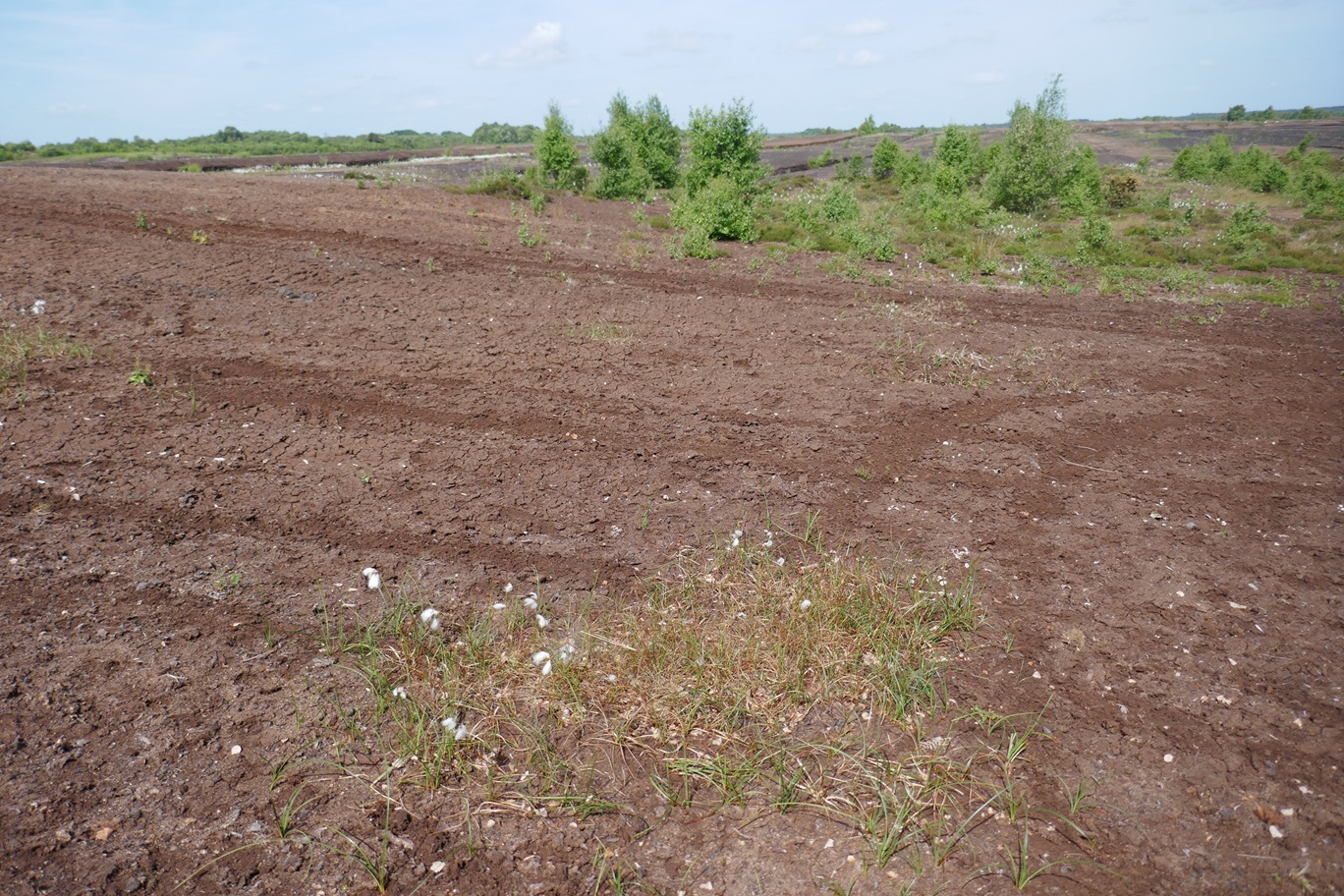 A damaged bog in County Westmeath, May 2023. Photo J. Harding.
A damaged bog in County Westmeath, May 2023. Photo J. Harding.
Afforestation, mainly with non-native conifers also negatively affects habitats; bogs, wet heath and grassland are damaged when afforestation occurs. The area under forest increased from 7% in 1990 to 11% in 2020 (CSO 2022). This is expected to reach 18% in 2027 (European Commission 2023). While new habitats can emerge after peat extraction, species that depend on bogs are lost.
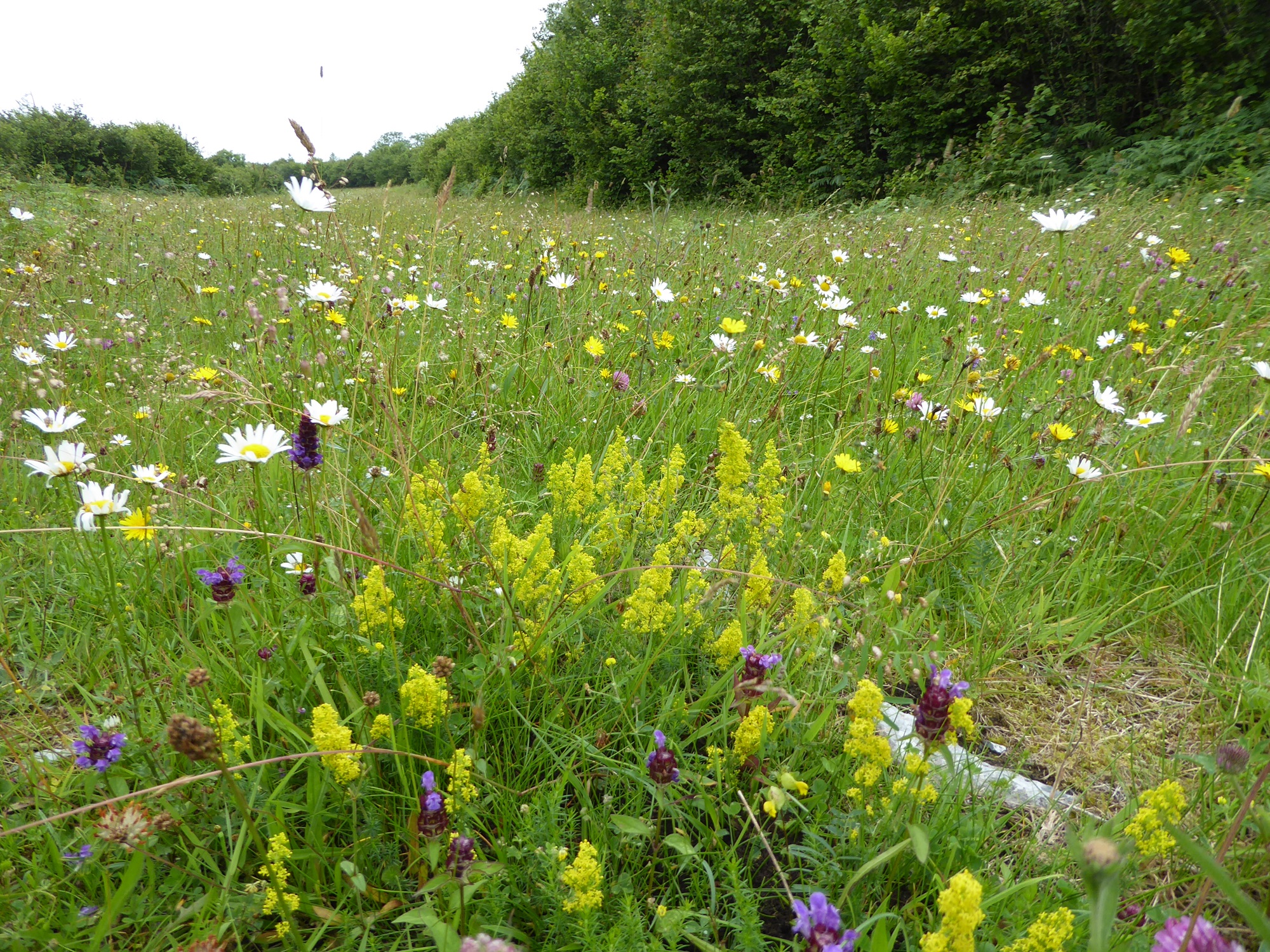 This semi-natural grassland at Knockaunroe, County Clare was at risk of destruction in the early 1990s. Photo J. Harding.
This semi-natural grassland at Knockaunroe, County Clare was at risk of destruction in the early 1990s. Photo J. Harding.
Ireland has lost 30% of its semi-natural grasslands in the past decade and more than half of all the country’s native plants are in decline (4th National Biodiversity Action Plan 2023–2030). Reseeding, sowing of crops and fertiliser use have eliminated much of the biodiversity of most of Ireland’s semi-natural grasslands. This is known as agricultural intensification. About 60% of the total land in the Republic of Ireland is used for grassland, most of it fertilised; in Northern Ireland, the figure for grassland is 79%. About 75% of Northern Ireland’s land is used for agriculture, mostly for meat and dairy. Using land for livestock requires more land, water and chemicals than growing crops like potatoes, carrots and peas. Lime is the most used chemical, while nitrates are also heavily used; the sale of nitrogenous fertilisers in Ireland increased by 40% between 1981 and 2020. Ireland had the tenth highest rate of fertiliser sales among the 27 EU Member States in 2020 at 85 tonnes per 1,000 hectares of agricultural land (CSO 2022). These inputs reduce plant diversity in grasslands, bringing the loss of nectar and larval foodplant resources for many of our butterflies and other invertebrate groups. In north-western Europe, the intensification of farming is the most important threat to grassland butterflies (Van Swaay 2022).
The loss of most of Ireland’s semi-natural habitats, especially since 1980, means that the remaining areas are often small and too distant from other areas of suitable habitat to be reached by butterflies, which means that local extinctions, which occur in some species, become permanent. This is known as habitat fragmentation, which creates severe problems for colonial butterflies that are not highly mobile.
Even in protected areas, problems exist. In 2020, Ireland had 10% of its total land area designated as terrestrial Special Areas of Conservation (SACs) under the EU Habitats Directive, the seventh lowest rate in the EU27 (CSO 2022). Despite this legal protection, butterflies and other species are being lost from protected sites, in Ireland (Harding 2021) and elsewhere in Europe (Bjerregård et al. 2023).
A clear insight into the changes to grassland habitats that reduce butterfly populations was obtained from an examination by Butterfly Conservation Europe of Article 17 reports by EU member states to the EU Commission. The Article 17 reports describe the prevalence of threats to grasslands. These reports on the conservation status of the habitats and species covered by the Habitats Directive cover the habitats and species in the whole territory of the member state concerned, not just those within the protected sites. The reports show that abandonment of grassland management (no grazing or cutting of vegetation) is the chief threat, with 385 mentions in the reports.
The second most prevalent threat is mowing or cutting of grasslands at 254 mentions, followed by overgrazing (240), natural succession resulting in a change in the species present (148), use of chemicals to protect certain agricultural plants (111), afforestation (110), conversion from one type of farming use to another (87), conversion from other land uses to housing, settlement and recreational use (78), use of synthetic fertiliser on farmland (76), collection of wild plants and animals (72) and conversion to other forest types including monocultures (70). The main problem lies with the condition of habitats. This information is derived from EU member state reports, so the causes of the decline and the improvement steps needed are known (Butterfly Conservation Europe 2022).
Chemical pollution is another very important cause of butterfly declines and is linked with climate change. Some chemicals are applied to kill insects and these impact non-target insects that do not attack crops. A group of insecticides that has attracted publicity is the neonicotinoids. These are absorbed into the plant tissues and find their way into nectar and pollen and have been investigated as responsible for the decline in bee populations. These are neurotoxins and it appears they affect bees; effects include difficulty navigating, learning, and foraging, suppressed immune response, lower sperm viability, shortened lifespans of queens, and reproduction (Hladik et al. 2018). Research on the impact on butterflies is limited, although the chemicals are known to kill Monarch Danaus plexippus butterflies in the laboratory, and lethal quantities have been found in host plants in the field (Warren et al. 2021). Although some of these chemicals have been banned, their persistence in the environment makes them a lasting influence on insect populations, including in areas adjoining the application zones.
The deposition of nitrogen from the atmosphere is another important threat to butterflies. The chief sources are the ammonia produced by intensive livestock rearing and the emission of nitrogen oxides from vehicles. A German study by Habel et al. (2015) entitled ‘Butterfly community shifts over two centuries’ looked at the impact of atmospheric nitrogen loads and climate change over the period 1840-2013. The study found that high rates of atmospheric nitrogen deposition (from exhaust emissions, the burning of fossil fuels, wood, industrial incineration and the application of nitrate fertilisers) change nutrient-poor ecosystems, resulting in the replacement of certain plants in such habitats with other plants that thrive on soils enriched with nitrogen. This results in butterflies that depend on nutrient-poor habitats, such as limestone grassland and heathland, disappearing, leaving a smaller number of butterfly and moth species that are adapted to plants containing high nitrogen levels.
The study further suggests that atmospheric nitrogen deposition in combination with climate change is driving population changes in butterflies. While habitat generalists (like the Peacock Aglais io) benefited from increasing temperatures, habitat specialists have been negatively affected by increasing temperatures and rainfall. These effects may be explained by increased vegetation growth rates triggered by the combination of increased moisture, temperature, and atmospheric nitrogen. Greatly increased vegetation growth may also explain the paradoxical situation that which heat-loving species are declining in response to increased temperatures. However, higher vegetation growth rates, fostered by the combination of increasing plant nutrients, precipitation, and higher temperatures may produce a cooler and more humid microclimate close to the soil and within the vegetation. This environment just above the soil is of particular importance in the development of the larvae of many butterfly species, including the Small Heath Coenonympha pamphilus and Wall Brown Lasiommata megera.
In another study, the rising concentrations of CO2 have been found to elongate the development times of the Small Heath caterpillar, probably exposing the species to increased risks such as predation and emerging out of sync with resource availability (Eeles 2019). The Small Heath is a widespread butterfly across Ireland and Europe and attention is mostly focused on much less widespread species that are judged to require special protection. However, the decline in widespread grassland butterflies should set the alarm ringing, the proverbial canary in the mine. Unless the drivers of climate change including atmospheric pollution are tackled, no amount of site protection will save our more sensitive species.
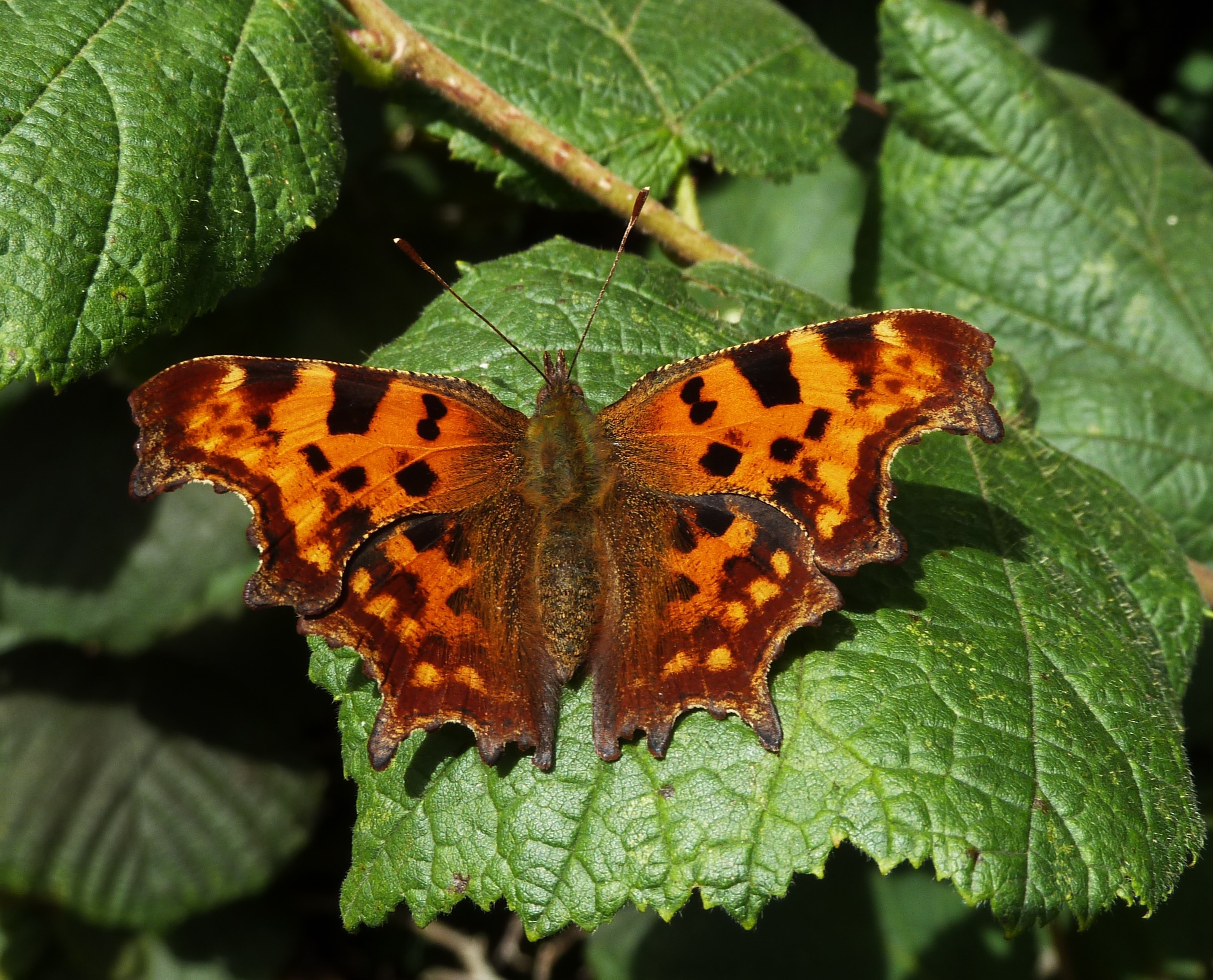 The Comma is one of the big climate warming winners in Ireland. Photo J. Harding.
The Comma is one of the big climate warming winners in Ireland. Photo J. Harding.
Climate change has complex effects on butterflies, benefiting a species in some areas and proving detrimental to it elsewhere. Thus, a species on the edge of its climatic range in central or northern Europe may be able, due to increasing temperatures, to expand northwards. The Comma Polygonia c-album, a recent colonist, is currently extending its range northwards in Ireland, as are some moth species.
However, cold-adapted species, like the Green-veined White Artogeia napi, may continue to decline, especially if our summers become hotter and drier as predicted. The frequency of extreme weather events, such as droughts and floods is expected to increase as the climate changes. Large declines were recorded in the UK in the populations of some butterflies following the drought in 1976. Severe flooding hasnegative impacts too and has been observed to drown Marsh Fritillary caterpillars Euphydryas aurinia when it occurs during the summer (J. Harding 2007 pers. com.). These episodes can reduce the viability of populations of sedentary butterflies, especially where habitats are fragmented.
The longer summers may influence some butterfly species to produce an additional generation. This might create a developmental trap if the usual cues (such as temperature, foodplant quality) to enter diapause are disrupted, which is suspected to have impacted the Wall Brown in Belgium (Van Dyck 2015). If this happens, a late emerging generation of butterflies might produce offspring which then lack the time to reach a development stage that allows them to survive the winter.
In conclusion, changes in the landscape that impact significantly on Ireland’s butterflies by influencing the habitat available include drainage, reseeding of grassland, scrub clearance, peat extraction, use of fertilisers, insecticides and herbicides, coniferous afforestation, land abandonment, increased urbanisation, industrial development, road building, quarrying, recreational pressure on coastal areas and important semi-natural habitats inland.
Because changes to the landscape that cause habitat loss are regarded as the greatest threat to Ireland’s butterflies, addressing the issues listed here will provide the greatest positive effect. The recent programme to re-wet 33,000 ha of Bord na Móna’s bogs is one positive move. Extending this programme to cover the rest of its 80,000-ha holding, re-wetting other areas of land drained in the past, eliminating the practices that removed our semi-natural grasslands, and reducing stocking rates, is needed.
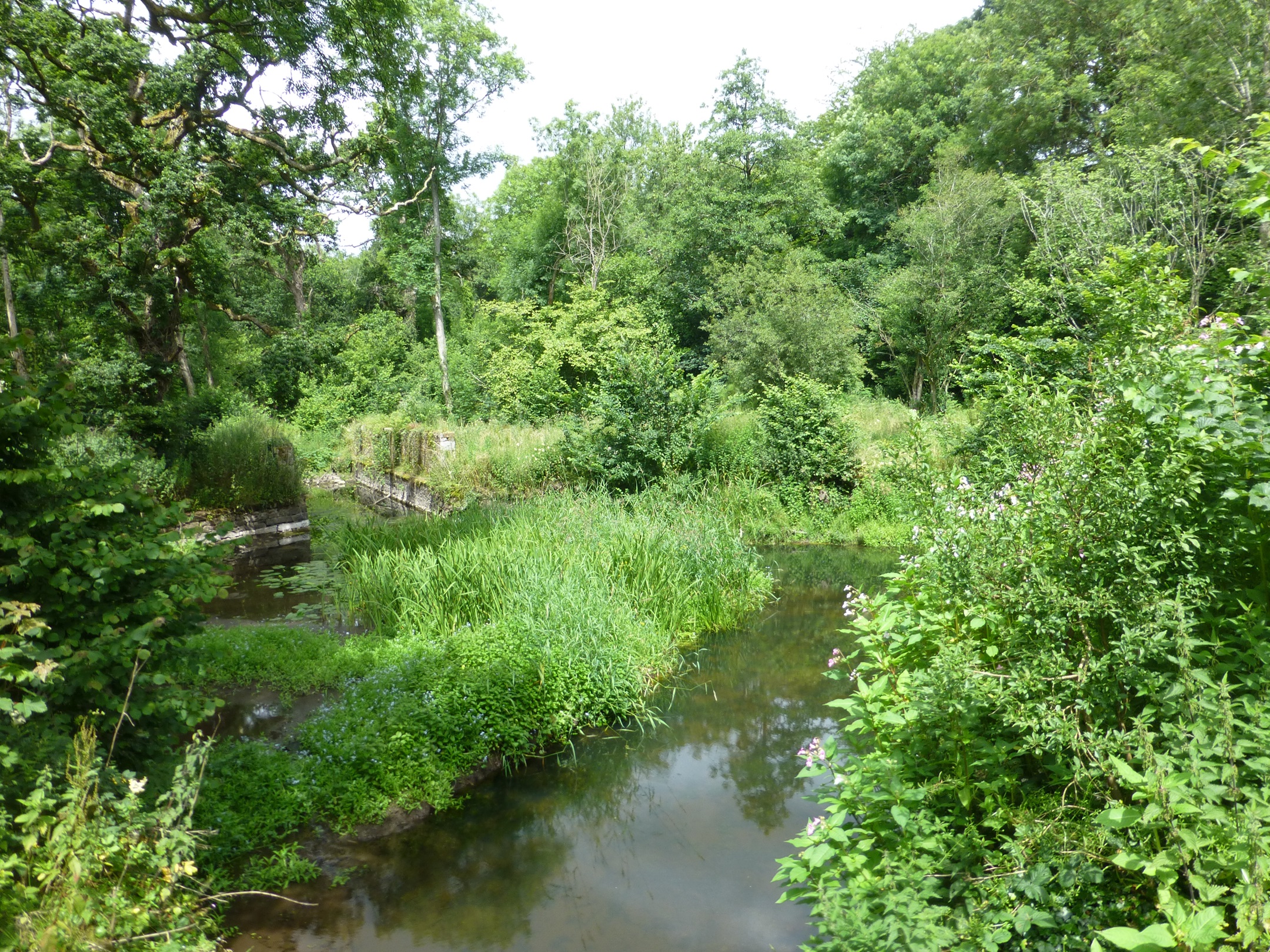 Native woods like this one near the River Barrow in Carlow are now rare in Ireland and need to be extended to repair centuries of damage. Photo J. Harding
Native woods like this one near the River Barrow in Carlow are now rare in Ireland and need to be extended to repair centuries of damage. Photo J. Harding
Encouraging the growth and regeneration of native woods on fertilised soils (mainly through carefully managed rewilding), instead of on biodiverse semi-natural grassland would be a further positive move. Managing hedgerows and our protected sites correctly and tackling alien invasive species will enhance environmental conditions. Using energy derived from clean sources will reduce pollution threats. Allowing naturally occurring vegetation to thrive in our own gardens and community spaces places will help our more widespread species. It is important to state that there is hope, but the realisation of that hope depends on change and action.
References
Bjerregård, E.B., Baastrup-Spohr, L., Markussen, B. & Bruun, H.H. 2023, “Rapid and continuing regional decline of butterflies in eastern Denmark 1993-2019”, Biological conservation, vol. 284, pp. 110208.
Butterfly Conservation Europe 2022 Online at https://www.youtube.com/watch?v=D1PUk__cO_o&t=2175s accessed 27 November 2023
Department of Agriculture, Environment and Rural Affairs 2022 Agricultural Census in Northern Ireland Online at https://www.daera-ni.gov.uk/sites/default/files/publications/daera/Agricultural%20Census%202022%20Publication_1.pdf Accessed 30 November 2023
Eeles, P. (2019) Life Cycles of British & Irish Butterflies. Pisces Publications, Berkshire
European Commission 2023 Online at https://ireland.representation.ec.europa.eu/news-and-events/news/state-aid-commission-approves-eu308-million-irish-scheme-support-investments-afforestation-2023-08-02_en#:~:text=The%20target%20of%20the%20scheme,100%25%20of%20the%20eligible%20costs. accessed 27 November 2023
Environmental Indicators Ireland 2022 Central Statistics Office 2022 https://www.cso.ie/en/releasesandpublications/ep/peii/environmentalindicatorsireland2022/landuse/ accessed 27 November 2023
Friends of the Earth 2023 Food and Farming in Northern Ireland Online at https://friendsoftheearth.uk/latest/food-and-farming-northern-ireland#:~:text=75%25%20of%20Northern%20Ireland’s%20land,over%2080%25%20of%20agricultural%20output. Accessed 30 November 2023
Harding, J.M. (2021) The Irish Butterfly Book A Complete Guide to the Butterflies of Ireland. Privately published, Maynooth.
Hladik, M.L., Main, A.R. & Goulson, D. 2018, “Environmental Risks and Challenges Associated with Neonicotinoid Insecticides”, Environmental science & technology, vol. 52, no. 6, pp. 3329-3335.
Land use and land cover Environmental Protection Agency Online at https://www.epa.ie/our-services/monitoring–assessment/assessment/irelands-environment/land–soil/current-trends-land-and-soil/ accessed 27 November 2023
National Parks & Wildlife Service, 2024. Ireland’s 4th National Biodiversity Action Plan 2023–2030. Available at https://www.gov.ie/en/publication/93973-irelands-4th-national-biodiversity-action-plan-20232030/ (Accessed 29 January 2024)
National Peatlands Strategy Draft 2014 National Parks and Wildlife Service https://www.npws.ie/sites/default/files/general/Final%20National%20Peatlands%20Strategy.pdf accessed 27 November 2023
Van Dyck, H., Bonte, D., Puls, R., Gotthard, K. & Maes, D. 2015, “The lost generation hypothesis: could climate change drive ectotherms into a developmental trap?”, Oikos, vol. 124, no. 1, pp. 54-61.
Van Swaay C.A.M., Dennis, E.B., Schmucki, R., Sevilleja, C.G., Arnberg, H., Åström, S., Balalaikins, M., Barea-Azcón, J.M., Bonelli, S., Botham, M., Cancela, J.P., Collins, S., De Flores, M., Dapporto, L., Dopagne, C., Dziekanska, I., Escobés, R., Faltýnek Fric, Z., Garcia Fernandez, J.M., Fontaine, B., Glogovčan, P., Gracianteparaluceta, A., Harpke, A., Harrower, C., Heliölä, J., Houard, X., Judge, M., Kolev, Z., Komac, B., Kühn, E., Kuussaari, M., Lang, A., Lysaght, L., Maes, D., McGowan, D., Mestdagh, X., Middlebrook, I., Monasterio, Y., Monteiro, E., Munguira, M.L., Musche, M., Olivares, F.J., Õunap, E., Ozden, O., Pavlíčko, A., Pendl, M., Pettersson, L.B., Rákosy, L., Roth, T., Rüdisser, J., Šašić, M., Scalercio, S., Settele, J., Sielezniew, M., Sobczyk-Moran, G., Stefanescu, C., Švitra, G., Szabadfalvi, A., Tiitsaar, A., Titeux, N., Tzirkalli, E., Ubach, A., Verovnik, R., Vray, S., Warren, M.S., Wynhoff, I. & Roy, D.B. 2022, European Grassland Butterfly Indicator 1990-2020 : Technical report.
Warren, M.S., Maes, D., van Swaay, Chris A M, Goffart, P., Van Dyck, H., Bourn, N.A.D., Wynhoff, I., Hoare, D. & Ellis, S. 2021, “The decline of butterflies in Europe: Problems, significance, and possible solutions”, Proceedings of the National Academy of Sciences – PNAS, vol. 118, no. 2.
© of all images lies with the photographers. All photographs © J. Harding unless otherwise stated.
BUTTERFLY CONSERVATION IRELAND ANNUAL REPORT 2023
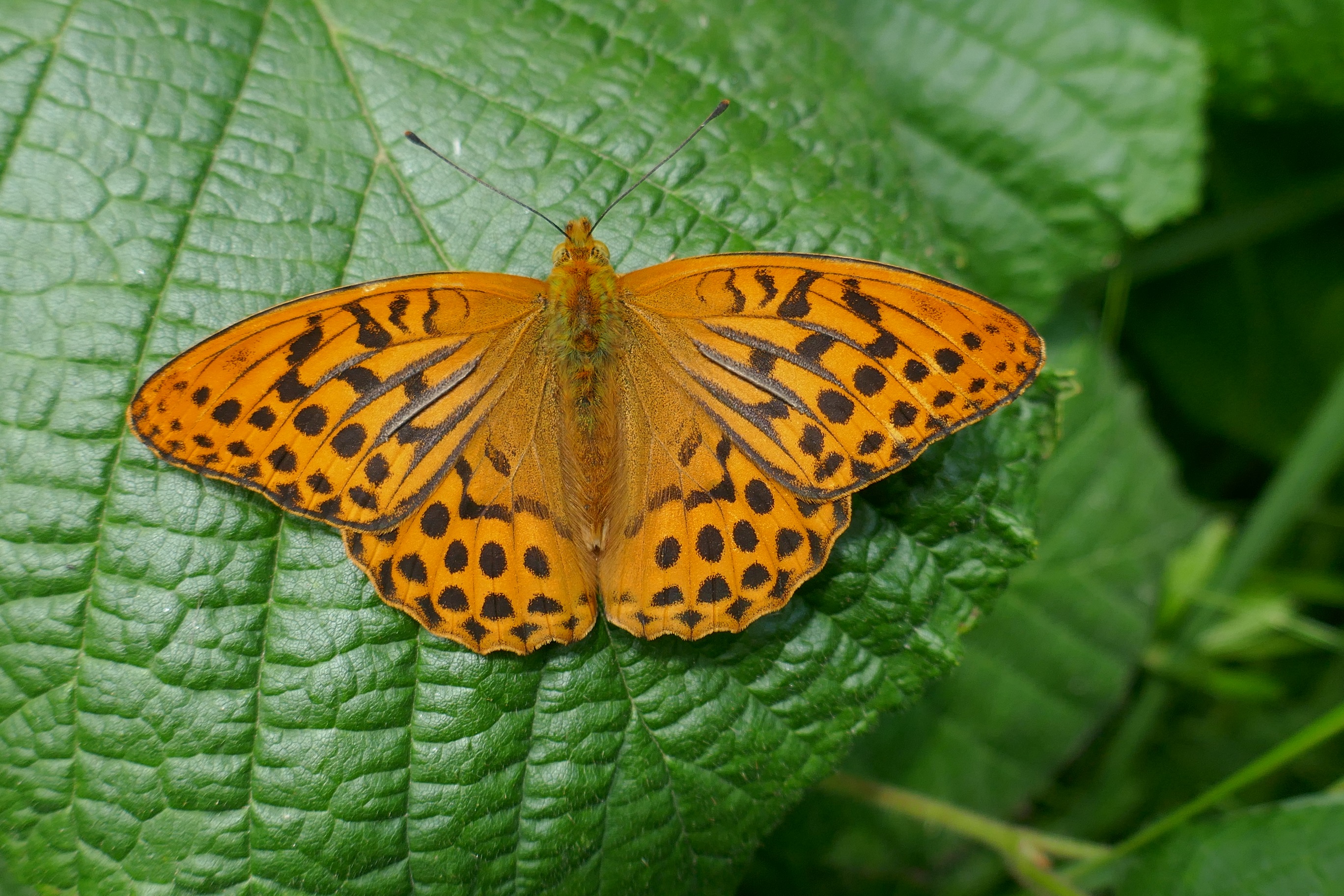 Silver-washed Fritillary, Lullymore, July 2023
Silver-washed Fritillary, Lullymore, July 2023
BUTTERFLY CONSERVATION IRELAND is a company limited by guarantee. Registered in Ireland No. 451571.
BUTTERFLY CONSERVATION IRELAND is a charity. Registered Charity no.: 20069131.
CONTACT DETAILS:
By email: conservation.butterfly@gmail.com
By Post:
Butterfly Conservation Ireland,
Butterfly House,
Pagestown,
Maynooth,
County Kildare.
By phone: 01-6106693
Website: https://butterflyconservation.ie/wp/
Facebook: https://www.facebook.com/ButterflyConservationIreland

